

25 Best Things to Do in Vicenza – Italy’s Hidden Gem (With Maps and Useful Tips)
By Author Rossi Thomson
Posted on Last updated: 4th September 2022
Categories Day Trips in Italy , Lists , Veneto , Vicenza
Here are the best things to do in Vicenza – a small city in Italy that stays firmly off the beaten track.
Halfway between the travel magnets of venice and verona in the northern italian region of veneto , vicenza is rarely given a second thought at the planning stages of an unforgettable italian holiday..
Yet, if you want to have the authentic Italian experience without the tourist crowds and see some of Italy’s most important works of architecture and art, you can do no wrong but pencil a day or two to spend in Vicenza – a city which is a UNESCO World Heritage Site.
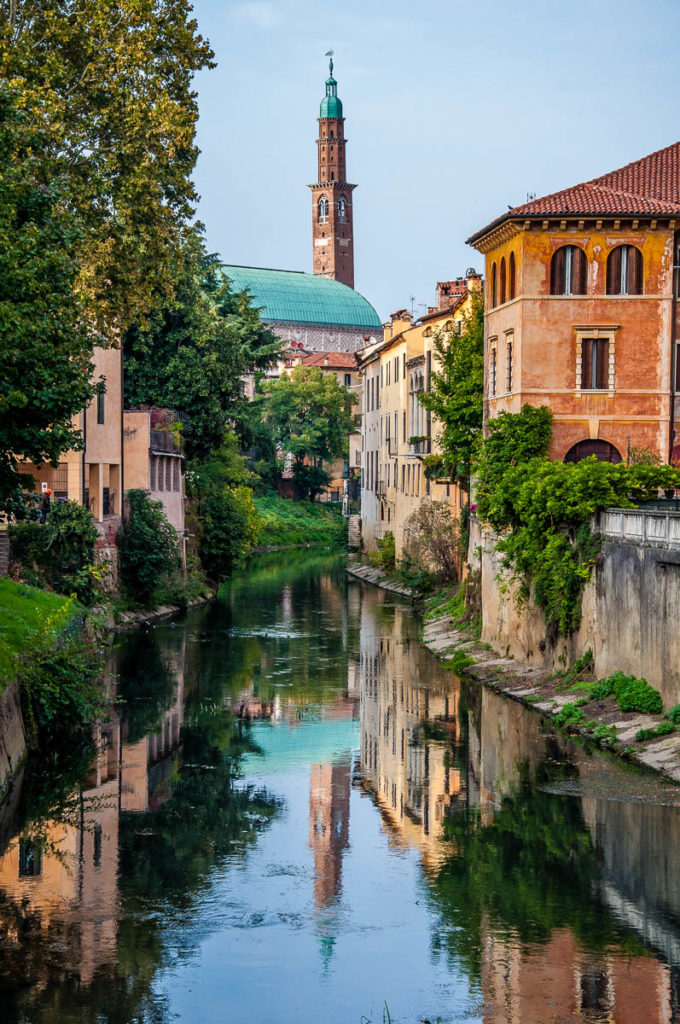
From underground Roman ruins to Renaissance palaces and Baroque frescoes, Vicenza keeps several aces up its sleeve.
Throughout the centuries, the city was home to many illustrious personalities with Andrea Palladio towering above them all. Considered to be one of the most influential architects of the past 500 years, Palladio turned Vicenza into his own architectural playground. He dotted the city with palaces, villas, and buildings and in the process, he created the Palladian architectural style.
Among Palladio’s most famous buildings in and around Vicenza are:
- Basilica Palladiana – originally a medieval town hall that Palladio enveloped with an exquisitely Renaissance shell.
- Villa Capra La Rotonda – one of the world’s most famous buildings that has been partially or fully replicated numerous times in Europe and the United States.
- Teatro Olimpico – the world’s first indoor theatre in masonry. Coincidentally, Teatro Olimpico also has the world’s oldest surviving stage set.
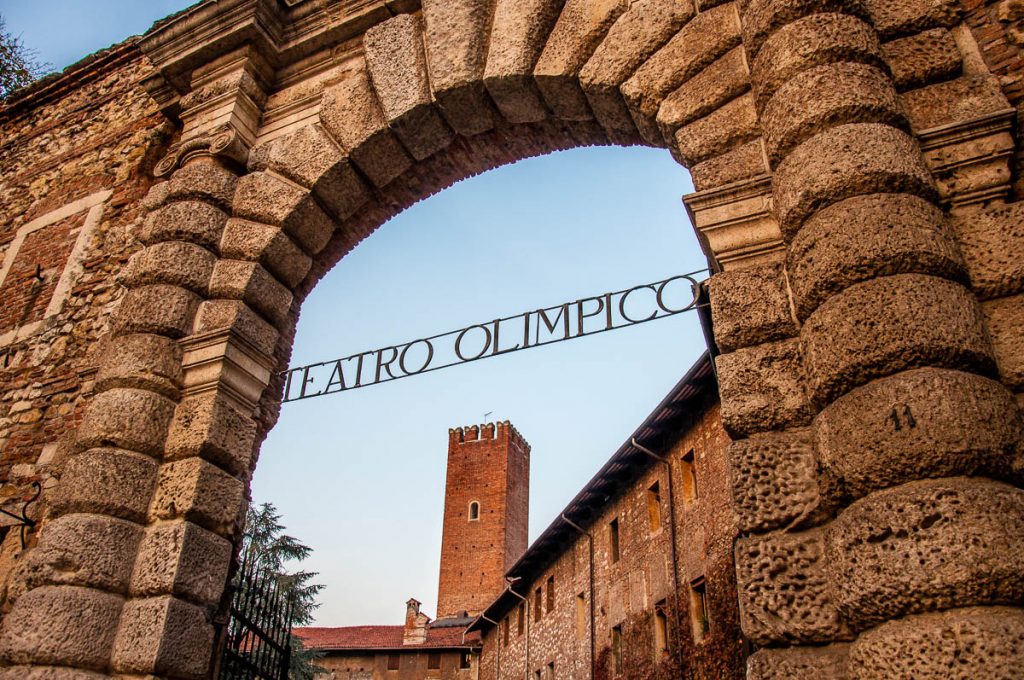
Architecture is not all that you will find in Vicenza, though.
This small Northern Italian city is also one of the world’s largest centres of jewellery design and production with centuries-old goldsmithing traditions at the base of it. Vicenza’s historic jewellery shops are a treasure trove for anyone looking for that unique piece…or ten.
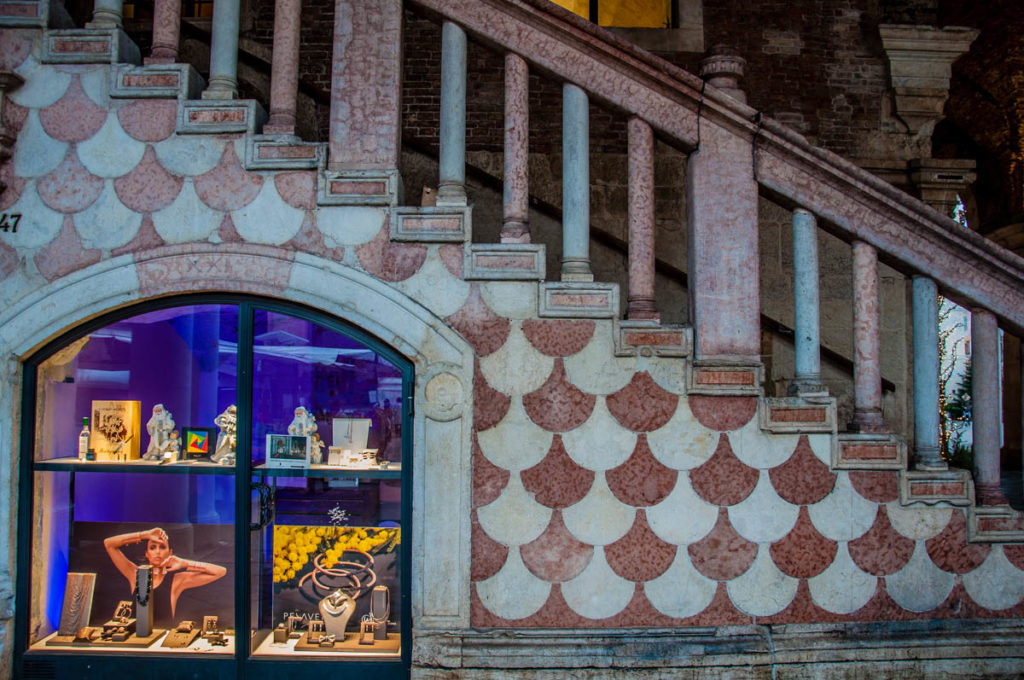
Plus, Vicenza is the birthplace of the original author of Romeo and Juliet , too!
‘What?!’, you may be thinking right now. ‘But the most famous love story of all times was authored by the English playwright William Shakespeare!’, you may want to tell me next.
Well, had it not been for one Luigi da Porto – a nobleman from Vicenza – it is very likely that Shakespeare’s famous play would have never seen the light of day or have broken through yonder window as the Bard would have put it himself.
So, yes, even if you may have never considered Vicenza as a travel destination up to this point, on account of its many sights, stories, and historic personalities, this small Italian city may just suddenly jump to the top of your travel bucket list.
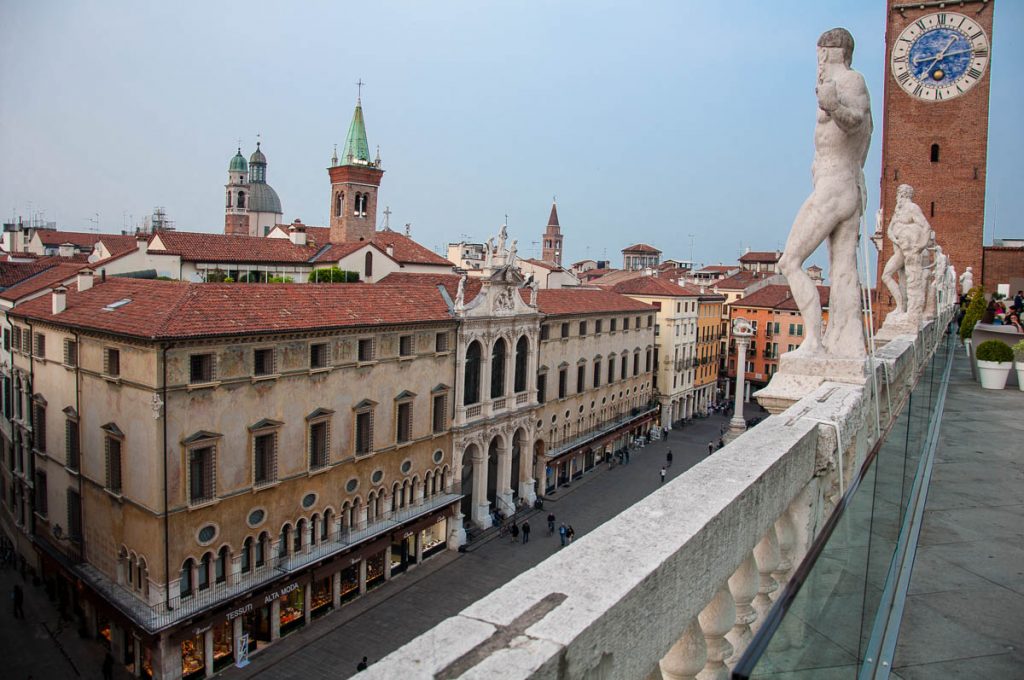
As such and to help you have a wonderful visit to Vicenza, I have written for you below the best things you can do and see here and the best local experiences you can enjoy by yourself, with your family or with your friends.
All the information provided is based on my six years of living in Vicenza and on my constant exploration of this beautiful Italian city, its numerous sights, and its many hidden gems.
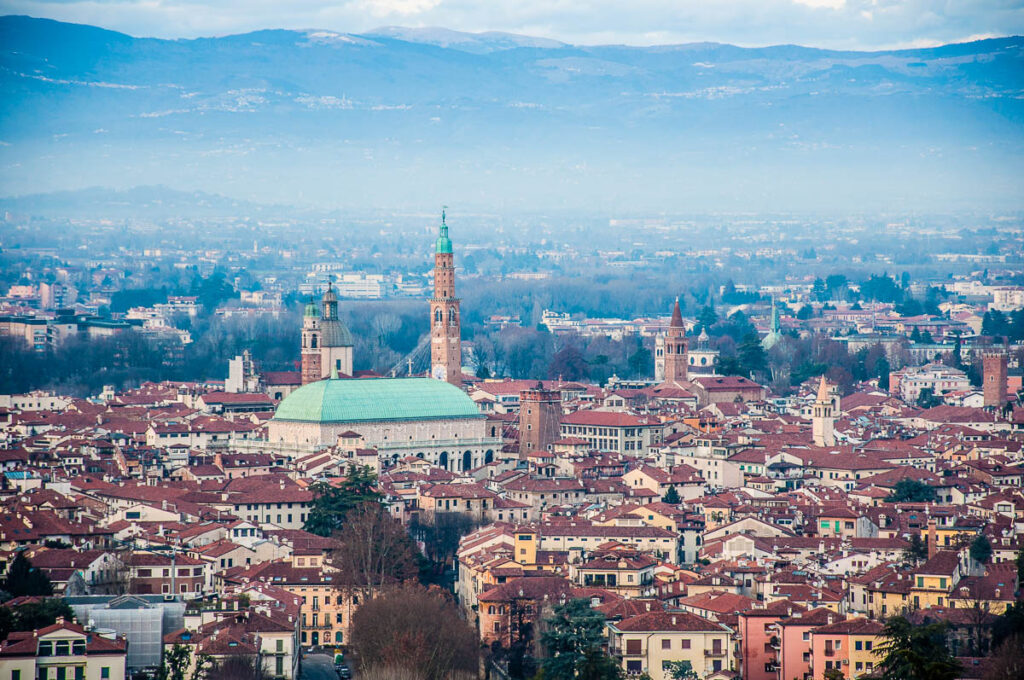
From art and architecture to shopping and eating out, this list of the 25 best things to do in Vicenza, Italy will guide you through the city’s best attractions and best-kept secrets.
Plus, at the end of this blog post, I have included a section with useful maps and practical tips on how to reach Vicenza, where to stay here, and how to navigate the city.
Take full advantage of this blog post for a great Vicenza experience!
25 best things to do in vicenza – italy’s hidden gem (with maps and useful tips).
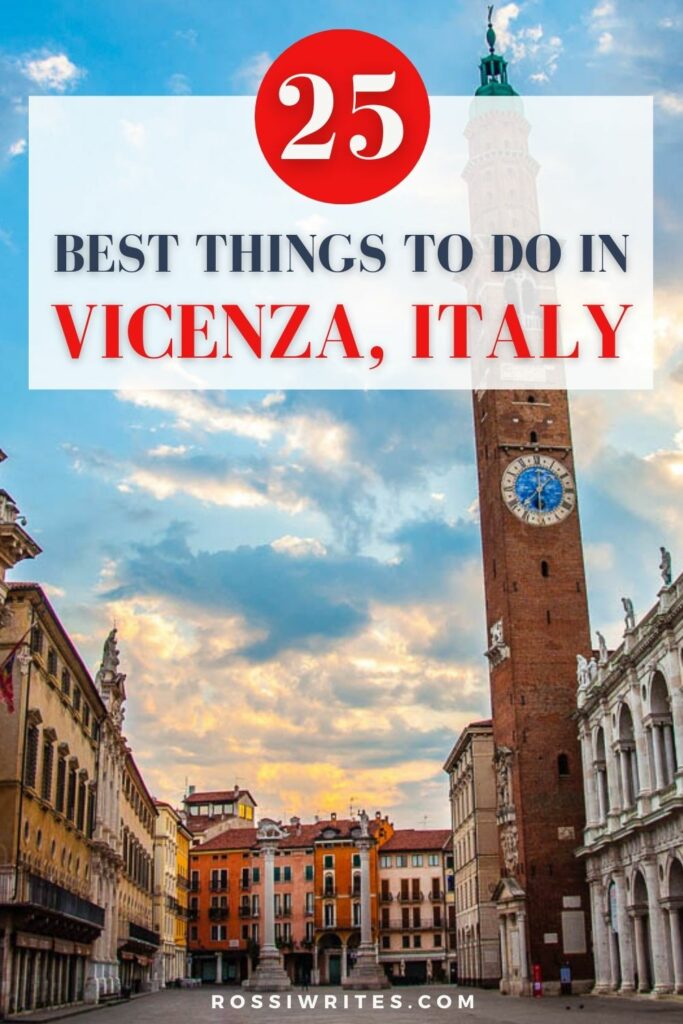
1. Fall in Love with Vicenza’s Basilica Palladiana
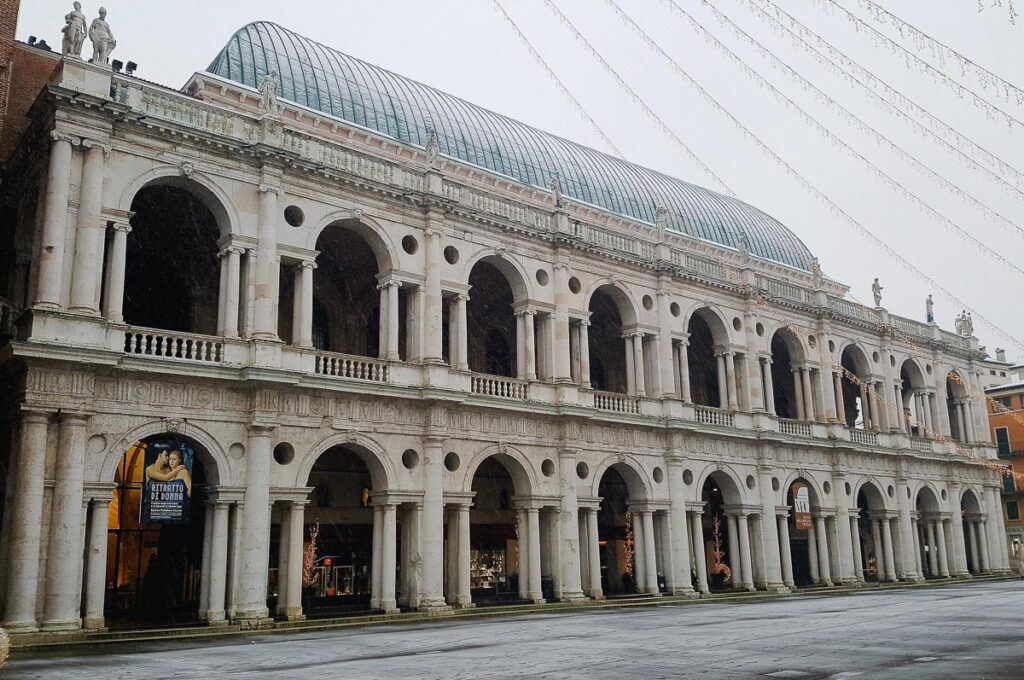
The Basilica Palladiana is Vicenza’s most central and stunning sight. Originally a Gothic building that served as a town hall, its reconstruction in the 16th century was the first major commission of Andrea Palladio – one of the most influential architects in the world for the past 500 years.
Palladio encased the Gothic architecture in a gorgeous Renaissance shell of perfect symmetry and balance. He also named the building a basilica thus evoking the ancient Roman meaning of the term – a large hall used by a court of justice and for public assemblies. Hence, and unlike the confusion the name Basilica may cause due to the religious connotation of it, the building has never been and has never been used as a church.
You will find the Basilica Palladiana flanking – tall and proud – Vicenza’s main square – the pretty-as-a-picture Piazza dei Signori.
Although centuries-old, the basilica has a timeless look. Especially recognisable are its Palladian windows – the symmetrical arched openings supported by columns which make the basilica’s facade look so airy, elegant and like reaching up towards the sky.
The Palladian windows are so beautiful and memorable that many of Vicenza’s businesses use them as inspiration for their products. For example, Loison – an award-winning artisan bakery – wraps some of its panettones in paper printed with an endless succession of Palladian windows. And the historic jewellery shop Soprana has created a whole line of jewels replicating their shape.
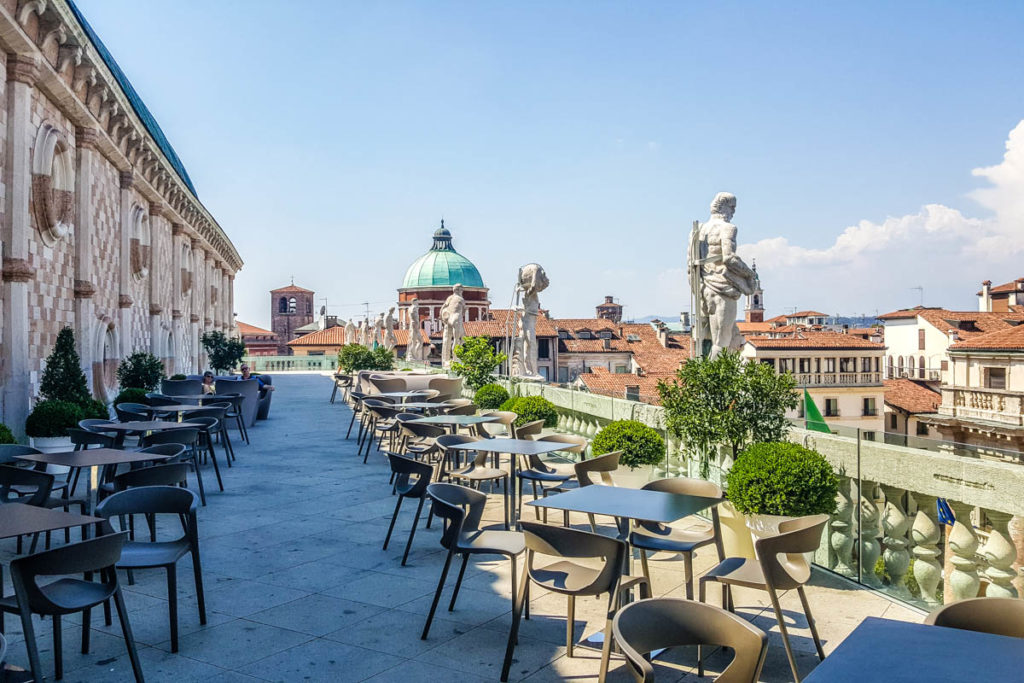
Crowned by a hull-shaped copper rooftop, the Basilica Palladiana towers over Vicenza’s historic centre. Sadly, the building suffered greatly during the Second World War. Its rooftop caught fire and melted during the Allied Forces’ bombing of Vicenza on 18th March 1945. The Palladian loggia and several of the statues adorning the Basilica were damaged, too.
The Basilica and its rooftop were fully restored after the war, and nowadays its distinctive shape features in all iconic images of Vicenza.
To this day the Basilica Palladiana serves the city in many different ways.
The ground floor of the building is taken up by historic shops selling fine jewellery, glasses, and watches. Also here you can visit two of Vicenza’s most well-known bars – Il Grottino and Bar Borsa.
The main floor houses Vicenza’s Jewellery Museum – the first of its type in the whole of Italy – as well as an enormous hall where large art exhibitions are regularly held.
The crowning glory of the Basilica Palladiana is its terrace. Surrounding the building’s hull-shaped rooftop, the terrace is a great place to go for a walk on a balmy evening to take in the beauty of Vicenza from a birds-eye point of view.
More Information:
- Official website of Vicenza’s Basilica Palladiana
- Official website of the first Jewellery Museum in Italy
2. Marvel at the Stage Set of Vicenza’s Teatro Olimpico – the World’s Oldest Indoor Theatre in Masonry
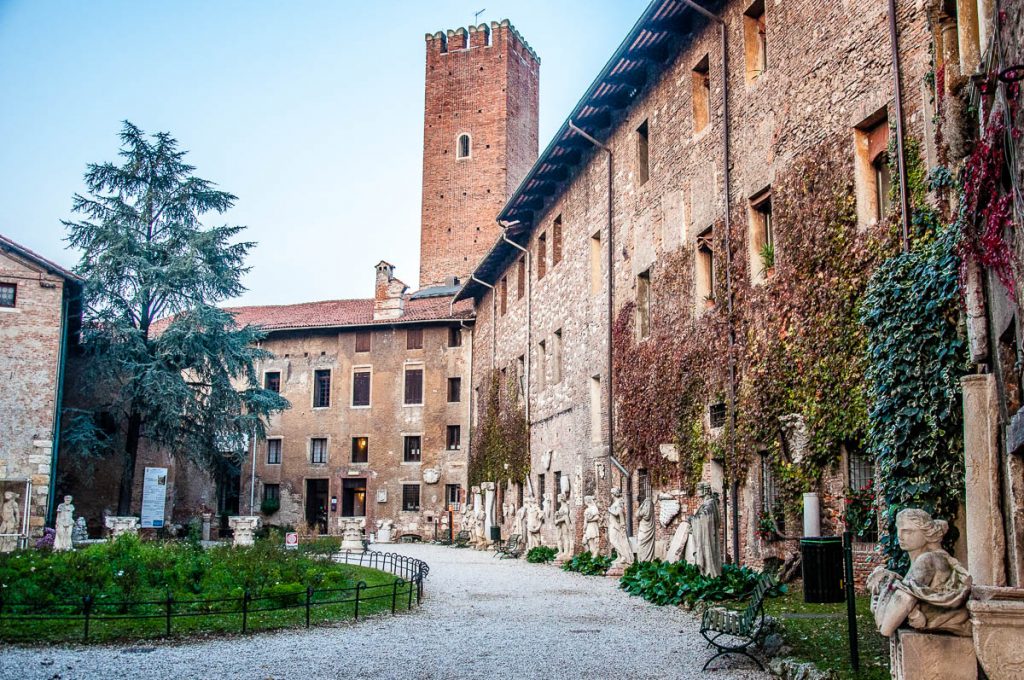
Vicenza’s Teatro Olimpico was built between 1580 and 1585. It was the last project of Andrea Palladio, the Renaissance architect who defined Vicenza’s character. The construction of the theatre was commissioned by the Accademia Olimpica, a cultural institution established in 1555 by a group of the city’s intellectuals. Palladio himself was a founding member.
The Accademia Olimpica aimed to breathe a new lease of life into theatre as a glorious art form of the classical past. Everything classical and referring to Ancient Greece and Rome was revered during the Italian Renaissance. To use a modern term, theatrical performances and the revival of classical ideas about theatre were all the rage at that time.
For the design of Vicenza’s Teatro Olimpico, Palladio took inspiration from ancient Roman theatres as well as from the Cornaro Loggia . The latter is a small theatrical stage – half-opened to the elements – that the engineer and patron of the arts Alvise Cornaro had built in the nearby city of Padua in 1524.
Instead of erecting a brand new theatre, an old building was repurposed in Vicenza. It had previously been a fortress, then a prison, and then a gunpowder warehouse. Unfortunately, Palladio died six months after work on the Teatro Olimpico began and so another renowned architect, Vincenzo Scamozzi, completed the project.
Nowadays, Teatro Olimpico is one of the major sights to see in Vicenza, Italy. It stands at the start of Corso Palladio, the city’s elegant high street, and it is just across the road from Palazzo Chiericati, the home of Vicenza’s Civic Art Gallery . People in the know travel from all over the world to see it. And yet, it remains one of Italy’s most underrated attractions.
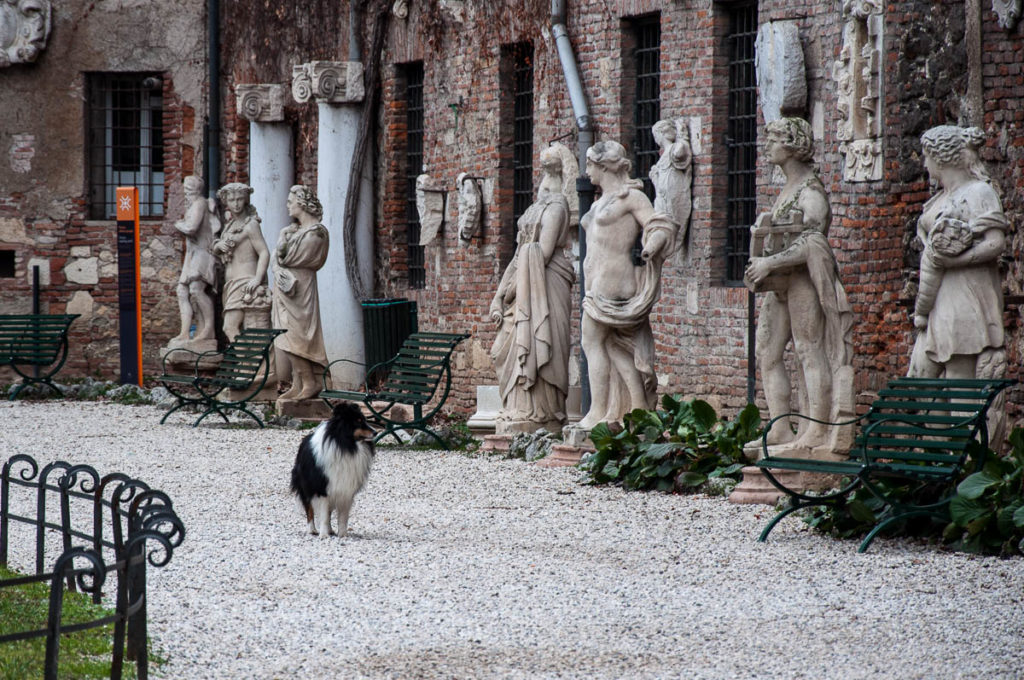
Teatro Olimpico has a small garden populated by ancient-looking (but actually made in the 19th century) statues. They were brought here from another theatre in Vicenza – Teatro Verdi – after it had been destroyed during the Second World War’s bombings of the city. The garden is a lovely place to sit in for a few minutes on a warm day, especially when the pink hydrangeas here are in full bloom.
Inside, Teatro Olimpico has an elliptical auditorium, frescoed walls, and richly decorated surfaces. Statues and lavish ornamentation abound. The effect is stunning and you cannot help it but utter a breathless ‘Wow!’ (as cheesy as it sounds) when you see it for the first time. It’s even more amazing when you realise that instead of stone and marble, everything is made of stucco.
Yet, the most spectacular thing here is the theatre’s stage set! It was created by Vincenzo Scamozzi to represent an idealised vision of the city of Thebes for the inaugural performance of Sophocles’ Oedipus Rex in 1585. Meant to be used just once, the stage set was never taken down. In fact, it is the oldest stage set in the world still in use today.
The clever use of perspective and trompe-l’oeil effects makes it seem like the streets of Thebes disappear far away in the distance. The houses get smaller and smaller the further away they are from the front of the stage. It looks absolutely realistic.
Teatro Olimpico is definitely one of the brightest jewels in Vicenza’s crown. A must-see when you are in town. For maximum effect, try to catch a performance here. Concerts, festivals, and cultural events are regularly held in this historic theatre.
- Official website of Teatro Olimpico
- Exploring Vicenza: Teatro Olimpico
- Video of the auditorium and the stage set of Teatro Olimpico
- Photos of the 19th-century statues in the garden of Teatro Olimpico
- Cornaro Loggia and Odeon in Padua, Italy – History, Architecture, and Art
3. Admire the Architecture of Andrea Palladio all Over Vicenza
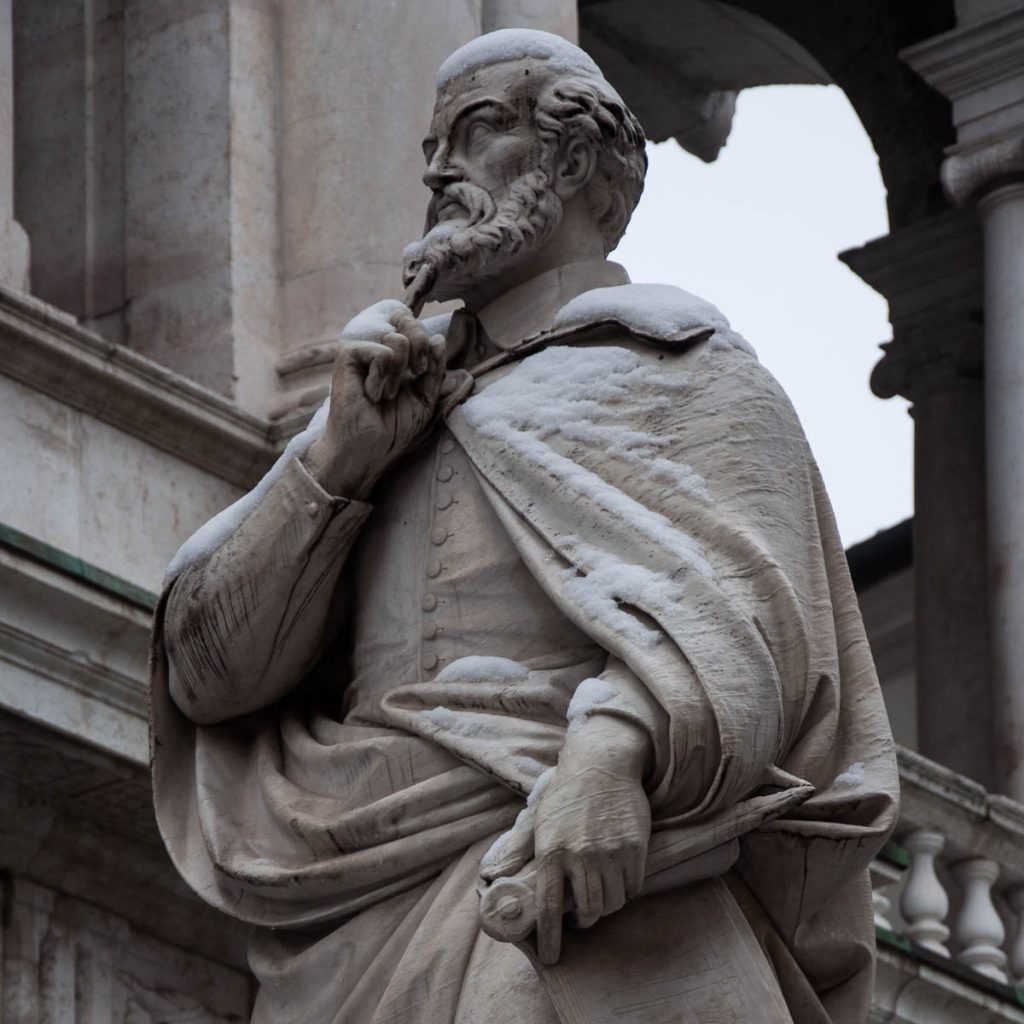
I know I mentioned the name of Andrea Palladio several times already. And this is only fair as Vicenza came to be known as Italy’s Renaissance Pearl precisely due to Palladio’s architecture. Groundbreaking for its time and still exerting influence over the world to this day, it pays homage to the classical canons and ideals of Ancient Greece and Rome.
Born Andrea di Pietro della Gondola into a miller’s family in the nearby city of Padua , Palladio made Vicenza his personal architectural playground, designing and erecting 23 buildings in and around the city.
Having started his career as a stonecutter, the young Andrea was taken under the wing of the patrician and humanist scholar Gian Giorgio Trissino from Vicenza. It was Trissino who bestowed upon his talented protege the moniker Palladio. Andrea’s significant contribution to architecture gave rise to the Palladian style which is still being replicated all over the world.
Palladio’s architecture was a great source of inspiration for many buildings of importance built in the United States. Thomas Jefferson – a Founding Father and the third president of the USA as well as an architect and a polymath – was a dedicated follower of Palladio and referred to Palladio’s designs and writings as ‘his architectural Bible’.
Such is the influence of Palladio’s architecture that, on 6th December 2010, he was proclaimed the Father of American Architecture by the Eleventh Congress of the United States. Note that this happened 430 years after Palladio’s death.
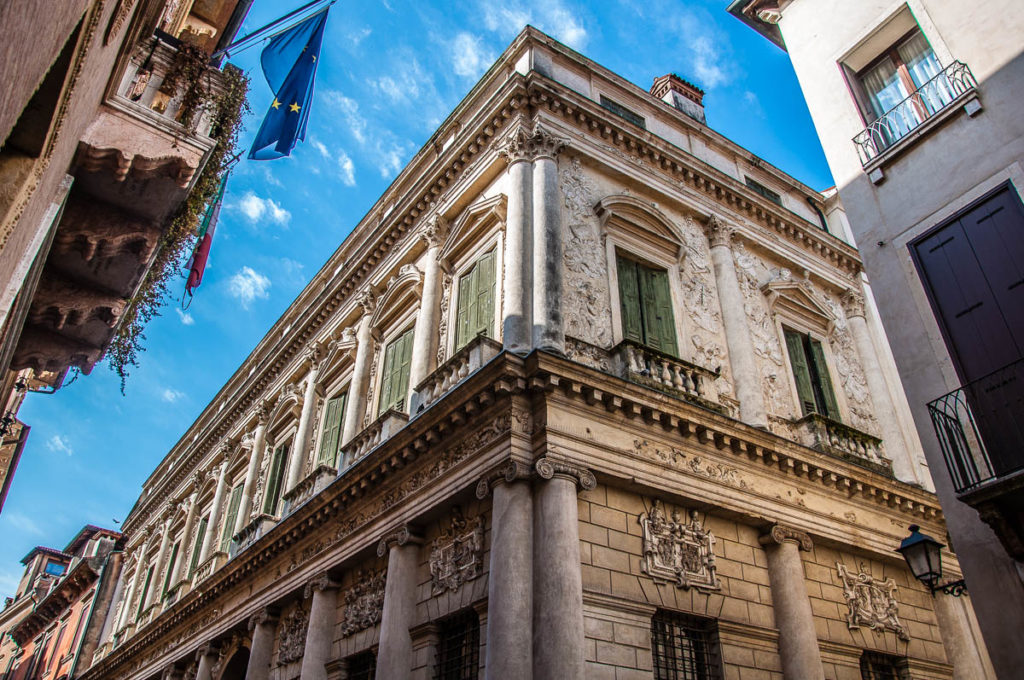
There is no better place in the world to learn about Palladio and admire his designs than the city of Vicenza in Italy. With 23 palaces and buildings designed and erected by Palladio all over town, as well as several of Palladio’s villas gracing the nearby countryside, you can have a very speedy and enriching introduction to architecture and Palladio just by looking around and visiting gorgeous sights.
Here are some of the most important places related to Palladio, his life and work that you can see for yourself during your visit to Vicenza:
- Palladio Museum – housed in the lavish Palazzo Barbaran da Porto (designed by Palladio himself), this is an excellent and innovative museum where you can see Palladio’s treatise The Four Books on Architecture, detailed models of Palladio’s buildings in Vicenza and Veneto , as well as temporary exhibitions that are regularly held throughout the year. The museum collaborates with the most eminent figures in architecture today and it is a place where one can learn lots in a short amount of time. A must-see when in Vicenza!
- Basilica Palladiana – the first major commission of Palladio as a young architect. For more details, see point 1 above.
- Monument of Andrea Palladio – you will find this sculptural representation of a pensive Palladio right next to the Basilica Palladiana. The local cafes place their tables next to the monument and kids run around its base all summer long. It’s a great place to stop for a coffee or an aperitivo and enjoy them in the company of Andrea Palladio himself.
- Teatro Olimpico – the world’s oldest indoor theatre in masonry was originally designed by Palladio himself. For more details, see point 2 above.
- Villa Capra ‘La Rotonda’ – one of the most famous buildings in the world. This villa on the outskirts of Vicenza is cubic in shape and has four identical facades. Much lauded and replicated by architects throughout the centuries, it’s a sight that needs to be seen both inside and out as the beauty of the frescoed interiors complements the perfect proportions of the exterior.
- Palazzo Chiericati – a splendid palace with elegant loggias and a row of statues on the edge of its rooftop. It houses Vicenza’s Civic Art Gallery where you can admire many masterpieces by Venetian and international artists.
- Valmarana Chapel in the Church of Santa Corona – a sombre chapel in the crypt of one of Vicenza’s most splendid churches.
- Palladio’s Monumental Tomb in Vicenza’s Cemetery – Palladio’s was originally laid to rest in Vicenza’s Church of Santa Corona. Later on, a monumental chapel was built especially for him in the city’s cemetery and his bones were transferred there.
- Official website of Palladio Museum
- Official website of Basilica Palladiana
- Official website of Villa Capra ‘La Rotonda’
- Official website of the Civic Art Gallery in Palazzo Chiericati
- Official website of the Church of Santa Corona
- Photos of Palladio’s Monumental Tomb in Vicenza’s Cemetery
4. Take in the Beauty of Vicenza’s Piazza dei Signori and Learn the Stories of the Buildings that Surround It
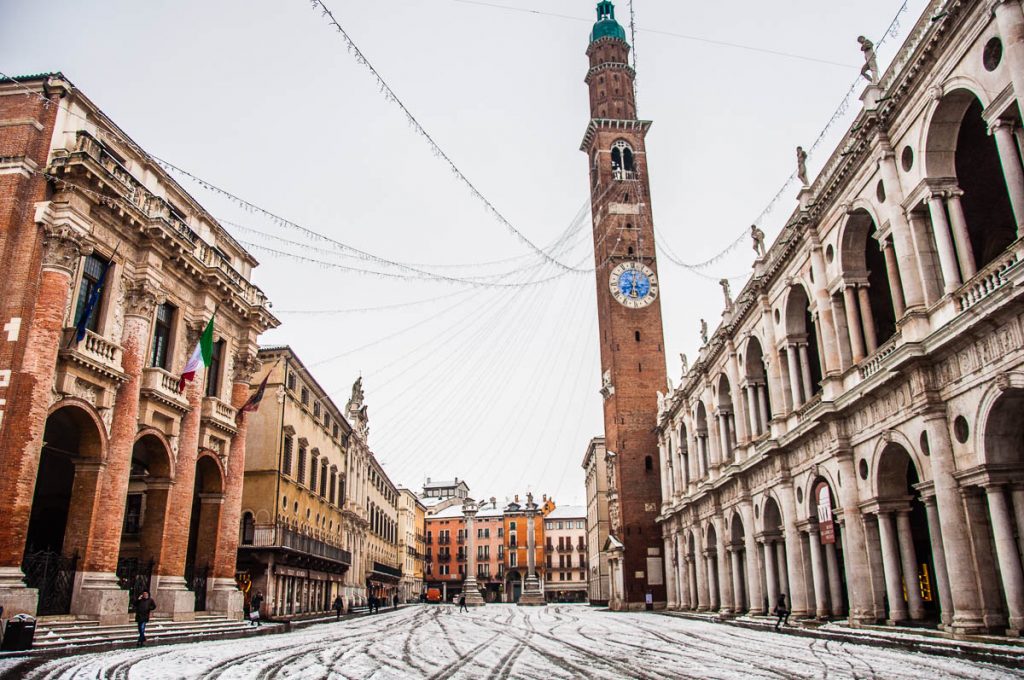
Piazza dei Signori is Vicenza’s historic heart. Standing right at the spot where the Forum of Vicetia – the Roman precursor of Vicenza – once was, this is a large rectangular square surrounded by some of the city’s most iconic and important buildings.
Known as Piazza Grande during the Middle Ages, its current name, Piazza dei Signori, means Square of the Lords in English as this is where the city’s Chief Magistrate and Captain lived when the Republic of Venice ruled over Vicenza from 1404 to 1797.
You have to see and experience Piazza dei Signori for yourself in order to gain a good understanding of Vicenza, its history, and what this little city in Northern Italy stands for.
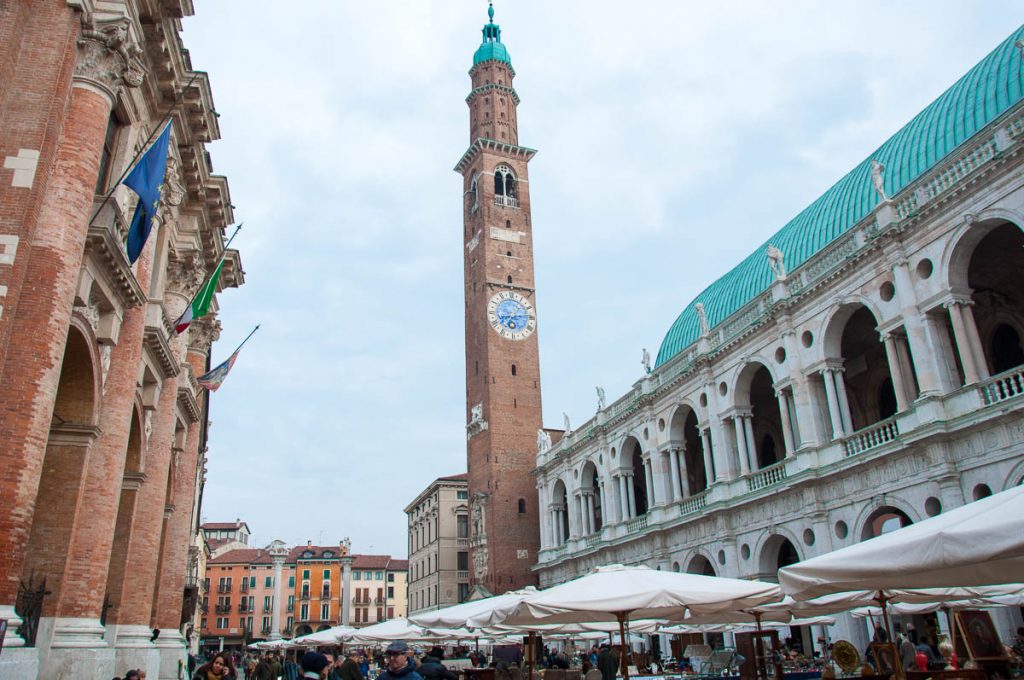
The piazza is grand! Its expansive surface is paved with large flat stones on which the local kids love to run and ride their bikes. On warm evenings, crowds of elegantly dressed people descend on Piazza dei Signori to enjoy a nice evening walk in the company of friends and relatives.
Cafes and bars line the square serving cups of always excellent Italian coffee and glasses of aperitivo .
And then, every Tuesday and Thursday all-year-round, Piazza dei Signori is taken over by a myriad of market stalls selling anything and everything from tablecloths and scarves to bags, potted flowers, curtains, household items, and pants. And, as with everything in Italy, even the market has centuries-long traditions, for it has been held in this central Vicenza square since the Middle Ages.
At weekends, Vicenza’s Piazza dei Signori hosts a long calendar of events: from flower markets to antique shows; from open-air concerts to art performances. Not forgetting the exciting chocolate festival that takes over the square for a long weekend in October. For Christmas, long strands of festive lights hang above the square, thus giving it a very fairytale look.
It wouldn’t be an exaggeration to say that Vicenza’s Piazza dei Signori is one of Italy’s most beautiful squares. It’s definitely a place to see for yourself and knowing a bit about the history of the stunning buildings that surround it will make you appreciate it even more.
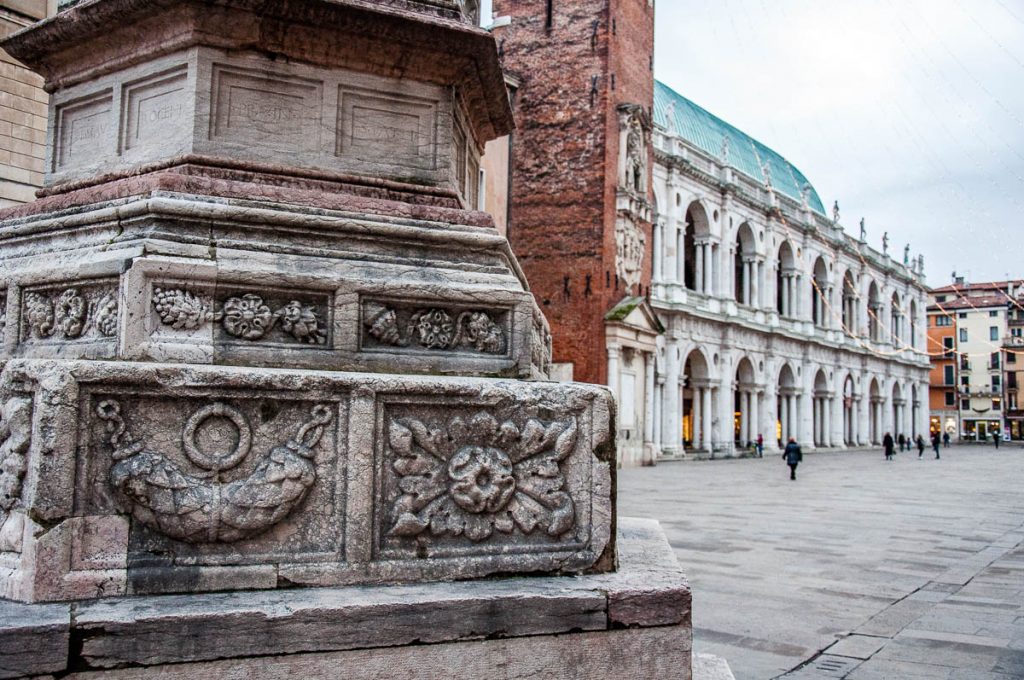
So, here are the most important buildings to see around Piazza dei Signori in Vicenza. Not all of them are open to the public but are still gorgeous to see from the outside:
- Basilica Palladiana – have a look at point 1 in this list for exhaustive details about the history and significance of this stunning Palladian building.
- Torre Bissara – an 82-meter tall clock tower, originally built in the 12th century. Its clock shows both the time and the lunar phases and it was installed in the tower in 1378.
- Palazzo del Capitaniato (also known as Loggia del Capitanio) – a colossal building made of red bricks and lavishly adorned with statues and bas-reliefs. It stands opposite the Basilica Palladiana and it was also designed by Andrea Palladio himself. Comparing the two buildings – both facing each other – is a great way to see how the architect’s style evolved and matured. I particularly like the monumental columns dominating the palazzo’s facade.
- Palazzo del Monte della Pieta and San Vincenzo Church – this is the oldest building on Piazza dei Signori. I love its facade which is 72 m long and incorporates the Church of San Vincenzo (originally built in 1387 and dedicated to Vicenza’s patron saint). Look closely and you will see that the whole facade of the Palazzo del Monte della Pieta is covered with faded frescoes depicting the story of Moses. Originally painted during the Late Renaissance and then repainted at the start of the 20th century, unfortunately, nowadays their beauty is significantly faded.
- The pillars topped by a statue of the Lion of St. Mark’s and a sculpture of Christ the Redeemer – the first pillar was erected in 1464. It was a symbol of the rule of the Republic of Venice over Vicenza. The other pillar was placed at Vicenza’s Piazza dei Signori in 1640.
- Official website of the Basilica Palladiana
- Official website of the Foundation Monte di Pieta
- A View of Vicenza: Sunrise at Piazza dei Signori
- At the Market
- Exploring Vicenza: Flower Power
- Celebrating Santa Barbara – The Patron Saint of Italian Firefighters
5. Discover the Church That No Longer Exists in Vicenza’s Palazzo Chiericati
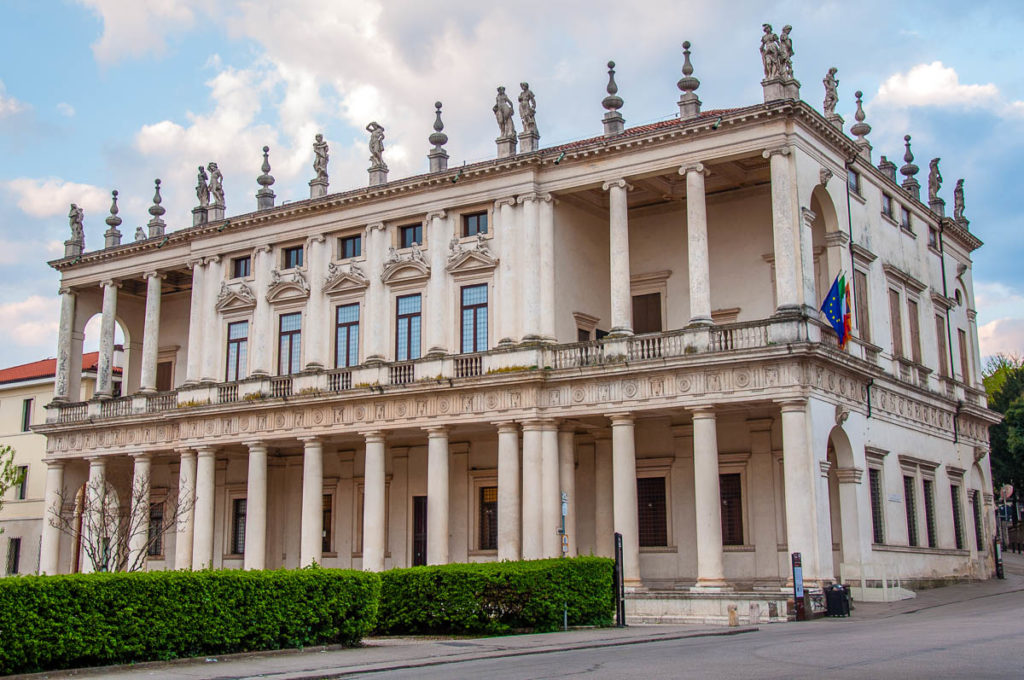
Palazzo Chiericati is a distinguished palace designed by the famous Renaissance architect Andrea Palladio. It stands right at the start of Vicenza’s main street – the elegant Corso Palladio. A row of statues adorns the top of its beautifully symmetrical facade. The palazzo is very easy to fall in love with.
Built between the 16th and the 17th centuries, Palazzo Chiericati has been hosting Vicenza’s Civic Art Gallery since 1855. Come here to see the city’s art collections and to admire stunning 16th-century frescoes and 17th-century stuccoes. The underground floor of the palace is where you can see the carefully preserved remains of 14th- and 15th-centuries houses.
A visit to Palazzo Chiericati is a must when you are in Vicenza, Italy. The collections housed here range from the art of the Middle Ages to that of the 20th century. You have the chance to admire masterpieces by the likes of Tintoretto, Veronese, and Tiepolo. And the best bit is that quite often, the museum is a peaceful and quiet place to spend hours in your own company while contemplating the paintings.
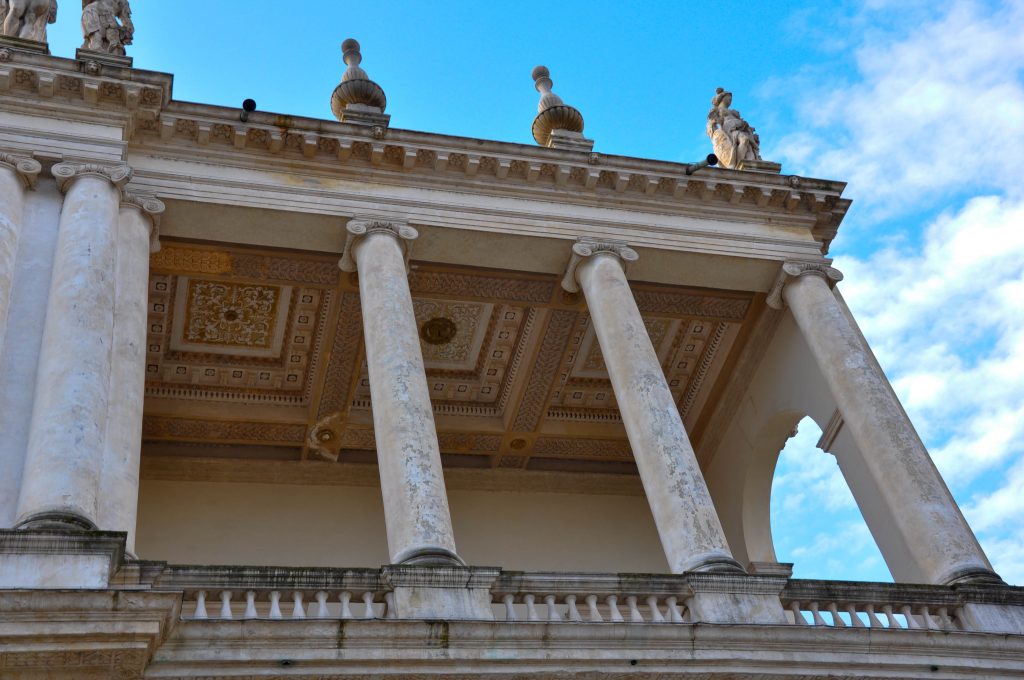
One of the most interesting things to see in Palazzo Chiericati is the art that used to adorn one of the richest churches in the city of Vicenza. The Church of St. Bartholomew (locally referred to as San Bortolo) was part of a centuries-old monastery at the place where nowadays Vicenza’s hospital stands.
The cloister of the old monastery is still there. You can see it and sit in its small garden if, for whatever reason, you need to visit the hospital here.
The Church of St. Bartholomew was first mentioned in documents as early as the 13th century. The monastery that grew around it had an eventful history throughout the decades that followed. However, in 1771, it was suppressed by decree of the Venetian Senate and its building was converted into a hospital.
The repurposing of the monastery led to its gradual dismantling. Thirteen large canvasses that until that moment had been adorning the altars of the Church of St. Bartholomew were given to Vicenza’s Civic Art Gallery for safekeeping.
Nowadays, you can admire these altarpieces – enormous in their size and incredibly rich in their detail – in one of the largest halls of Palazzo Chiericati. Painted by Cima da Conegliano, Bartolomeo Montagna, and other famous Venetian artists, originally they were surrounded by intricately decorated marble frames. These frames are reproduced here in thick card. This gives you a good idea of what it felt like being in the church that no longer exists.
- Official website of the Civic Art Gallery of Palazzo Chiericati
6. Explore the Eclectic Art Collection of Gallerie d’Italia in Palazzo Leoni Montanari

Palazzo Leoni Montanari is a lavish late Baroque building that catches the eye and takes the breath away with its whimsical stucco decorations and a row of statues right on the edge of its rooftop.
You will find it tucked away in a quiet side street just off Vicenza’s main artery, Corso Palladio, and a few steps up from one of the city’s most important churches – that of Santa Corona.
The palazzo houses the eclectic art collections of the Vicenza’s branch of Gallerie d’Italia – a museum that also has a presence in Milan and Naples.
Make sure that you visit the Gallerie d’Italia during your stay in Vicenza. From Ancient Greek pottery to 18th-century Venetian masterpieces by the likes of Canaletto, Pietro Longhi, and Francesco Guardi, from Western Europe’s largest collection of Russian religious art to exciting temporary exhibitions, the museum is a delight to explore.
Plus, the palace in which it is set is simply stunning with its incredibly ornate ceilings and frescoed walls. Often, you won’t know what to look at first – the actual works of art or the lavish architectural setting.
My most favourite masterpiece in the Gallerie d’Italia in Palazzo Leoni Montanari in Vicenza is the sculpture called The Fall of the Rebel Angels. Carved from a single piece of Carrara marble it features 60 figures of angels and demons engaged in a ferocious fight. There are some dragons, too.
The sculpture is the work of Agostino Fasolato – a sculptor from Padua. It’s truly spellbinding! I love spending time seeing it from all possible angles and admiring the perfect composition of tangled bodies, wings, and tails.
- Official website of Gallerie d’Italia
7. When in Vicenza, Pay Homage to the Original Author of ‘Romeo and Juliet’

Enter one Luigi da Porto!
Little known beyond the confines of his native Vicenza, this nobleman and soldier is the actual author of the world’s most well-known love story – that of Romeo and Juliet!
It may feel like everything you have ever known and trusted is crashing down in a big puff of smoke but, yes, it’s true! William Shakespeare was not the person to originally come up with the plot of the story of the star-crossed lovers. Although, yes, he managed to make it world-famous. We need to give him that!
Instead, Romeo and Juliet (or Romeo and Giulietta as they are known in Italian) are the creation of the literary mind of Luigi da Porto. He was a nobleman from Vicenza who retreated to his villa in the countryside to write after he had been gravely wounded in a military campaign.
From the windows of his villa, da Porto could see two medieval castles – the Castle of Villa and the Castle of Bellaguardia. They crown the lush hills around the small town of Montecchio Maggiore which is only about 15 mins away by car from Vicenza.
Gazing up at the castles and finding inspiration in a local legend and his own love troubles, between 1512 and 1524 da Porto penned a novella. It was called Historia novellamente ritrovata di due nobili amanti (in English: A Newly Found Story of Two Noble Lovers) and it was dedicated to his cousin Lucina Sarvognan whom he was in love with.
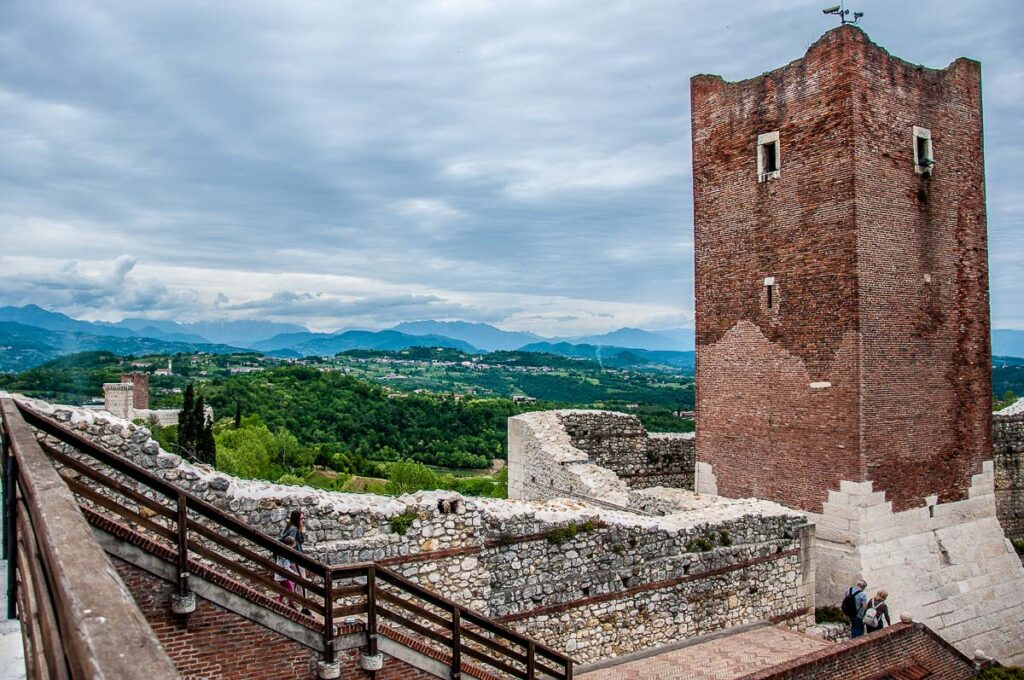
Luigi da Porto set the plot of his novel in Verona and came with the names of Romeo Montecchi and Giulietta Capuletti. It is thought that da Porto’s inspiration for Romeo’s name and surname and Juliet’s surname came from Dante’s Divine Comedy.
Da Porto outlined the young couple’s tragic love and ultimate death. In addition, he introduced the characters of Mercutio, Tybalt, Friar Laurence, and Paris.
The novella was published in Venice in 1531 – after the writer’s death – and it was so successful that it was even translated into English.
Have a look at this detailed Romeo and Juliet itinerary you can explore during your visit to Northern Italy. Taken from it, here are a few places you can visit in and around Vicenza to get in touch first hand with the life and spirit of Luigi da Porto:
- Head to the pretty as a picture Contra’ Porti in Vicenza. Between the large ornate gates of numbers 15 and 17 on this street, you will see a memorial plaque. It commemorates the fact that Luigi da Porto died in this house on 10th May 1529 at 43 years of age.
- Pay a visit to Vicenza’s stunning Church of Santa Corona . The author of Romeo and Juliet is laid to rest here in a stone sarcophagus on the left-hand side of the church under a large painting by Bartolomeo Montagna.
- Luigi da Porto is mentioned in the exhibition of Palazzo Chiericati (see point 5 above), as well .
- Head to Montecchio Maggiore and visit the two castles that inspired the writing of Luigi da Porto. Originally known as the Castle of Villa and the Castle of Bellaguardia, nowadays everyone refers to them as Romeo’s and Juliet’s Castles.
- The Ultimate Romeo and Juliet Itinerary – The Real and Literary Settings Behind the World’s Most Famous Love Story
- Montecchio Maggiore, Italy – 4 Hidden Gems You Need to See in the Real Town of Romeo and Juliet
8. When in Vicenza, Learn the Story of Antonio Pigafetta – Magellan’s Diarist
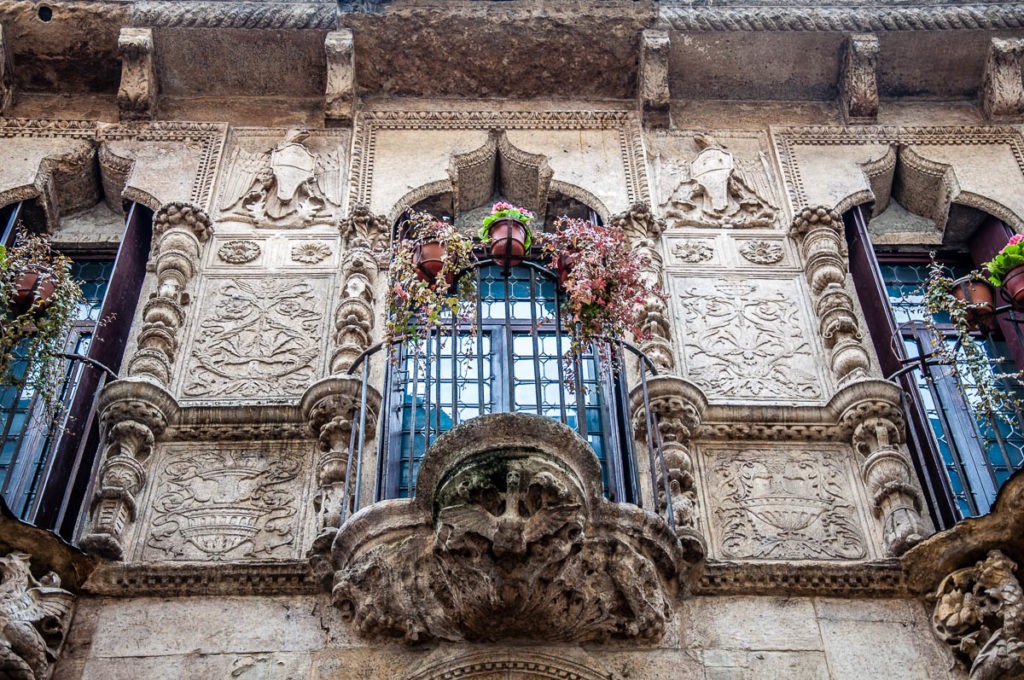
Ferdinand Magellan is known the world over as the leader of the first circumnavigation of the Earth. It took place between 1519 and 1522.
Yet, had it not been for one Antonio Pigafetta, a nobleman and adventurer from Vicenza, there is a chance that we may have never learned the precise details of the role that Magellan had in this feat.
The strong tensions at the time between Spain (the country that had subsidised the expedition) and Portugal (the homeland of Magellan) threatened to rewrite history in many different ways.
It was only thanks to the detailed diary that Pigafetta – a member of Magellan’s crew – had kept during the circumnavigation of the world, that we know what exactly happened in the three years that it took to complete it.
Once back in Vicenza, Pigafetta published his book Report on the First Voyage Around the World . It was based on the notes that he had taken during the long and arduous journey.
In his book, Pigafetta included facts, maps, and observations about the visited places, their geography, flora, fauna, languages and not least their people. He even described Magellan’s death and was one of just 18 people who completed the circumnavigation out of the 240 who had been part of the original crew.
Vicenza is incredibly proud of its son and his role in the historical journey.
In September of each year, a special procession takes through the streets of the city’s historic centre in celebration of Pigafetta’s life and achievements.
If you are in town at any other time of the year, make sure that you walk past the so-called Pigafetta’s House. For me, this is the most beautiful house in town. It’s private property, so no visits are allowed.
It has to be said that Antonio Pigafetta himself never actually lived in this house. It was owned by the Pigafetta family of which Antonio was the most notable member. Until the 1990’s it was, however, assumed that the building had been his. You can see a nice memorial plaque describing Antonio’s achievements on the wall right next to the house.
- Official website of Pigafetta 500 Cultural Association
- The World’s First Travel Blogger
9. Eat at Vicenza’s Honest Restaurant and/or Several of the City’s Best Eateries
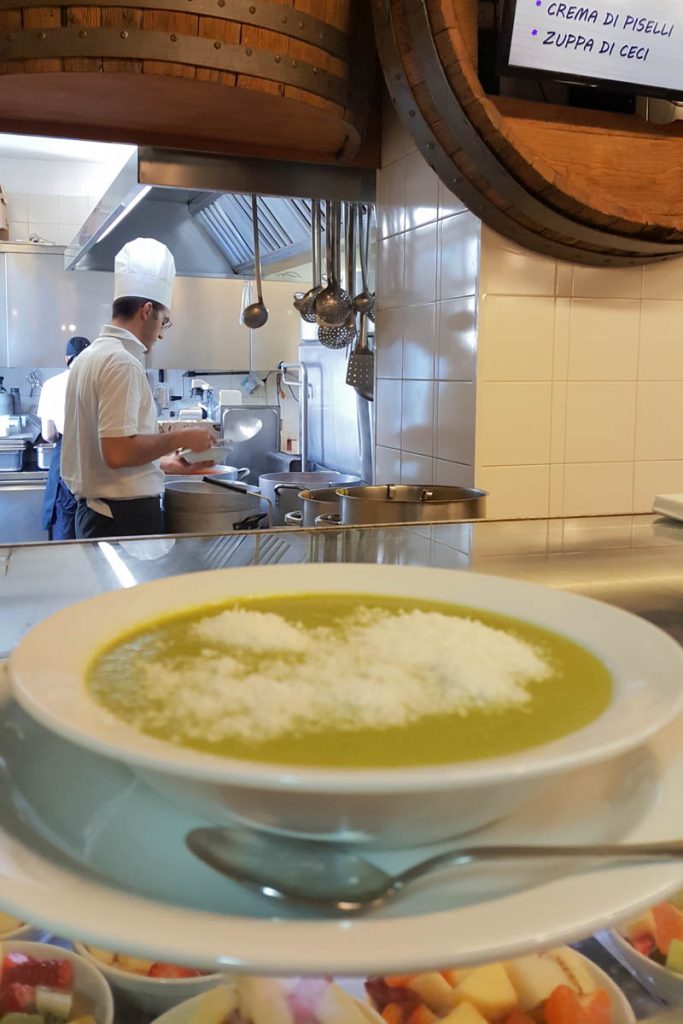
While other cities may have an honest bar in an exclusive hotel, Vicenza has a whole honest restaurant with delicious food and prices that are incredibly pocket-friendly.
An honest restaurant means that you get your food from the counter and once finished, you go up to the till and tell the gentleman behind it what you had. No one keeps a tally and it is up to you and your honesty to list everything that you consumed.
Called Ristorante Righetti and situated very close to Vicenza’s Duomo and Piazza dei Signori, the restaurant has been at that place for many years and it is a place the locals love to flock to. Prices are very affordable and the food is always fresh and tasty.
Righetti is open for lunch and dinner Monday to Friday and it remains closed on weekends. It gets very busy very quickly. I really love going there as the food is seasonal and changes daily. You can also see the chefs hard at work, filling deep plates with soup and plating hot meals. It is certainly an experience, especially, the first time when you are unsure how it all works.
In addition, here are some more suggestions for places to go to in Vicenza for a nice meal:
- La Bottega da Claudio – pop in for fresh seafood and Venetian finger food – cicchetti – just off Piazza dei Signori in town. Click here for photos of some of the dishes you can sample at this small place.
- Il Ceppo – a deli with a bistro preparing and serving fresh traditional local dishes.
- Angolo Palladio – excellent pizzas and very nice steak.
- Bamburger – handmade burgers with vegetarian and vegan options, too. Everything is locally sourced.
- Pizzeria Vesuvio – a large selection of tasty pizzas at excellent prices.
- Agriturismo Corona – a very easy to reach from central Vicenza farmhouse where you can taste local dishes with on-site grown fresh produce at very reasonable prices.
10. Taste Vicenza’s Most Beloved Dish – Bacala’ Alla Vicentina
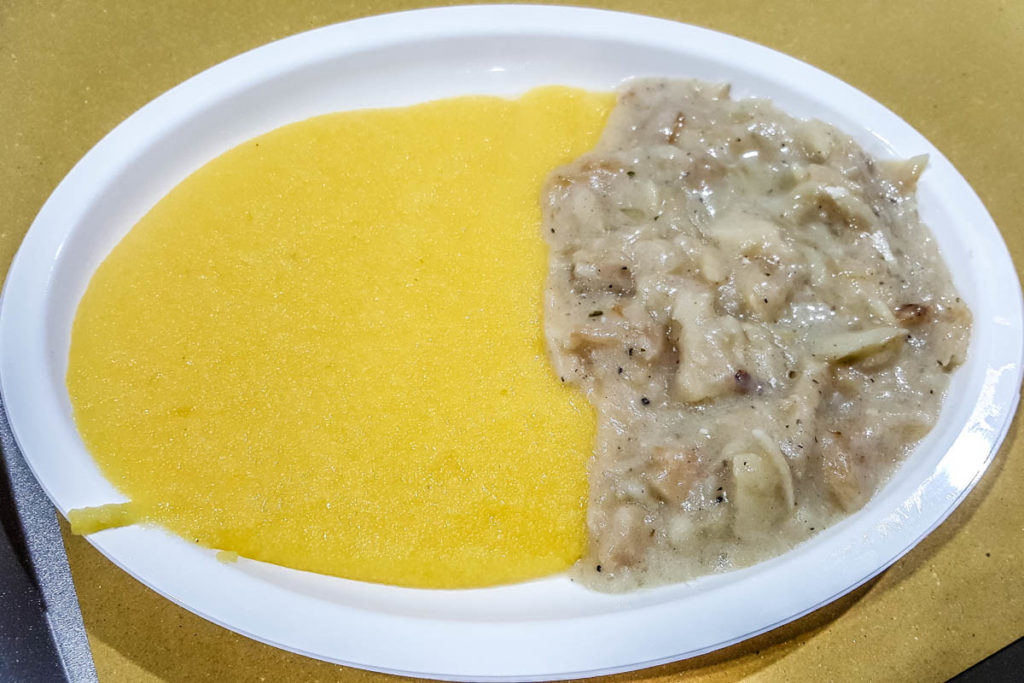
Bacala’ alla vicentina – cod cooked the Vicenza way – is a dish with centuries-old traditions that the people of Vicenza are incredibly proud of.
Prepared with stockfish – air-dried cod – from the Norwegian island of Røst and served on a bed of piping hot polenta , bacala’ alla vicentina must be sampled when you are in Vicenza. Otherwise, you wouldn’t be getting the full cultural experience.
Keep an open mind, however, as both visually and in taste, the dish doesn’t have much in common with what the world has come to perceive as traditional Italian food.
Yet, there are not many dishes still served in Italy to these days with a more exciting history and more jealously guarded traditions than the bacala’ alla vicentina . Plus, it is a dish that is very difficult to prepare well. So, make sure that you sample it at one of the restaurants recommended by the Venerable Brotherhood of the Bacala’ alla Vicentina. Because, yes, this dish has its own brotherhood! As you do!
For me, the most amazing thing about the bacala’ alla vicentina is the food route that was established centuries ago to meet the demand for it. The cod – dried to a crisp – has been travelling from Røst to Vicenza for close to 600 years. It is quite amazing to think that so many centuries ago, two of the most distant from one another countries in Europe developed a trade based on the love of the citizens of Vicenza for this particular fish.
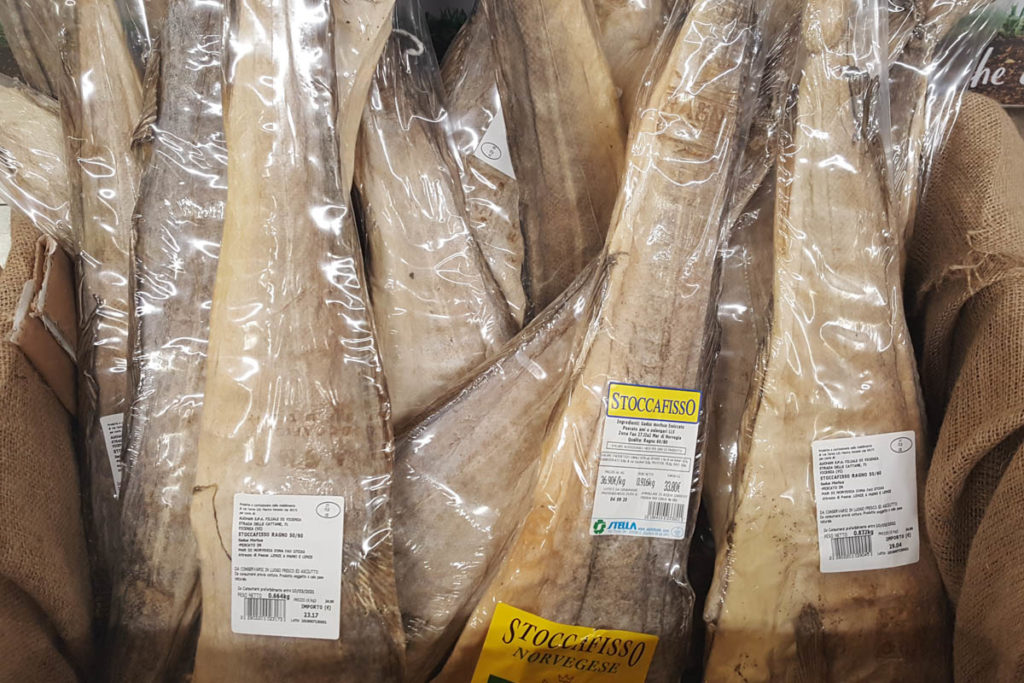
It all started in 1431 when Piero Querini – a Venetian merchant – sailed away from Crete (then known as Candia) to Flanders on a ship laden with precious wares. As fortune would have it, Querini’s ship was wrecked. He and the surviving sailors found refuge on the island of Røst on the outer edges of the Lofoten Archipelago in Norway.
There, the Venetians developed a taste for the locals’ sustenance – stockfish. In other words, peeled and salted cod that is air-dried for months thus becoming hard as a stick. On their way back to Venice , Piero Querini and his mates brought a load of stockfish. Soon, stockfish inspired the development of several recipes in the cities and towns which at the time were under the rule of the Republic of Venice. Hence, a food route was established between the Republic and the island of Røst.
Bacala’ alla vicentina was the stockfish-based dish developed specifically in Vicenza. It marries in one plate the best of Røst and the best of Veneto . Røst’s air-dried cod is rehydrated in milk over several days and then slowly cooked over many hours. It is then served on a bed of polenta – Veneto’s staple dish.
You may not fall in love with bacala’ alla vicentina from the very first bite. Do give it a chance though. It is an integral part of the Vicenza experience.
- Official website of the Venerable Brotherhood of the Bacala’ alla Vicentina
11. Discover Vicenza’s Roman Roots
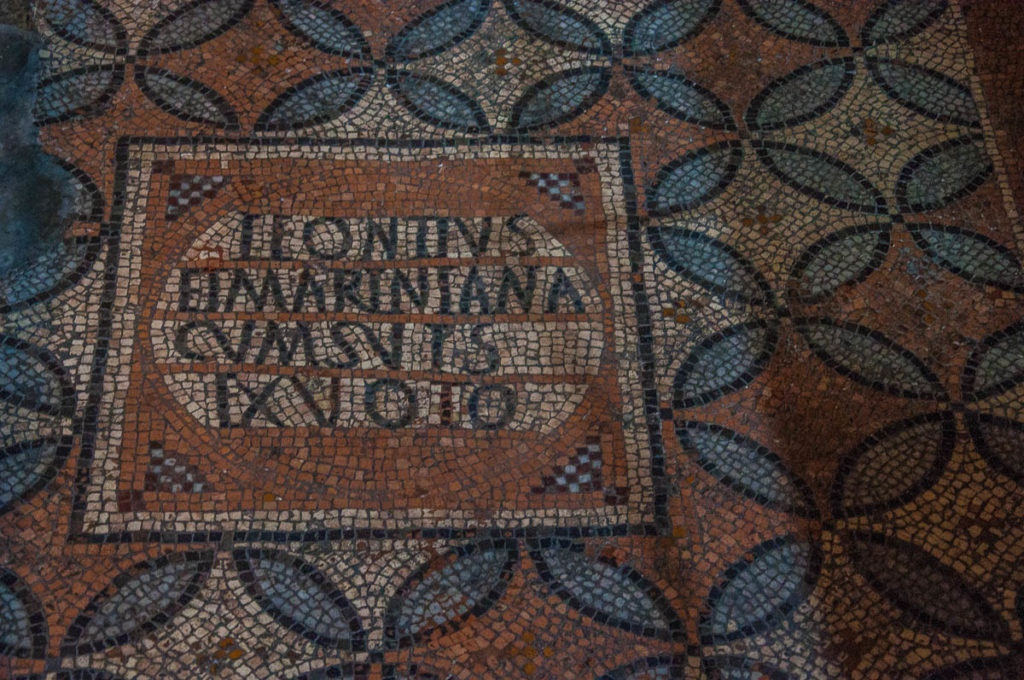
Vicenza owes its name to the ancient Romans. Originally a settlement first of the Proto-Italic Euganei tribe and then of the Paleo-Veneti tribe, by 157 BC, the city had become a Roman centre known as Vicetia or Vincentia – the Victorious.
In 49 BC, Vicetia became a municipium , i.e. a Roman town, and its inhabitants were granted Roman citizenship.
Although nowadays Vicenza is deprived of big and flashy Roman ruins, there are several hidden corners around the city where you can get close to the ancient Romans and their lives in Vicetia.
Above all, it’s interesting to know that many of Vicenza’s contemporary landmarks lie on top of their Roman equivalents. As such, Corso Palladio, Vicenza’s elegant main street, follows the straight line of the Roman Decumanus Maximus – Vicetia’s main road which pointed to Aquileia to the east and to Verona to the west.
Similarly, Vicenza’s main square – the monumental Piazza dei Signori – occupies the spot at which the Roman Forum once stood. A semicircular terrace of residential buildings just off Piazza dei Signori follows the exact outline of the no-longer in existence 1st BC Roman Theatre that was Vicetia’s most prized building in Roman times.
In addition, here are the most important spots and places around town where you can get in touch with Vicenza’s Roman days of glory:
- Criptoportico Romano – a cryptoporticus is a covered passageway that is half-underground and is lit via windows or openings at the top of its walls. A splendid Roman cryptoporticus – once part of a lavish Roman house – was uncovered in Vicenza after a bombardment by the Allied Forces during the Second World War. Nowadays, the cryptoporticus is open for guided visits that give you a chance to learn about Roman Vicetia and what relics were found during the archaeological studies that took place here.
- Archaeological Area of Vicenza’s Cathedral – join a guided visit organised by Vicenza’s Diocesan Museum and see the remains of Roman Vicetia underneath the city’s cathedral. Once again, these ruins were discovered after the Allied Forces heavily bombed the cathedral during the Second World War.
- Roman relics at the Archaeological Museum of Vicenza – admire Roman mosaics and relics in the small but nicely curated Archaeological Museum in the city.
- Early Christian artifacts at the Diocesan Museum of Vicenza – trace the early history of Christianity in Vicenza on the threshold between the Roman era and the early Middle Ages.
- Late Antiquity mosaics and sarcophagi in the Basilica of Santi Felice and Fortunato – the oldest church in Vicenza is a multilayered environment where each wall, pillar, and pavement bear testimony to the constant rearrangement of the religious building throughout the centuries. Here you can see mosaics dating back to the 4th and the 5th centuries as well as sarcophagi from the cemetery that existed at that place during the times of the Roman Empire.
- Official website of the Natural History and Archaeological Museum in Vicenza
- Official website of the Diocesan Museum in Vicenza
- Archaeological Museums in the Province of Vicenza on the ArcheoVeneto portal
- Archaeological Association Veicetia
12. See the Holy Thorn at Vicenza’s Diocesan Museum
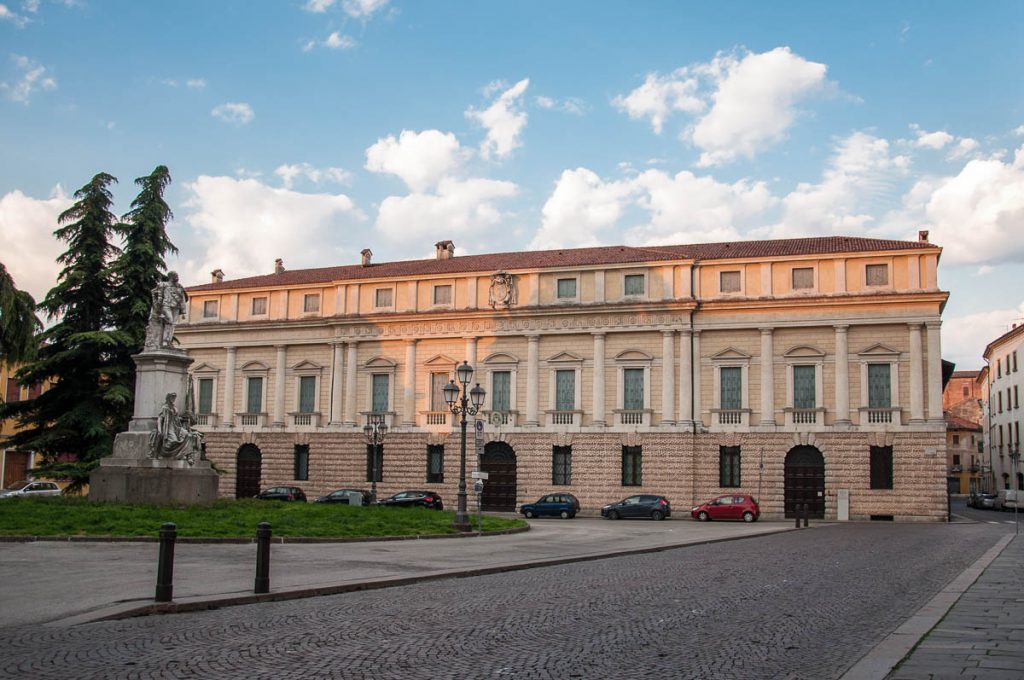
The Diocesan Museum traces the history of Christianity and Christian worship in Vicenza, Italy. It has some very interesting collections of archaeological artifacts, fine paintings, religious vestments, illuminated manuscripts, and even Romanian icons. In addition, the museum has a beautiful collection of spheres made of semi-precious stones as well as a multi-room collection of ethnic masks from all over the world. Unfortunately, the latter is only rarely open to the public.
The Diocesan Museum is also where you can see a staggering 3D model of Vicenza’s historic centre. Made entirely of silver with some gold details, it is a testament to the city’s centuries-old traditions of silver- and goldsmithing and jewellery-making.
Yet, the most precious item in the collections of Vicenza’s Diocesan Museum is the Holy Thorn from the Crown of thorns that was placed on the head of Jesus during His crucifixion.
The Holy Thorn is housed in a precious reliquary studded with gems and adorned with enamels. Made in the 14th century by the goldsmiths of Vicenza, the reliquary is beautiful to look at. Make sure that you spend some time just taking in the many intricate details and scenes that have been painstakingly created on the reliquary’s surface.
The Holy Thorn was given by the King of France Louis IX to the Blessed Bartolomeo da Breganze – an Italian Dominican friar and bishop of Vicenza in the 13th century.
Up to 1850, the Holy Thorn was kept in the Chapel of the Holy Thorn in the Church of Santa Corona in Vicenza. It was then moved for safekeeping to the Diocesan Museum where it can be seen year-round. Holy Week is the only exception. This is when the Holy Thorn is transferred back to the Church of Santa Corona so that the faithful can worship it during the Easter celebrations.
13. Admire Giovanni Bellini’s Painting in the Church of Santa Corona in Vicenza
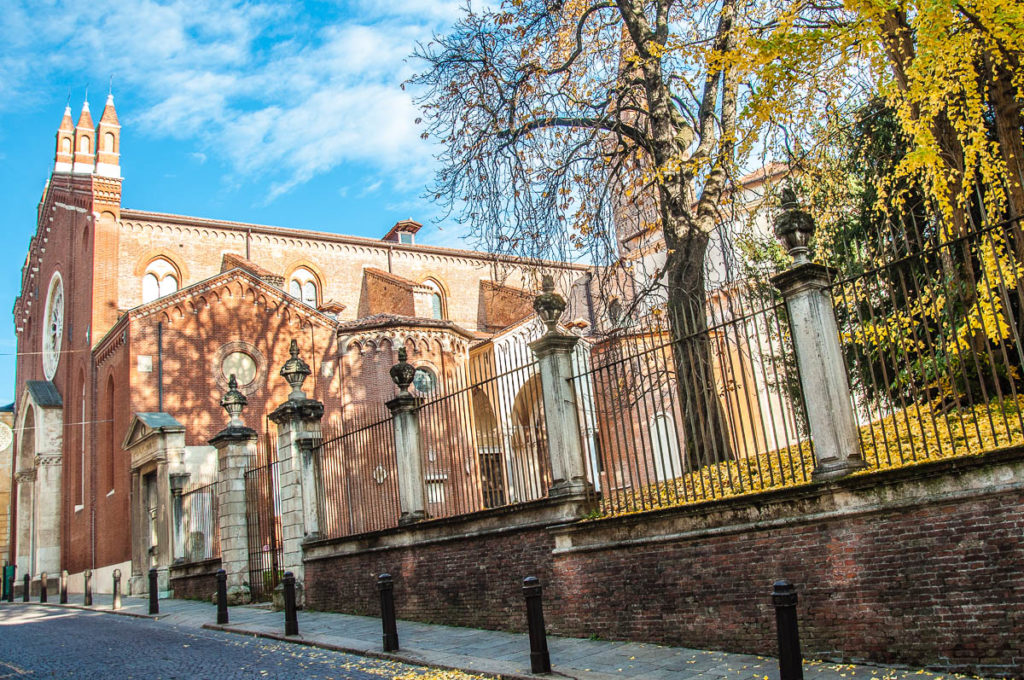
The Church of Santa Corona is one of the most interesting and beautiful places to see in Vicenza, Italy.
Originally built in the 13th century to house the Holy Thorn that had been given to the Bishop of Vicenza by the King of France (see point 12 above), the church quickly became the city’s main place of worship for many centuries.
Nowadays, its Gothic brick building houses many priceless works of art by the likes of Paolo Veronese and Bartolomeo Montagna. The church also has a spectacular pietra dura altar and intarsia choir stalls with complicated patterns and scenes made entirely of wood.
Among the famous people interred here is Luigi da Porto – the original author of Romeo and Juliet (see point 7 above). The great Renaissance architect Andrea Palladio was also originally laid to rest here (see point 3 above) and the church’s Valmarana Chapel is one of Palladio’s works.
The most impressive work of art in the Church of Santa Corona in Vicenza is an enormous canvas by Giovanni Bellini – one of the most renowned artists of the Venetian school of Renaissance painting.
Depicting the Baptism of Christ and painted in 1501-2, this is a full-scale altarpiece. Over four metres high, the painting grabs your attention as you walk by and soon you will notice that the eyes of Christ seem to gently gaze upon you as you walk around the church. Bellini’s painting is very harmonious and a soft light seems to flow from it.
A richly adorned frame complements this extraordinary painting which is one of the most famous works of art of the Italian Renaissance.
14. Make a Pilgrimage to Vicenza’s Sanctuary of Monte Berico
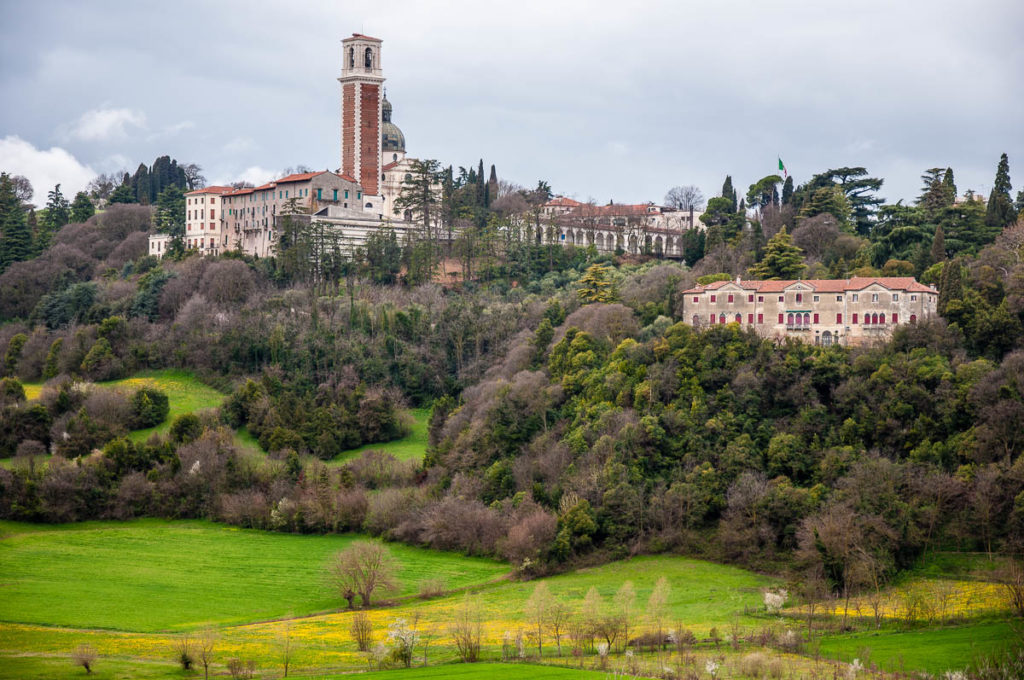
Monte Berico is the hill at the foot of which Vicenza’s historic centre spreads out. On top of it stands one of Italy’s most important sanctuaries dedicated to the Virgin Mary.
The local tradition states that the Virgin appeared twice on that hill to a peasant girl called Vincenza Pasini – first in 1426 and then in 1428. At the time, Vicenza was being ravished by a terrible plague and the Virgin promised that if the local people were to build her a church on Monte Berico, the contagion would come to an end.
The church was built in three months. Inside it, the faithful pray in front of a statue of the Virgin Mary which was sculpted by Nicolo’ da Venezia in 1430. It is interesting to note that the sanctuary has been remodeled several times throughout the centuries. The way it looks nowadays is the result of the integration of two churches – a Gothic one from the 15th century and a Baroque one from the 18th century. Behind them, you will find a convent with a peaceful cloister where every Christmas a large Nativity Scene is set up.
From the cloister, you can walk into the friars’ old refectory which is adorned with the grandiose canvas ‘The Supper of St. Gregory’ by Paolo Veronese. On 10th June 1848, the painting was cut into 32 pieces by Austrian soldiers attacking Vicenza. Thankfully, the painting was soon restored and to this day it is one of the central works of art to be admired at Monte Berico.
You can walk from Vicenza’s main square – Piazza dei Signori – up to the top of Monte Berico. A long covered gallery goes up the hill and leads to the sanctuary. Alternatively, a stone stairway just a bit further down the road goes halfway up the hill and from there you can walk in the shade of the gallery or on the pavement that runs paralel to it.
Monte Berico and its Marian Sanctuary need to be seen as part of a visit to Vicenza. They are intrinsically connected to the history, traditions, and beliefs of this small Italian city and its people.
- Official website of the Sanctuary of Monte Berico
15. Feast Your Eyes on Vicenza’s Stunning Panoramic Views
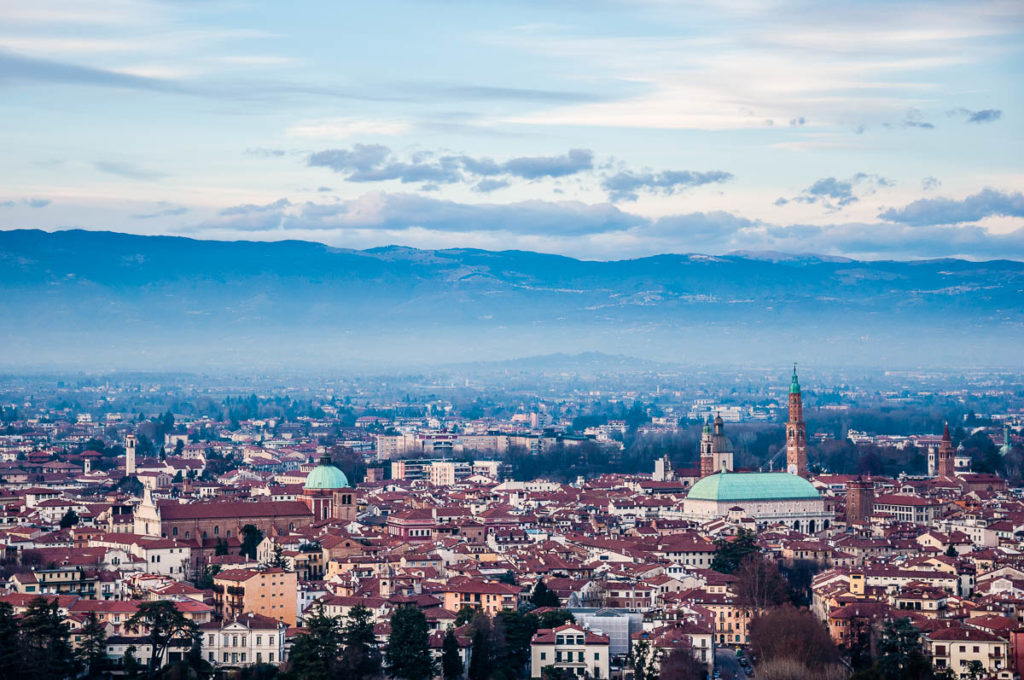
Vicenza is a very pretty city. It looks even lovelier seen from a high point. Here is an easy to tick off list of the places dotted around town which give you the height needed to enjoy some stunning views and to take some lovely panoramic photos:
- Terrace of the Basilica Palladiana – a lovely open-air space giving you heady views of the Piazza dei Signori below and of the rooftops of Vicenza around you. You can even have a coffee or an aperitivo up there for maximum enjoyment of the views!
- Piazzalle della Vittoria – use your walk to the top of Monte Berico (see point 14 above) to enjoy some of the best panoramic views of Vicenza. Piazzalle della Vittoria is a small square just a few steps away from the Sanctuary of Monte Berico. It is surrounded by a stone balustrade and it allows you to see the whole city and the surrounding mountains. From Monte Grappa and the Dolomites to the Venetian Lagoon, on a crisp day the views from up there are truly spellbinding.
- The top of the Scalette – the Scalette is the long stone stairway that leads up to Monte Berico. Once you have scaled its 192 steps – a nice and energising physical effort – you will be rewarded with a stunning view of Vicenza with the green domes of the Basilica Palladiana and the city’s Duomo in the heart of the historic centre.
- Il Torrione – an imposing medieval tower that is a remnant of Vicenza’s no longer existing Scaliger Castle . It dominates the landscape of the city’s historic centre. An exhibition space dedicated to contemporary art occupies the tower’s top floors. A visit to Il Torrione will allow you to enjoy a breathtaking view of Vicenza from a height of 60 metres.
Try to see Vicenza from above from as many of these four places as you can visit. Each will provide you with a different angle from which to enjoy the city and its beauty.
- Official website of Fondazione Coppola
16. Cross Vicenza’s Bridges
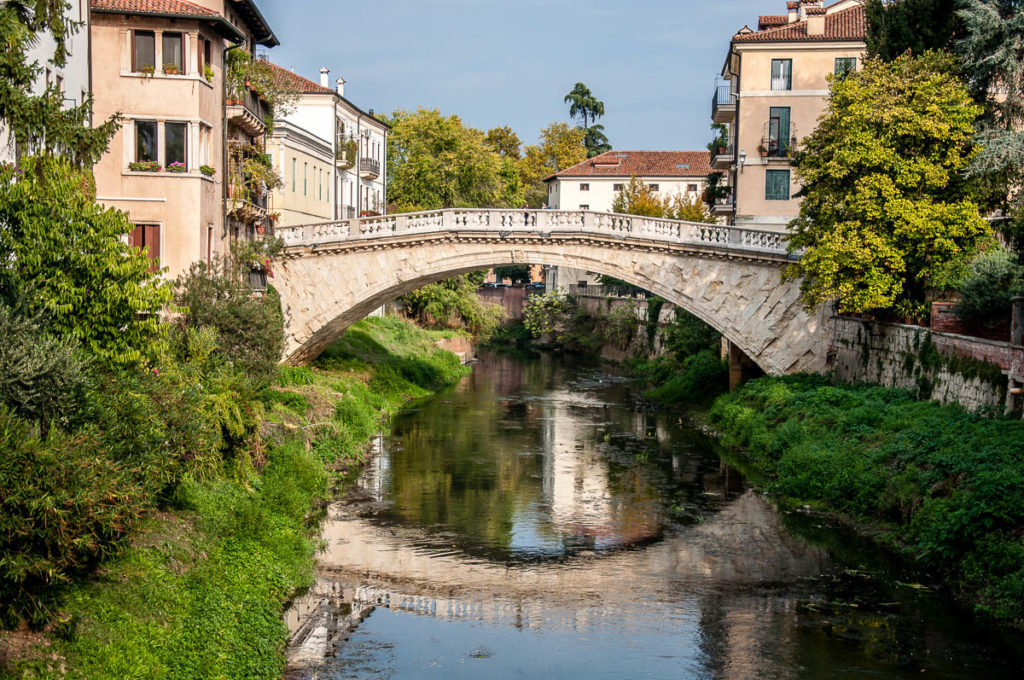
Retrone and Bacchiglione are the two main rivers that cross Vicenza’s historic centre. In addition, there is a handful of streams that meander through the city and have helped shape its landscape throughout the centuries.
In the past, deliveries of spices and other exotic products would arrive by riverboats from Venice . The clay-rich river banks would provide the raw materials for the blooming ceramics industry in the city. Water mills would work day and night along the rivers, and water would surround different parts of the centre which nowadays are completely drained and built on.
Thus several of Vicenza’s bridges have very old origins and three of them date back to Roman times.
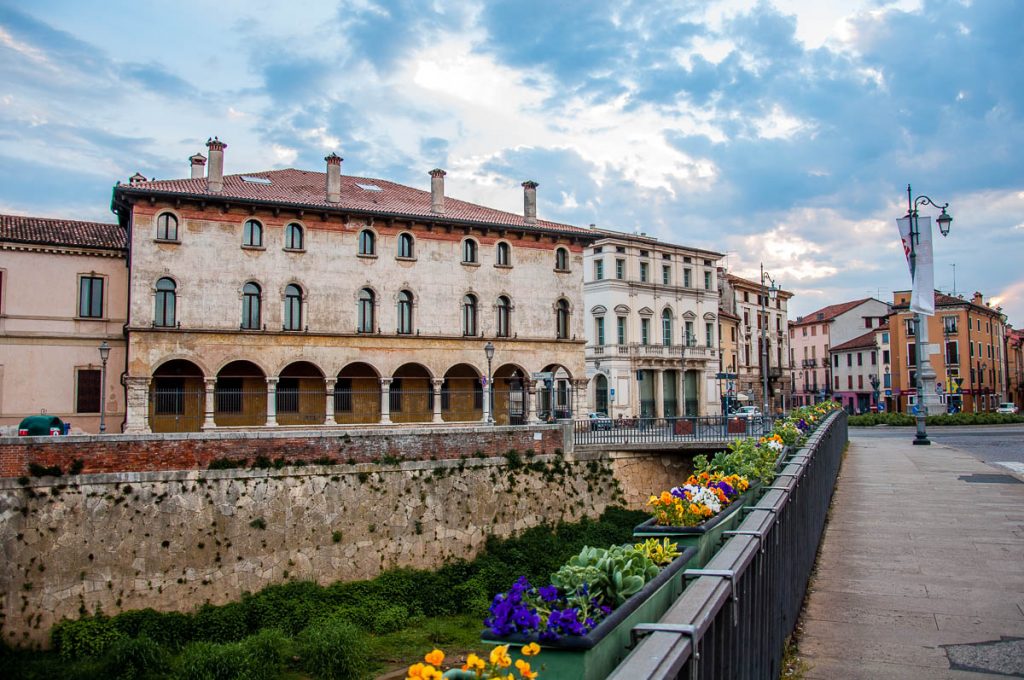
Cross the bridges of Vicenza to enjoy beautiful river views of this lovely Italian city and to delve deeper into its history and the stories of the people who shaped it. Here are some of the most interesting bridges in Vicenza to see at your leisure:
- Ponte dei Angeli – a bridge has been standing at this point over the curve of the river Bacchiglione since Roman times. Throughout the centuries the bridge has been rebuilt and modernised several times. Nowadays, it is surrounded by Renaissance palaces and it’s right next to one of the brightest gems in Vicenza’s crown – Teatro Olimpico (see point 2 above).
- Ponte Furo – this bridge was originally built by the Romans in the 2nd century AD. It was then enlarged and strengthened during the Middle Ages. It gives you one of the most iconic views of Vicenza’s Basilica Palladiana.
- Ponte San Michele – built between 1621 and 1623, it is considered to be the most beautiful bridge in Vicenza, Italy. It was designed by the architects Tomaso and Francesco Contini who also worked on the Rialto bridge in Venice . The German poet and philosopher Goethe fell in love with the elegant San Michele Bridge when he visited the city in September 1786.
- Ponte Pusterla – a large stone bridge that opens beautiful views over the river Bacchiglione and leads you straight into Vicenza’s historic centre. Here you can see the waterwheels of old mills that were once used for the thriving local manufacture of wool and fabrics.
- Ponte delle Barche – the oldest bridge in Vicenza. Its name – Bridge of the Boats – is due to the fact that this is where the boats leaving or arriving in Vicenza were loaded and unloaded.
There are many more bridges to see and cross in Vicenza. Not every one of them may have a curious story attached to it, yet all of them offer you the opportunity to enjoy some lovely waterside views of the city’s streets and facades.
17. Light a Candle in Vicenza’s Churches
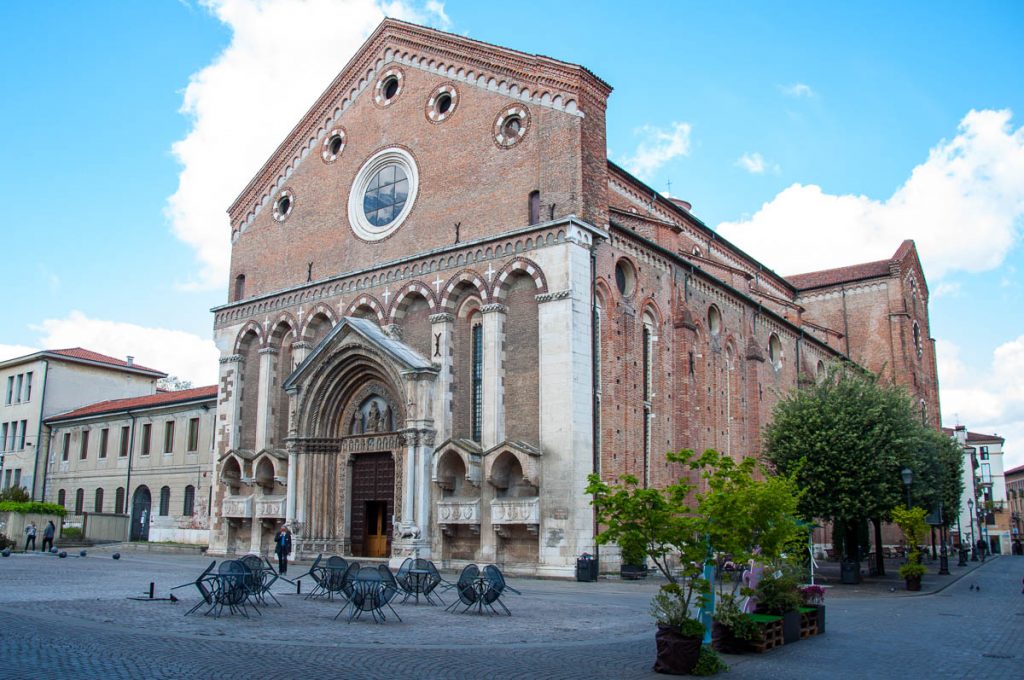
Just like every Italian city, Vicenza is dotted with churches. Small ones and big ones, old ones and new ones, lavishly decorated cathedrals and simple chapels.
Even if you are not a practising Christian or have a complicated relationship with religion, visiting Vicenza’s churches will give you the opportunity to explore in-depth the history, the art, and the architecture of this charming Italian city.
Churches here are very much part of the living fabric of the city. Mass is regularly held, people pop in to say a prayer on their way to work, and beautiful flower arrangements decorate the altars showing that a caring hand is making sure that the House of God is always a warm and welcoming place.
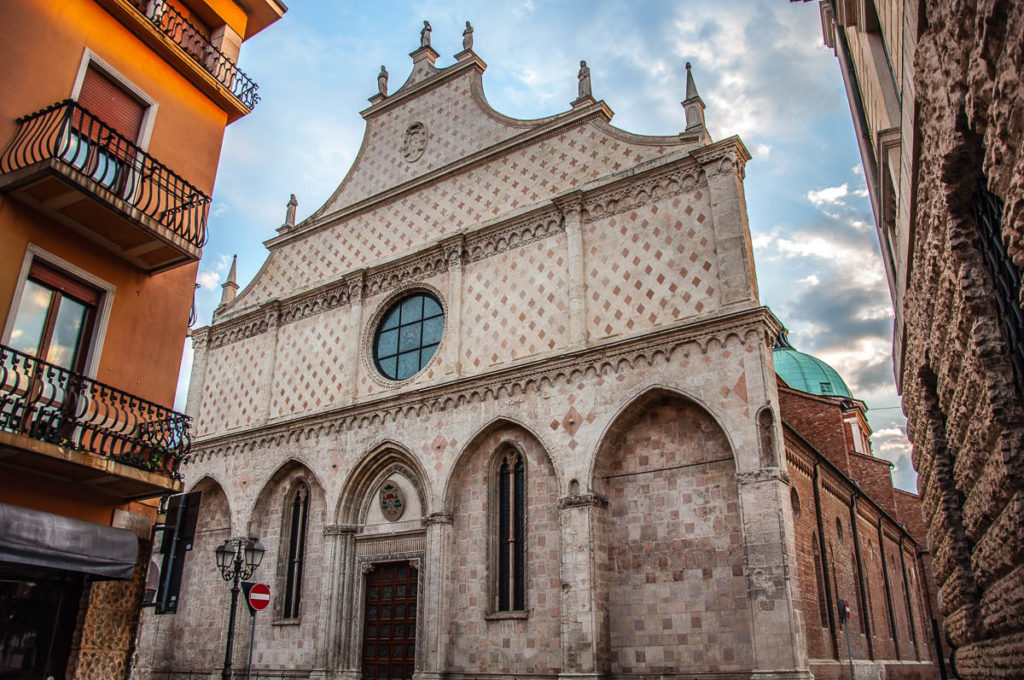
So, here is a short list of some of the most interesting churches to see in Vicenza:
- Duomo of Vicenza – the Cathedral of Santa Maria Annunciata is just a few steps away from the Basilica Palladiana. With its enormous body and imposing facade, it’s a must-see sight during a visit to Vicenza. Underneath it lie the ruins of the Roman town of Vicetia (see point 11 above). Its dome and Northern door were designed by Andrea Palladio (see point 3 above). Vicenza’s Duomo was heavily damaged during the Allied Forces’ bombardments of Vicenza in the Second World War. The dome, large portions of the nave, and the southern chapels were destroyed. Thus the Duomo lost the sumptuous frescoes that covered its interior. The way you see it nowadays is the result of a significant restoration effort.
- Sanctuary of Monte Berico – please, see point 14 for lots of information about this church in Vicenza. It is one of the most important sanctuaries dedicated to the Virgin Mary in Italy and it was built at the spot at which the Virgin appeared twice to a peasant girl in the first half of the 15th century.
- Church of Santa Corona – please, see point 13 for lots of information about this church in Vicenza. It is one of the most important sights to see in this Italian city for its art, architecture, and history.
- Church of San Lorenzo – you will find this large church alongside Corso Fogazzaro – one of the main streets in Vicenza’s historic centre. It has a splendid 14th-century marble portal and a small pleasant cloister. Just outside of the church, you can see a portion of an ancient Roman road.
- Church of Santa Croce ai Carmini – my favourite church in Vicenza. This is a peaceful place where you can spend precious minutes completely by yourself looking at the huge blue ceiling. At Christmas, here you will find one of the most elaborate Nativity Scenes in town. Among the many altarpieces that you can admire here is a large canvas attributed to Paolo Veronese.
- Basilica of Santi Felice and Fortunato – the oldest church in Vicenza is just outside of the city’s historic centre. It was originally built right after Christianity became the official religion of the Roman Empire. Inside you can see mosaics from the Late Antiquity and trace the different architectural styles that were adopted during the many consecutive remodellings of the church. Outside, there is a small museum area with archaeological artifacts.
There are many more churches all over Vicenza. Each has its own story and precious works of art. If you are passing by a church in Vicenza that is not on the above shortlist, don’t miss the opportunity to walk in and get close to another piece of the history and traditions of this lovely Italian city.
Bear in mind that tourist visits are not allowed if a mass is in progress. Also, please, make sure that you wear appropriate clothing. Shoulders and knees have to be covered.
- San Lorenzo Church – Fine Gothic Architecture in the Heart of Vicenza
18. Indulge in Shopping and Palazzo Spotting on Corso Palladio – Vicenza’s Elegant Main Street
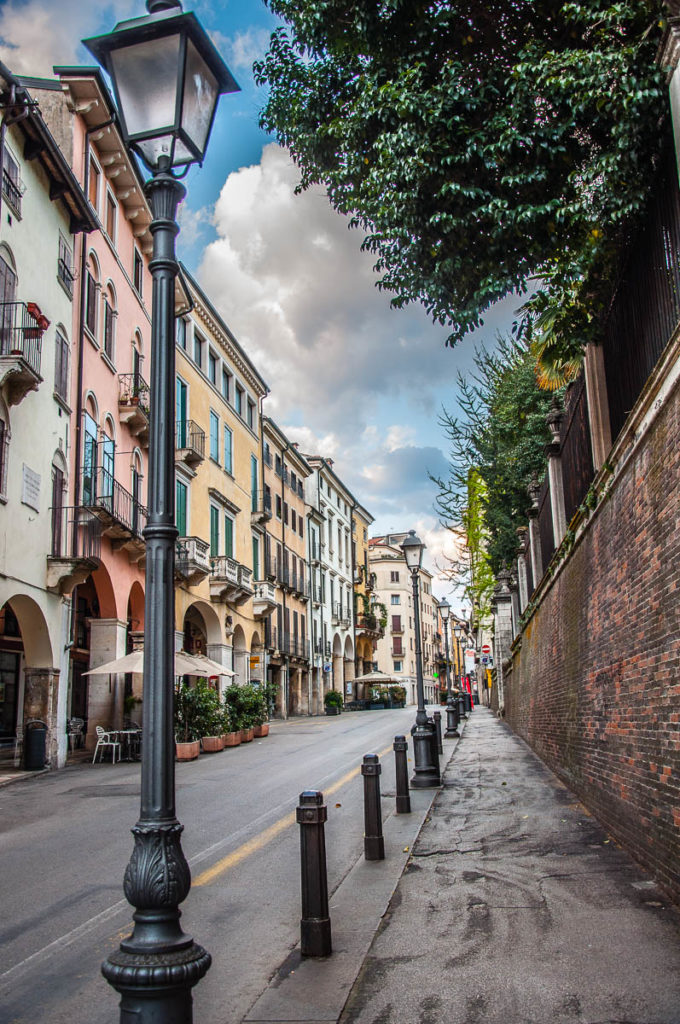
Corso Palladio is Vicenza’s elegant main street. Dotted with historical palaces and fashionable boutiques, you will find yourself traversing it several times during your visit to this small Italian city.
About 700 m long, Corso Palladio runs across Vicenza’s historic centre. From Teatro Olimpico at one end to the medieval Torrione at the other, almost everything that is worth seeing here is either on or near Corso Palladio.
The most curious thing about Corso Palladio is that it follows the line of the Roman Decumanus Maximus. This was the main street of the Roman city of Vicetia (see point 11 above). It led to Aquileia to the east and to Verona to the west.
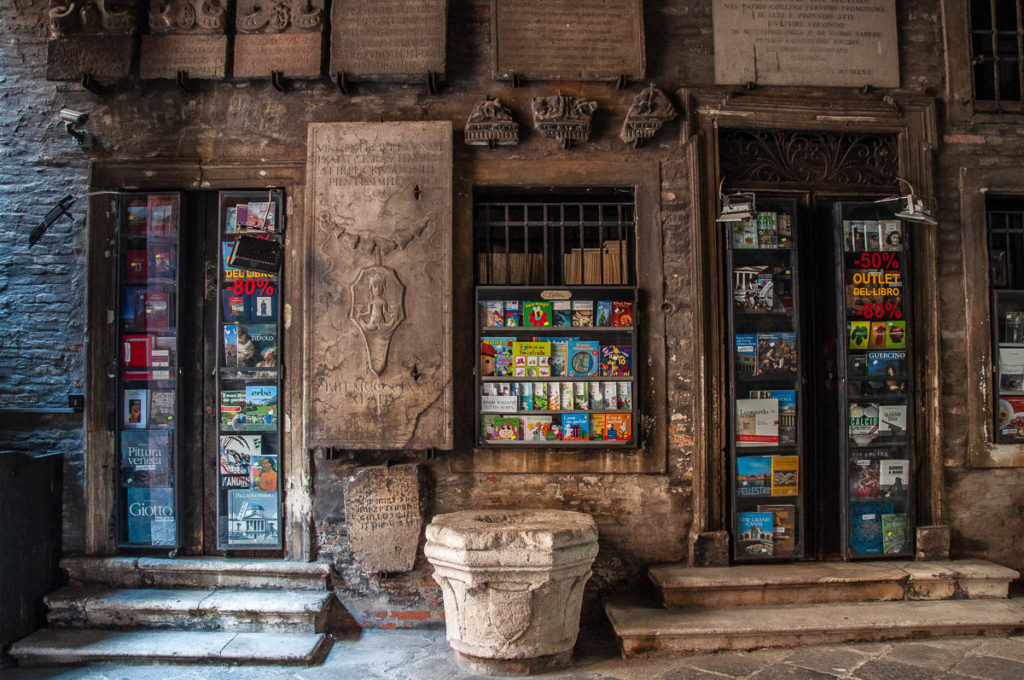
Here are some of the most interesting buildings you can see along Corso Palladio in Vicenza:
- Teatro Olimpico – please, see point 2 above for detailed information about Teatro Olimpico and why it is one of the brightest jewels in Vicenza’s crown.
- Palazzo Chiericati – please, see point 5 above for detailed information about Vicenza’s Civic Art Gallery which is housed in the Palladian Palazzo Chiericati.
- Casa Cogollo – a small house with a narrow facade right next to the lush garden of the Church of Santa Corona. According to popular belief, it was the house where Andrea Palladio resided during his time in Vicenza. In fact, Palladio didn’t live here but allegedly was contracted by the owner of the house – the notary Cogollo – to remodel its interior spaces and restructure its facade. The elegant facade was frescoed in the 16th century by the painter Giovanni Antonio Fasolo. Unfortunately, nowadays it retains only a pale blurred shadow of the original frescoes.
- Church of San Gaetano – sandwiched between the adjacent buildings, this church has a truly imposing facade and a front door that can easily accommodate a giant. The church was badly bombed by the Allied Forces during the Second World War thus losing much of its pictorial richness and its musical organ. It was restored in the years after the end of the war.
- Ca’ d’Oro – one of the most splendid palaces in Vicenza. Its facade is richly decorated and I have spent many moments trying to decipher the different figures and symbols chiseled on it. The atrium of the palazzo is open to the public and houses a small archaeological collection. The inner cobbled courtyard has one of Vicenza’s most picturesque wisterias.
- Palazzo Trissino – a long and proud 16-century building with a beautiful portico supported by mammoth columns. It serves as Vicenza’s City Hall.
- Il Torrione – an imposing medieval tower that is a remnant of Vicenza’s no longer existing Scaliger Castle . It dominates the landscape of Vicenza’s historic centre. An exhibition space dedicated to contemporary art occupies the tower’s top floors. A visit to Il Torrione will allow you to enjoy a breathtaking view of Vicenza from a height of 60 metres.
Then, of course, you have so many opportunities to indulge in a spot of shopping here. Italian and multinational brands stand side by side on Corso Palladio. From make-up, jewellery, and clothes to delis selling traditional food and cafes serving proper Italian coffee , exploring Corso Palladio is a delightful way to spend an hour or two in Vicenza, Italy.
More information:
- Official website of Ca’ d’Oro
- Official page of Palazzo Trissino
- Official page of Il Torrione
19. Have Fun at a City-Wide Event in Vicenza
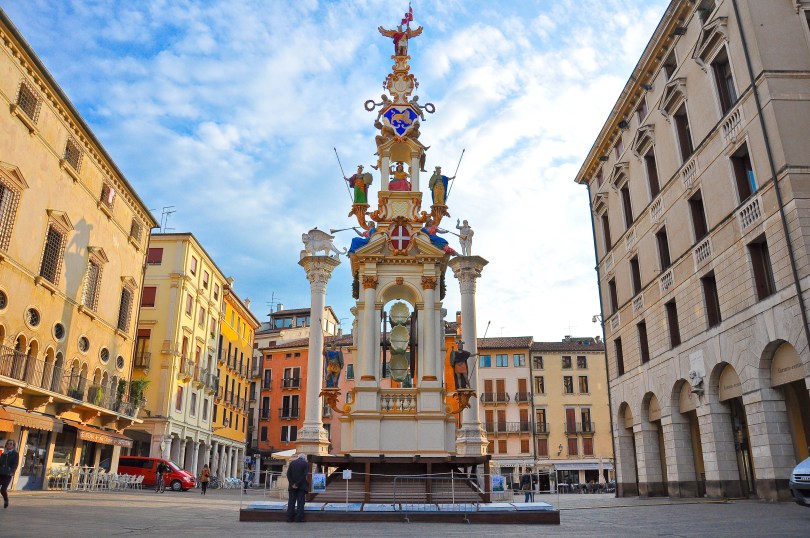
At first glance, Vicenza may seem like a small and sedate town where not much is happening on a daily basis. In comparison with the vibrant Verona and the eternal student city of Padua , Vicenza really is like their boring cousin.
Don’t let this potentially put you off Vicenza, though. The city hasn’t lost its ability to party and on the days when a city-wide event or festival is held here, you will find Vicenza full of verve and colour.
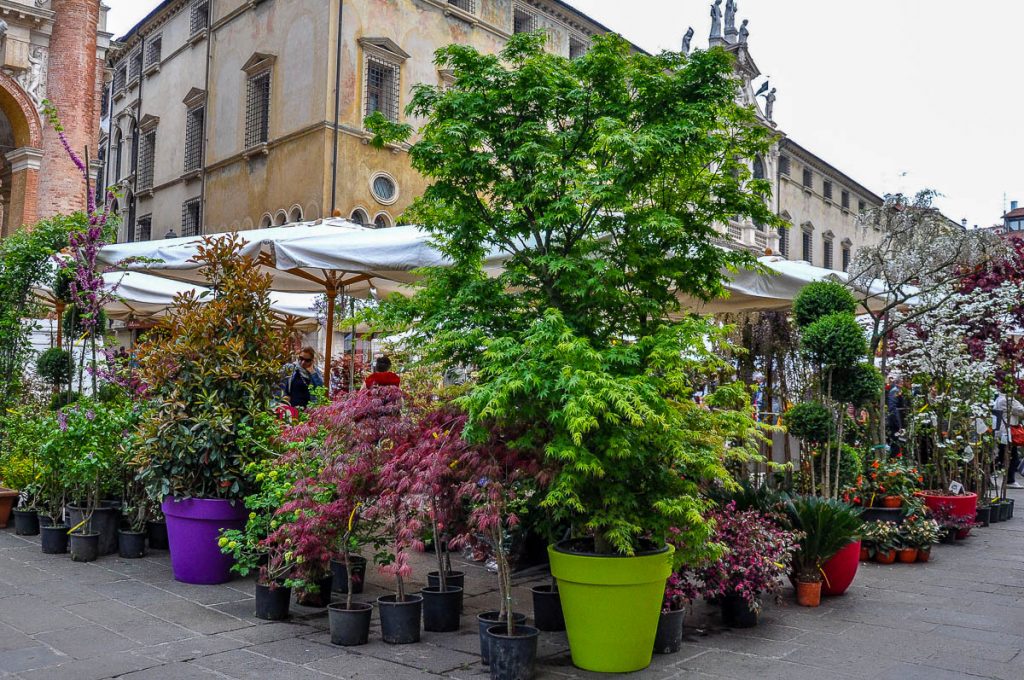
Here are just a few of the events that are really worth it to be experienced in Vicenza. Take your pick:
- Floriculture and Horticulture Festival – held every spring, this is a beautiful weekend-long festival dedicated to flower- and plant-growing. Piazza dei Signori – Vicenza’s main square – becomes a huge garden and dozens of stalls sell potted plants, shrubs, and even fully-grown trees.
- Chocolate Festival – held every October, this is a yummy weekend-long festival when stalls selling chocolate in hundreds of varieties and shapes take over Vicenza’s historic centre.
- Vicenza Oro – one of the world’s largest and most important jewellery trade fairs. It has a rich programme of cultural events taking place in Vicenza’s historic centre.
- Giro della Rua – a traditional for Vicenza celebration with centuries-old roots. Its focal point is a tall structure called La Rua which is erected every two years on Piazza dei Signori.
- Antiques market – held monthly except during the hot summer months, this is where you will find oodles of vintage and antique items – glass, paintings, furniture, hats, jewellery, prints, and so on.
- Twice-weekly market – selling anything and everything from fresh produce, cheese , and fish to curtains, pans, and honey, this is a traditional Italian market that takes over Vicenza’s Piazza dei Signori and adjacent streets every Tuesday and Thursday. You need to be quick though as the market starts early in the morning and by 1 pm the stalls start closing and the market vans take away the abundance of cheap clothing, tablecloths, socks, bags, and hundreds of other items.
Plus, there are many more events taking place here. A jazz festival, Christmas celebrations, large-scale exhibitions, food festivals… You name it!
When you visit Vicenza, make sure that you pop into the city’s Tourist Information Office (which is next door to Teatro Olimpico) and ask what’s on in town during the day(s) of your being here. You never know! You might be lucky and have a chance to share an unforgettable experience with the citizens of Vicenza. Enjoy!
- Official website of CioccolandoVi – Vicenza’s Chocolate Festival
- Official website of Vicenza Oro
- Official website of Non ho l’eta’ – Vicenza’s monthly antiques market
- CioccolandoVi – A Chocolate Festival in Vicenza, Italy
- Il Giro della Rua 2017 – Vicenza is Getting Ready for its Biggest Celebration
20. Take Part in a Traditional Italian Passegiatta in Vicenza
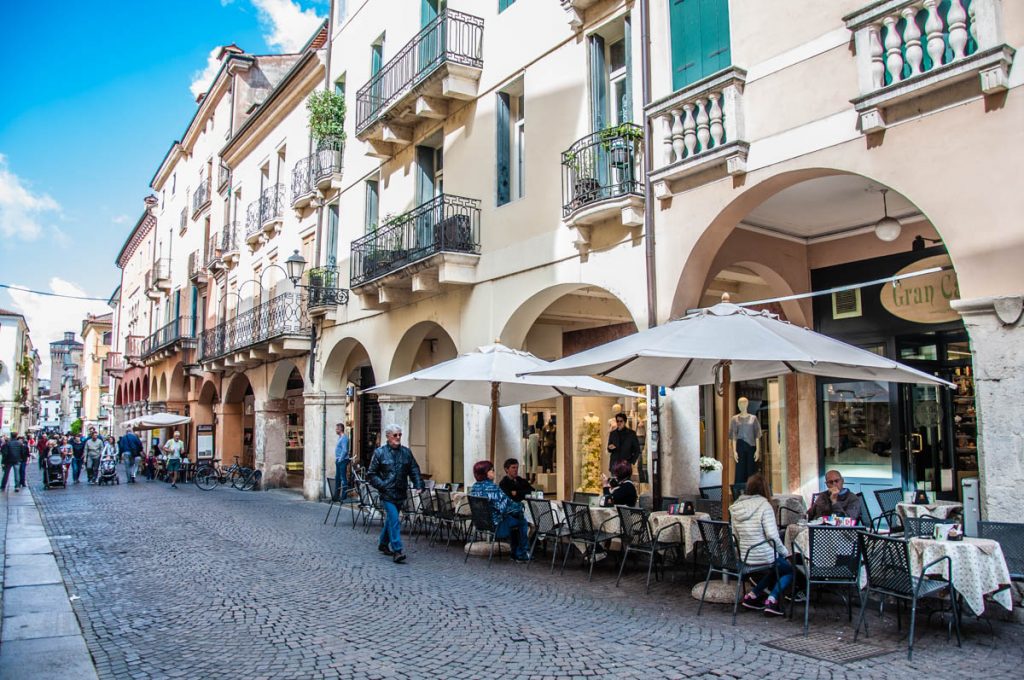
A passeggiata is a leisurely walk that the Italians take in the evening traditionally dressed up to the nines. The goal is to see things, to be seen, and to socialise. It is a very pleasant social ritual that results in historical squares and streets all across Italy bubbling with life and laughter long after the sun has set on a nice and warm day.
With the temperatures rising from the end of February onwards (in spite of the occasional April shower or May downpour), an evening stroll is a lovely way to relax after a hard day of sightseeing and to indulge in some authentic dolce vita . You will see people enjoying an aperitivo over a nice selection of nibbles, whole families out and about with a gaggle of kids ranging from newborns to late teens, and bars, cafes, and coffee shops staying open late into the night. This is also often accompanied by seasonal events, DJ sessions, and live music.
The turnout is at its best over the weekend but the closer to the summer you get, the bigger the crowds of people engaging in a passeggiata on a weeknight grow. All in all, a passeggiata is a very civilised thing! It gives you time to talk to the people closest to you, to feel part of the community, and to take it easy over a nice glass of aperitivo or two.
Taking part in a passeggiata also gives you a very good idea of the unspoken rules of the Italian society – from how to dress to how to behave with decorum. It’s a mesmerising peek into Italy’s culture.
So, when in Vicenza, don’t miss your chance to go for a little passeggiata or two. The passeggiata hotspots in town are Piazza dei Signori, Corso Palladio, Corso Fogazzaro, and the smaller streets and squares around them.
21. Get to Know Vicenza’s Centuries-Old Jewellery-Making Traditions
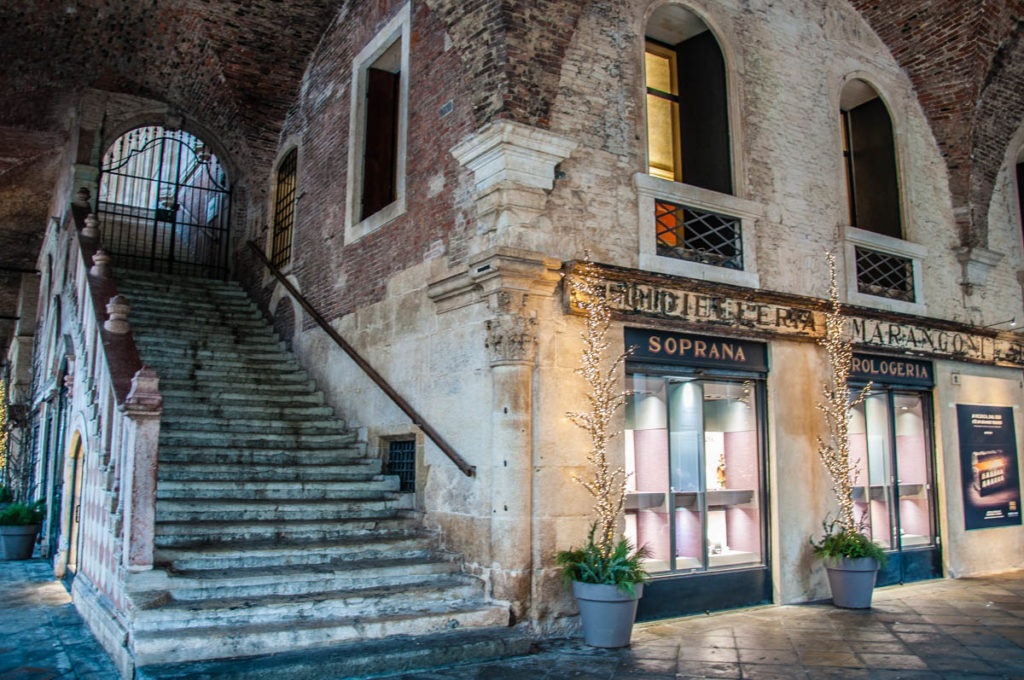
Vicenza has been a centre of goldsmithing and jewellery production since the Middle Ages.
The foundations of a 13th-century jewellery-making workshop can be seen covered with protective glass sheets on the ground floor of the city’s Jewellery Museum. There is also a faded fresco on one of the walls – a remnant of the goldsmiths’ private chapel.
To this day jewellery is incredibly important to Vicenza. The city produces one-fifth of all of Italy’s gold jewels. Dozens of businesses – from tiny one-man artisanal workshops to multinational brands with shops all over the world – are the backbone of Vicenza’s jewellery manufacture.
You will see that jewellery shops abound in the historic centre. Twice a year, the city also hosts VicenzaOro – one of the world’s leading jewellery trade exhibitions.
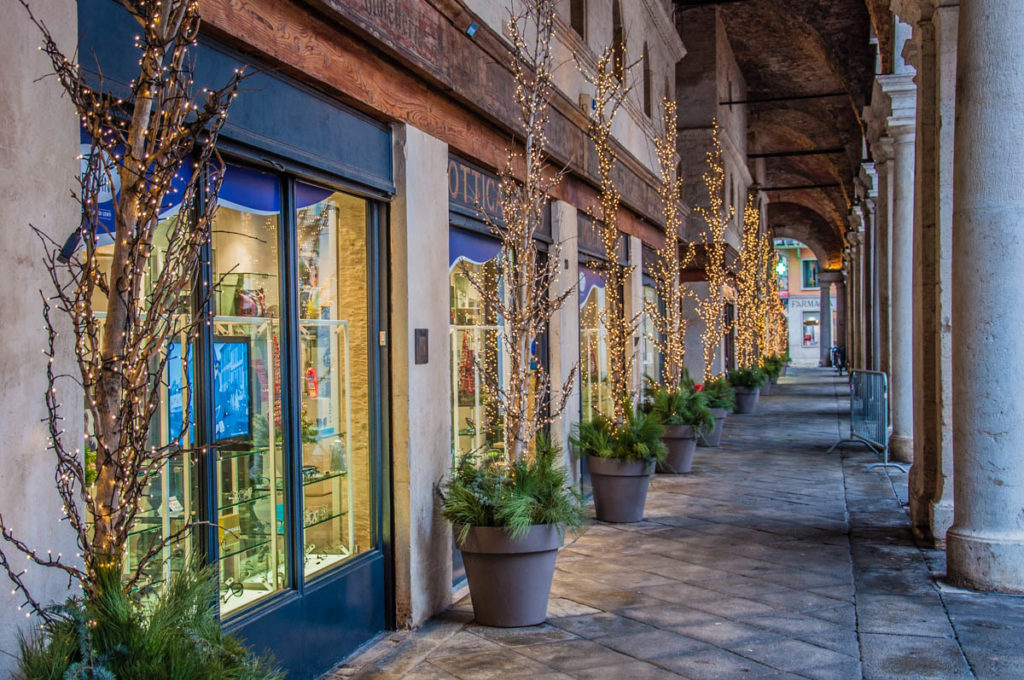
Here are some places around town where you can admire the local jewellery-making traditions and shop for locally made pieces:
- Jewellery Museum – the first Jewellery Museum in Italy. It opened its doors in December 2014. Its permanent display changes every couple of years. In addition, the museum holds many temporary jewellery exhibitions.
- Artisan jewellery makers – there are many artisan goldsmiths and jewellery makers whose studios and workshops are dotted around Vicenza. At this link , you can find direct connections to the websites of some of Vicenza’s best jewellery makers.
- Unique jewellery shops – go for a walk around the ground floor of the Basilica Palladiana (see point 1 above). You will see many cute as a button jewellery shops selling unique and wonderful jewels. A special mention deserves the Loving Palladio jewellery line created by Soprana – one of Vicenza’s historic jewellery shops.
- Jewel of Vicenza – a stunning three-dimensional sterling silver model of the historic centre of the city of Vicenza. The original was made in the 16th century allegedly following a model by Andrea Palladio. Unfortunately, it was stolen by the Napoleonic army and destroyed. In 2012-13, the Jewel of Vicenza was re-created and nowadays, it can be admired in Vicenza’s Diocesan Museum (see point 12 above). It has a truly fascinating story and it is breathtaking to see up close. Vicenza’s historic buildings – churches, palaces, and the Basilica Palladiana – are made of silver in incredible detail.
To admire two of the most stunning examples of the heights of the goldsmithing art of Vicenza, head to the Sanctuary of Monte Berico (see point 14 above). The statue of the Madonna of Monte Berico inside the Sanctuary is adorned with a breathtaking crown and pectoral necklace. Created specifically for the coronation of the Madonna (held on 25th August 1900), the two jewels were restored in the year 2000 by one of Vicenza’s most prominent jewellers – Stefano Soprana.
- Official website of the Jewellery Museum
- Wikipedia page of the Jewel of Vicenza
22. Discover the History and Traditions of Italian Food at Biblioteca La Vigna in Vicenza
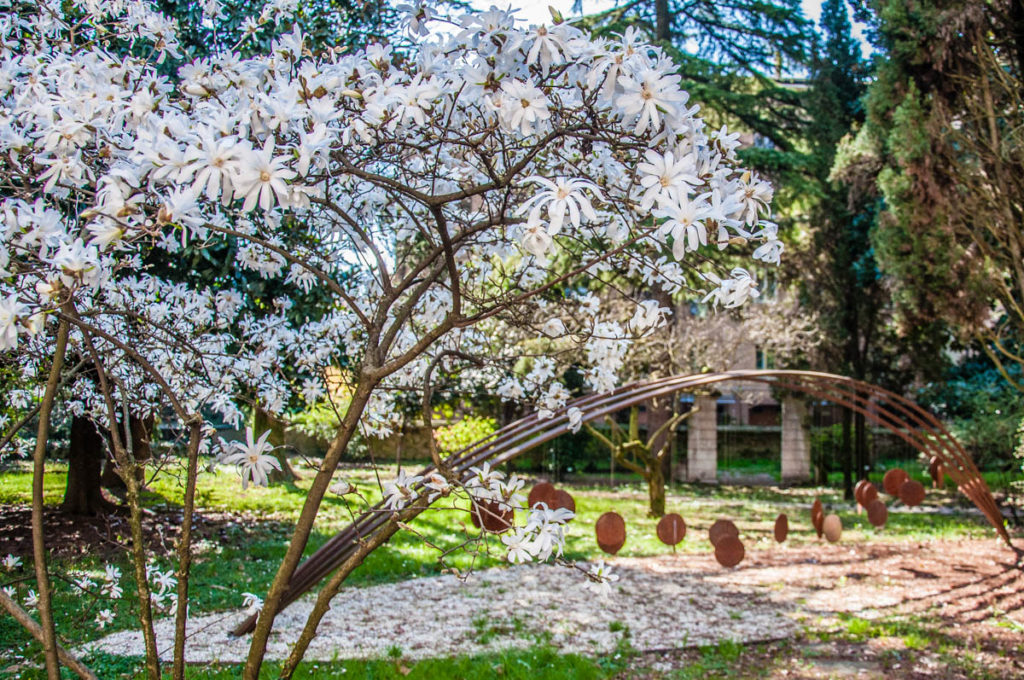
Biblioteca La Vigna is one of Vicenza’s most intriguing hidden gems.
Housed in the Palazzo Brusarosco-Zaccaria, you will find this wonderful library just a few steps away from the Church of Santa Croce ai Carmini. The library is entirely dedicated to books about food. It has an incredibly rich collection of cooking books, recipe compendiums, and writings on food and wine culture and production.
In addition, Biblioteca La Vigna encompasses the Centre for Rural Culture and Civilisation so that – in one place – you can research and learn about food growing and rearing in Italy over the centuries. It is a great source of information on anything related to Italy’s agriculture.
Biblioteca La Vigna holds dozens of thousands of books and documents in its archives – from ancient tomes to new releases. I have spent many happy hours researching Italian food and culinary traditions in the library’s quiet reading rooms.
The library has two more points of attraction. One is the adjacent garden (see point 23 below) with the installation Galileo’s Moons in its centre. The other is the palace’s top-floor flat. Both were designed by the renowned Italian architect Carlo Scarpa.
- Official website of Biblioteca La Vigna
- The Surprising Italy: Galileo’s Moons
23. Go for a Walk in Vicenza’s Green Spaces
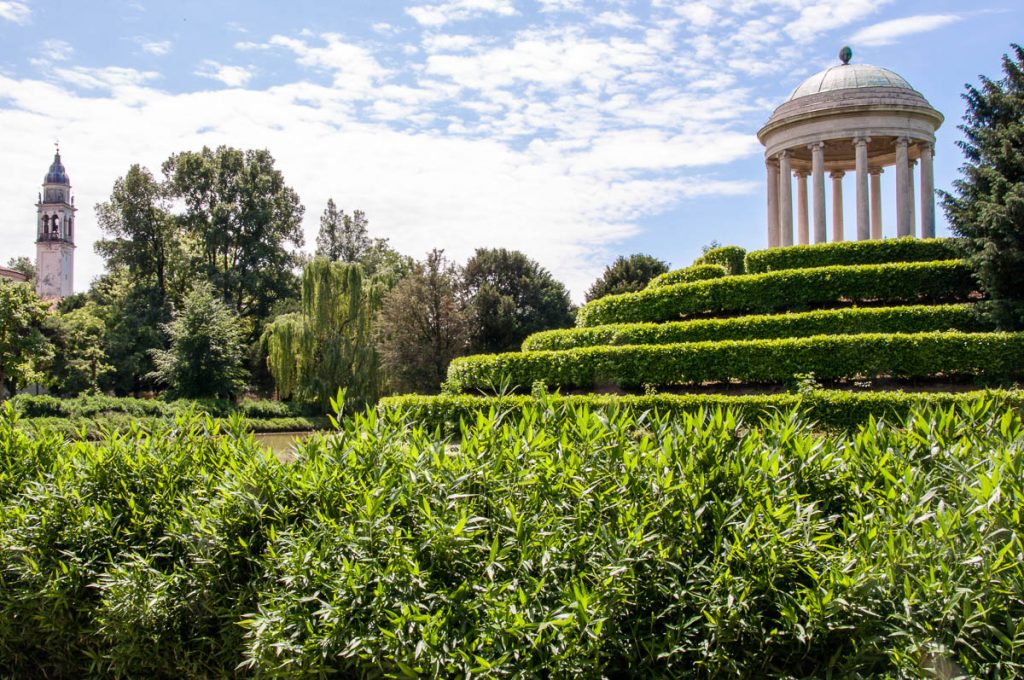
At first glance, Vicenza looks like a densely populated city with hardly a place left for a walk or a moment of relaxation surrounded by nature. Yet, and just as long as you know where to look, soon you will discover that Vicenza is a rather green place and flowers in bloom adorn thousands of balconies and windows all over town.
While many buildings present their formal facades to the streets of Vicenza, at their backs lush private gardens are hidden. Trees and small green patches are everywhere. Plus, within a short distance from the city centre, you can find several beauty spots and a couple of small lakes to quickly get in touch with nature when you need it.
Spring is an especially beautiful period to be in Vicenza. This is when large wisterias drape their bunches of purple petals all over balconies and fences. A large open-air flower and plant market takes place in town every April.
The rest of the year, the green-fingered people of Vicenza turn their balconies into veritable hanging gardens and it is always a pleasure to walk around town while looking up to admire the colourful blooms streaming down the facades of centuries-old buildings.
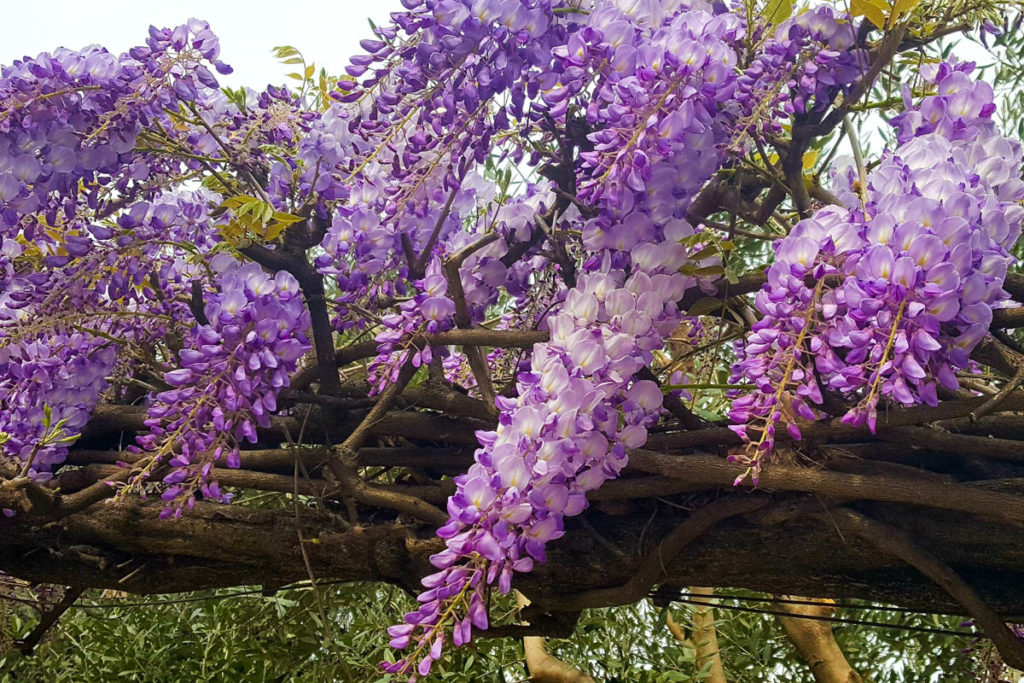
So, in case you want to go for a walk or a spot of relaxation in Vicenza’s green spaces, here is a nice and tidy shortlist to help you find your way to the nearest one:
- Parco Querini – this is a lovely park just ten minutes or so away from Vicenza’s historic centre. It has a large open green space, a pond with an island crowned by a small temple, an alley flanked by centuries-old statues, and a dense copse of trees in the middle. Plus a gaggle of chickens, ducks, and turtles. You may even spot a nutria or two – a large rodent with long orange front teeth.
- Garden of Teatro Olimpico – my favourite green space in Vicenza. You can sit and relax surrounded by 19th-century statues and archaeological artifacts. When the orchestra rehearses inside, the music comes softly in waves as you quietly sit on one of the side benches.
- Cloister of the Church of San Lorenzo – a peaceful green area you can see as part of your visit to the Church of San Lorenzo (see point 17 above).
- Giardini Salvi – a small garden at the very start of Corso Palladio and on a straight line from Vicenza’s train station. Inside, you can admire one of Palladio’s famous buildings – the Loggia Valmarana.
- Campo Marzo – a wide green just outside Vicenza’s train station. It can be fun to visit during city-wide events and celebrations when a fair sets its stalls and rides here. It also has a large, gated playground.
- Garden of Palazzo Brusarosco-Zaccaria – a large garden off the beaten track in Vicenza’s historic centre. Populated by many different varieties of trees and shrubs, in its middle you will see a large installation called Galileo’s Moons which serves as a huge wind chime. Not many people know about this garden and it is quite nice to spend a few minutes here with your own thoughts. Plus, it’s in the same space as Biblioteca La Vigna (see point 22 above).
- Oasi Stagni Casale – a nature oasis set up in old clay quarries. A paradise for nesting birds and all sorts of other animals. A great spot for bird watching, it is only a bus ride away from Vicenza’s historic centre.
- Valetta del Silenzio – an expansive green space just outside Vicenza’s historic centre. You will find it next door to the world-renowned Villa Capra la Rotonda by Andrea Palladio (see point 3 above). If you love walking, then you can hike from Valletta del Silenzio all the way up to the large park of Villa Guiccioli (see bellow).
- Garden of Villa Guiccioli ( Museum of Risorgimento ) – if you make it to the top of Monte Berico and have an hour to spare, you can walk further down the road to the Museum of Risorgimento and Resistenza. Housed in a former villa, it is surrounded by a lovely garden with hundreds of different species of trees, shrubs, and plants – from local specimens to exotic ones.
Even if your time in Vicenza is limited and you can’t put an hour aside to explore one of the city’s green spaces, you will never be too far from blooms and petals here.
Many balconies around Vicenza have been turned into veritable hanging gardens . So, you just have to look up as you walk around town to be regaled with inspiring views of plants and flowers.
- Opening times of Vicenza’s Historic Parks and Gardens
- Official website of Oasi Satgni di Casale
- Official website of the Garden of Palazzo Brusarosco-Zaccaria
- 6 Hidden Corners Around Vicenza, Italy to Quickly Get in Touch with Nature When You Need It
- Photos of the Garden of Teatro Olimpico
- Exploring Vicenza: Parco Querini
- The Hanging Gardens of Vicenza, Italy – Italian Balconies at Their Best
- Lago di Fimon – A Pleasant Lakeside Walk Just Outside Vicenza, Italy
24. Explore Vicenza’s Elegant Venetian Villas
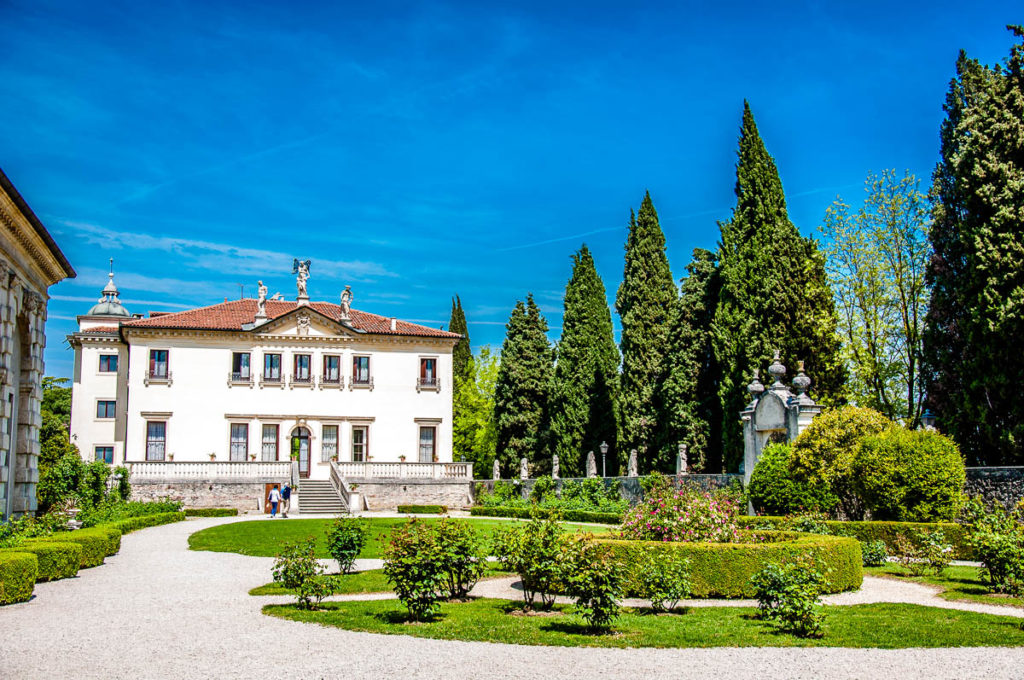
There are many gorgeous villas dotted around the countryside of Vicenza.
In Veneto’s context, a villa is a beautiful country house with refined architecture and often surrounded by a gorgeous garden or a nice park. In the past centuries, the Venetian nobility would spend their summers in such villas to oversee the tending of their lands and to enjoy the fresh air.
Thus the Venetian villas were both the central point of active agricultural work and an escape from the constraints of city life during the year’s hottest months. The villa would offer all sorts of comforts to the family of the Venetian nobleman and their relatives and friends. At the same time, the man of the house could easily oversee the many different stages of crop cultivation, wine production, and any other sort of farm activity.
Designed by famous architects and frescoed by the most renowned artists of the day, the villas of Veneto could have a long list of both practical and whimsical amenities – from storage places for machinery and crops to ice houses where large pieces of ice would be preserved in winter to be used to cool the beverages of the noble ladies and gents all summer long.
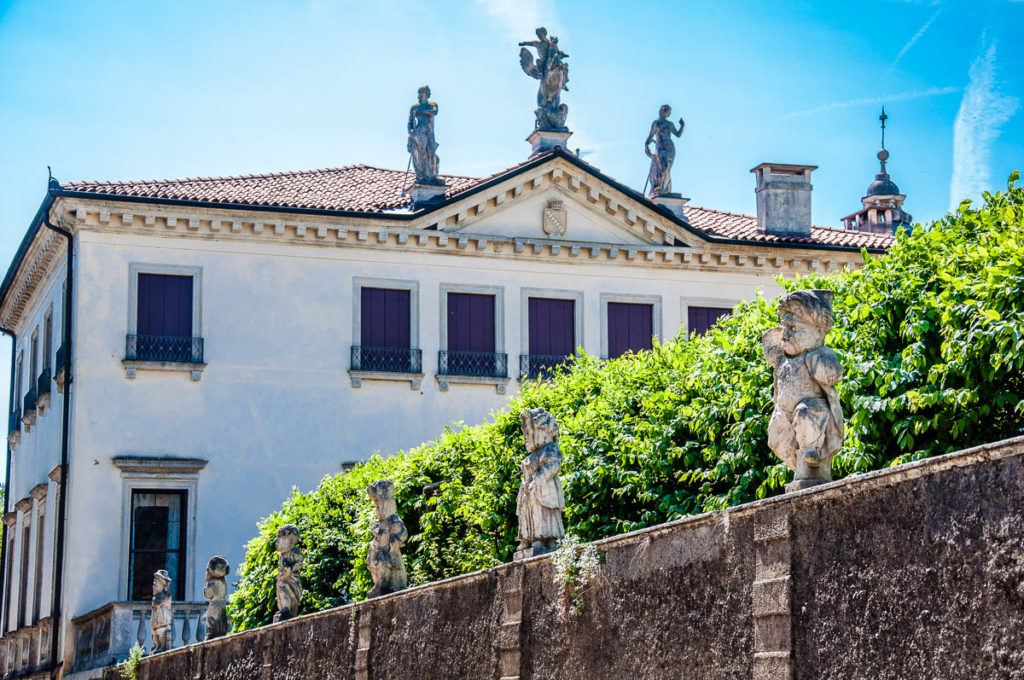
Several lavish Venetian villas with illustrious history and splendid architecture can be easily visited from Vicenza. Here are three for your interest:
- Villa Capra La Rotonda – probably the most famous Venetian villa in the world, this is a splendid Palladian cube-shaped building with four identical facades. You will find it on the outskirts of Vicenza and can easily walk to it from the city’s train station. For maximum enjoyment the villa needs to be seen both on the inside and the outside.
- Villa Valmarana ai Nani – a true gem of architecture and art, this villa enjoys stunning views of Monte Berico (see point 14 above). The villa is famous above all for its splendid frescoes by father and son Giambattista and Giandomenico Tiepolo. A stone path connects Villa Valmarana ai Nani to Villa Capra La Rotonda, so quite conveniently, you can visit both in one morning or afternoon.
- Villa Caldogno – allegedly designed by Andrea Palladio, this villa is lavishly frescoed inside. In its garden, you can also visit a bunker from the Second World War. You can easily reach the villa from Vicenza’s historic centre by taking bus number 9.
25. Take a Trip to a Hidden Gem or Two Near Vicenza, Italy
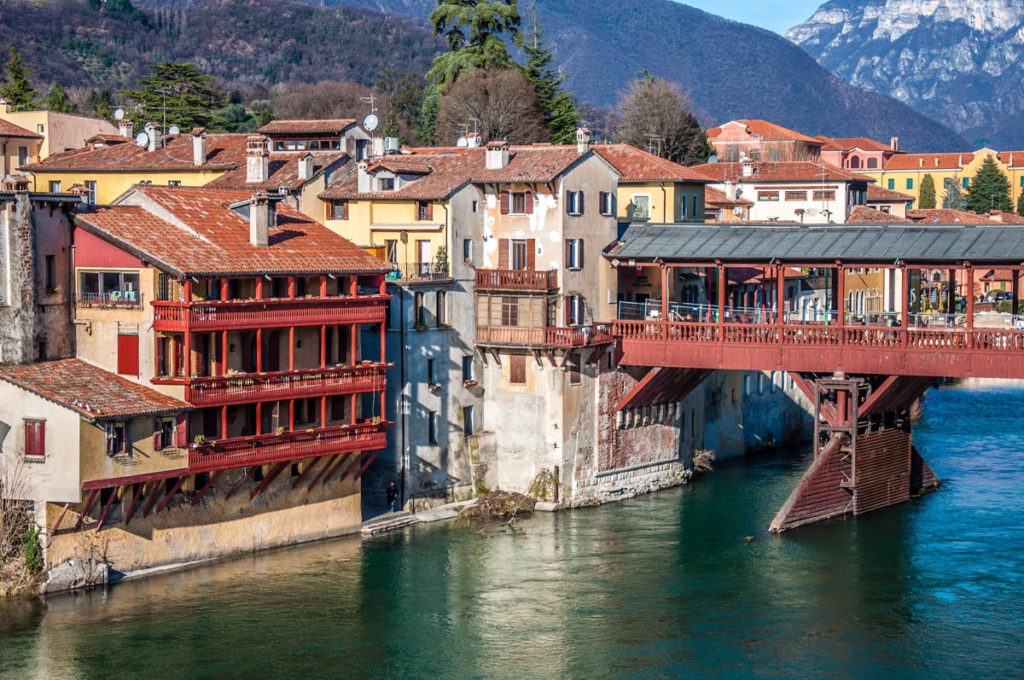
Within a very close distance to Vicenza – I mean 15 minutes to an hour away – you will find a plethora of wonderful and whimsical places to happily spend a day at.
From medieval walled towns to sights of natural beauty, from active monasteries to vineyards and wineries, from spa towns to hilltop castles, from patrician villas to some of Italy’s most beautiful villages , the choice really is yours.
The area around Vicenza is densely packed with sights giving you so many options for an unforgettable day out. Plus, as the distances are so short, you can easily pack two or even three places in a day.
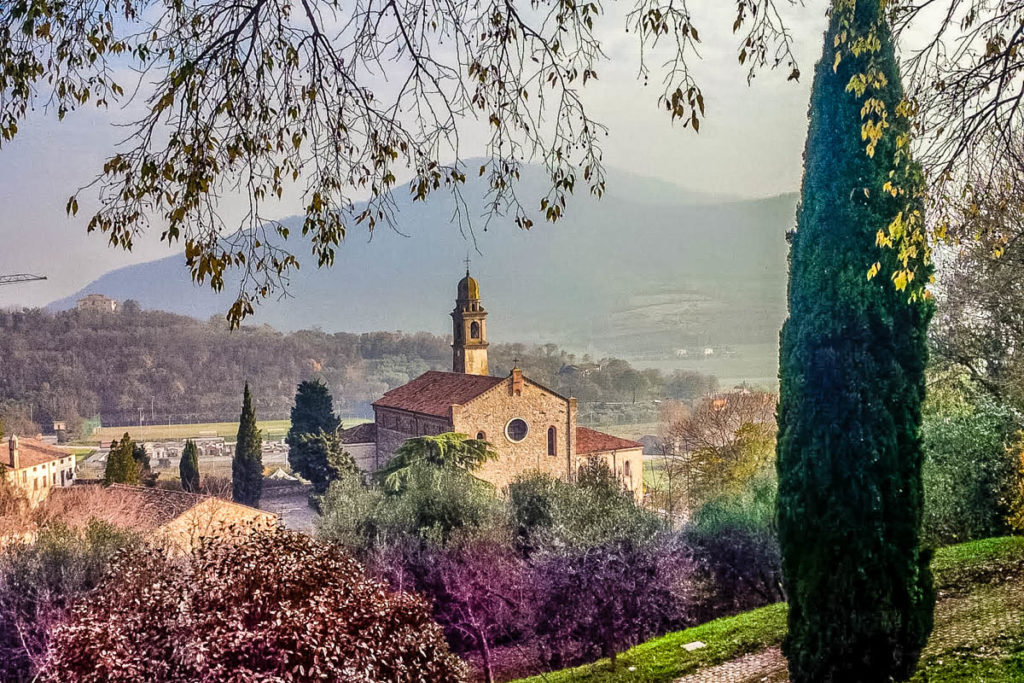
Here are some of my favourite destinations:
- Medieval walled towns: Este , Montagnana , Monselice , Marostica , Soave , Cittadella , Castelfranco Veneto , Chioggia , Bassano del Grappa
- Beautiful villages : Asolo , San Giorgio di Valpolicella , Arqua Petrarca , Borghetto sul Mincio
- Hills, lakes, and hikes: Euganean Hills , Berici Hills , Asolo Hills, Lake Fimon
- Spa towns and destinations: Abano Terme, Galzignano Terme, Montegrotto Terme
- Day Trips from Vicenza, Italy – Over 90 of the Best Destinations
- 8 Most Beautiful Villages to Visit in the Veneto, Italy
- 20 Family-Friendly Walks and Hikes Up to an Hour and a Half from Vicenza – First Part and Second Part
- Gorgeous Lakes in Veneto, Italy You Have to See for Yourself (With Map and Useful Details)
Map of the Main Sights and Attractions in Vicenza, Italy
Here is a nice and useful map pinpointing the exact locations of Vicenza’s main sights and attractions. You can use it to help you decide what to see in town and in what order, to calculate distances and check walking directions, driving instructions, and public transport options. Click on the map to zoom in and out, to see Street View, and to use all the usual functions that a map made in Google Maps traditionally offers.
In addition, here is a list of Vicenza’s sights and attractions included in this map: 1. Basilica Palladiana 2. Piazza dei Signori 3. Torre Bissara 4. Palazzo del Capitaniato 5. Monument of Andrea Palladio 6. Ponte San Michele 7. Teatro Olimpico 8. Palazzo Chiericati 9. Church of Santa Corona 10. Archaeological Museum 11. Gallerie d’Italia in Palazzo Leoni-Montanari 12. Ca’ d’Oro on Corso Palladio 13. Memorial Plaque of Luigi da Porto 14. Pigafetta’s House 15. Criptoportico Romano 16. Duomo of Santa Maria Annunciata 17. Diocesan Museum 18. Ponte Furo 19. Torrione 20. Giardino Salvi 21. Campo Marzo 22. Basilica of Santi Felice and Fortunato 23. International Library La Vigna 24. Parco Querini 25. Palladio’s Monumental Tomb 26. Scalette to Monte Berico 27. Sanctuary of Monte Berico 28. Piazzale della Vittoria 29. Villa Valmarana ai Nani 30. Villa Capra la Rotonda
Practical Information and Useful Tips about Visiting Vicenza, Italy
1. where in italy is vicenza.
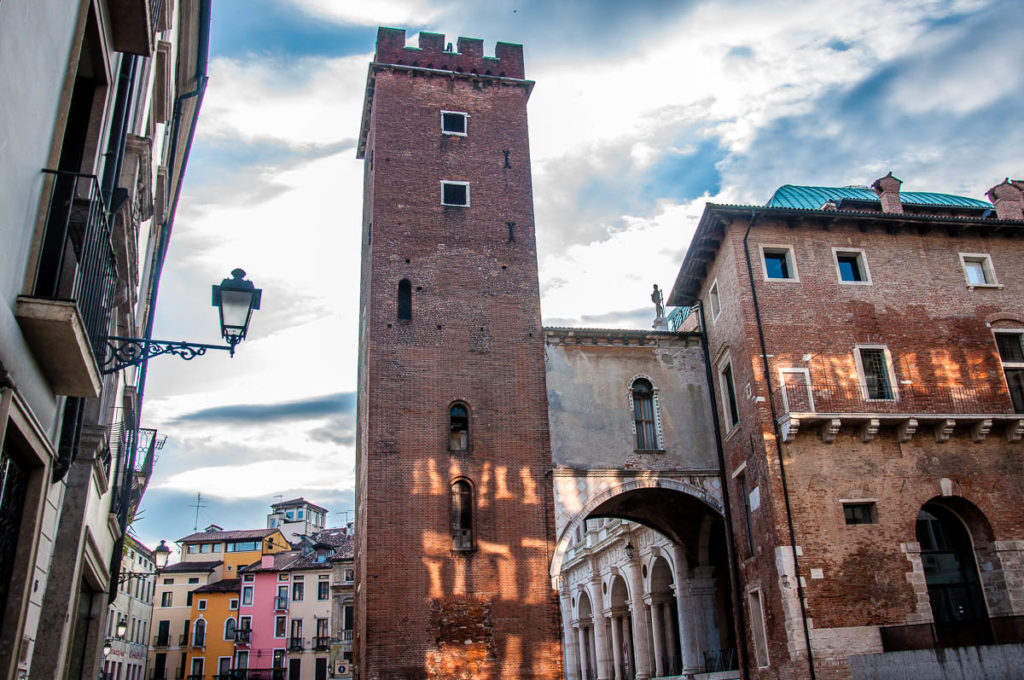
Vicenza is a small city and a provincial capital in the Northern Italian region of Veneto . It stands in the Venetian Plains that stretch between the Venetian Lagoon and the Venetian Prealps. A small group of hills – the Colli Berici – shoulder the city and provide easy access to hiking paths and clean air on the weekends.
Vicenza has about 112,000 inhabitants and is about halfway between Venice and Verona . There are several large airports within an hour or two away. In addition, good road and railway networks connect Vicenza to many important cities in Veneto and in Italy. Among them are:
- Padua – around 42 km away from Vicenza;
- Verona – around 58 km away from Vicenza;
- Venice – around 75 km away from Vicenza;
- Lake Garda – around 80 km away from Vicenza;
- Treviso – around 91 km away from Vicenza;
- Bologna – around 152 km away from Vicenza; and
- Milan – around 212 km away from Vicenza.
Here is a map showing the exact location of Vicenza in Italy. You can click on it to zoom in and out, to check specific distances, and to get directions to other destinations in Italy and abroad:
2. How to reach Vicenza, Italy?
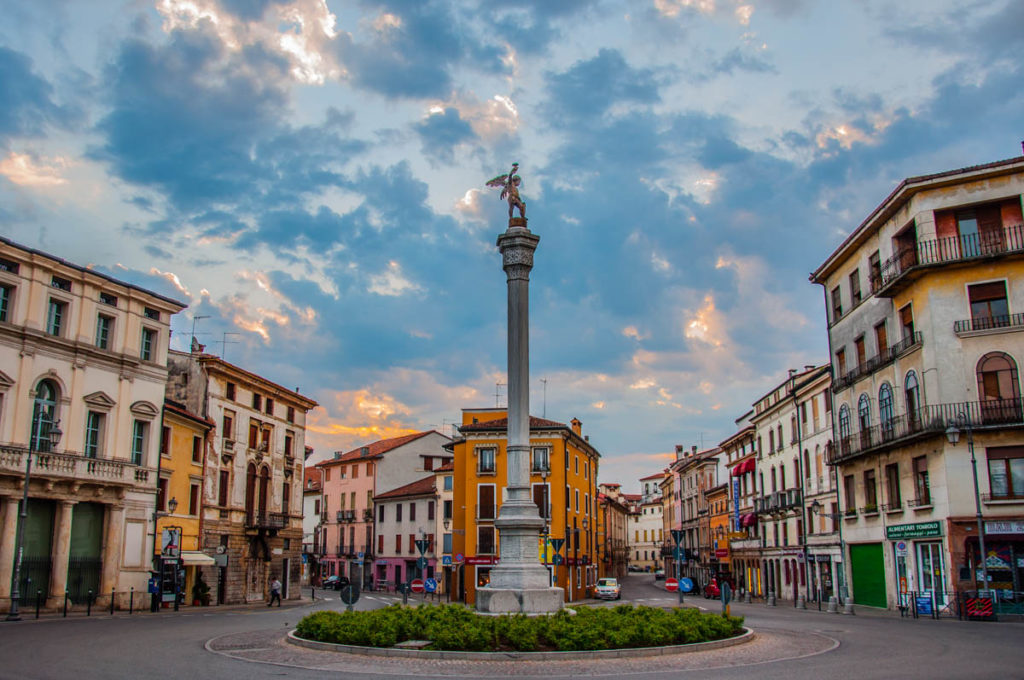
From abroad, the easiest way to reach Vicenza is by plane. While the city doesn’t have a commercial service airport, nearby there are several major airports that are very convenient for Vicenza.
Vicenza can also be easily reached by train from anywhere in Italy or Europe. The city’s train station is on the main Milan-Venice trainline and you can get direct trains to many towns and cities in Veneto, Italy, and Europe from here, too.
To check train travel times and buy tickets in advance, I use Omio . It shows prices and travel times for all available types of trains in Italy irrespective of the company that runs them. This way I can compare costs and times of departure and arrival.
Vicenza is also very easy to reach by car. The Italian highway A4 connects Vicenza to Turin, Milan, Brescia, and Verona to the west and Padua, Venice, and Triest to the east. This helpful website will give you an estimate of how much the tolls are going to cost. Click to hire a car for your trip to Vicenza in Italy.
3. How big is Vicenza, Italy?
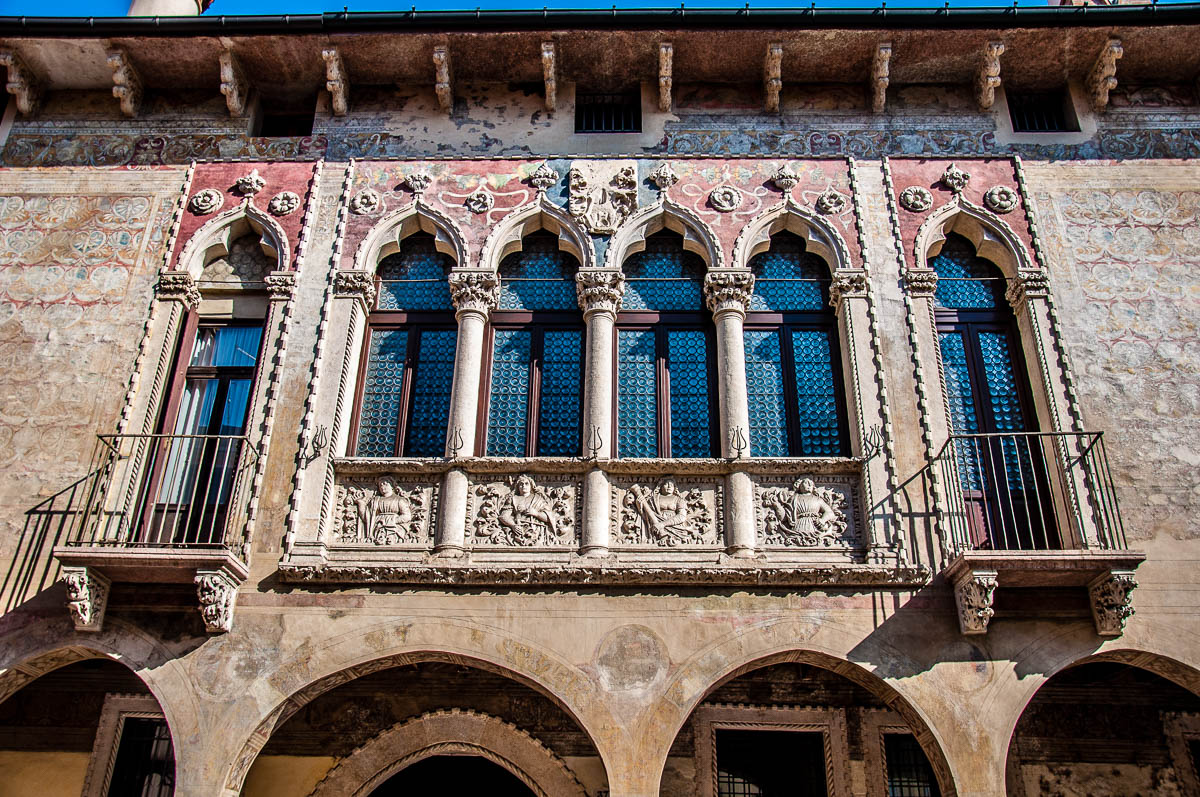
Vicenza has around 112,000 inhabitants and a very walkable historic centre which is very easy to navigate on foot. The train station is a six-minute walk from the main street – the elegant Corso Palladio – so you can find yourself in the heart of Vicenza in no time at all.
The rivers Bacchiglione and Retrone meander picturesquely through the historic centre.
If you have just a day to spend in beautiful Vicenza, you can easily walk everywhere and see almost everything that must be seen here from dawn till dusk.
There is a well-organised public transport system with buses crisscrossing the city. Buses, however, are not allowed inside Vicenza’s actual historic centre and their routes skirt it on the outside.
4. Can you recommend accommodation in Vicenza, Italy?
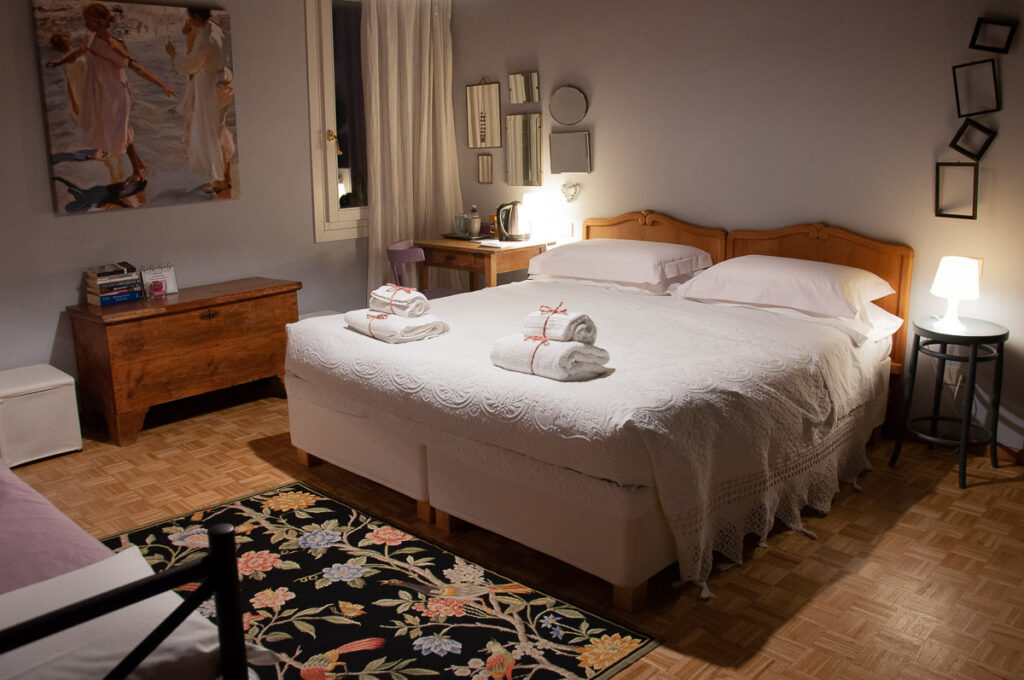
Sure! From first-hand experience, I can recommend the following three places to stay in Vicenza, Italy. All three are centrally located and give you easy access to all the important sights in the city’s historic centre.
I loved staying in all three on different occasions and I am only too happy to pass the word along.
- Relais Santa Corona – small and exclusive, you will find this stylishly decorated gem right next door to Palazzo Leoni Montanari and up the street from the Church of Santa Corona.
- Palazzo Valmarana Braga – stay in a palazzo designed by Andrea Palladio himself. The spacious flats have antique furnishings and fully equipped kitchens.
- B&B Portico Rosso – here you will find a true home from home. Gorgeously furnished with antique items and curiosities from Italy and all over the world, this B&B is a delight to stay in. Its owner Lucia is a true connoisseur of Vicenza and will talk you through all the hidden corners and best restaurants to discover in town.
If you prefer to choose a different place for your visit to Vicenza, Italy, then have a look at this map. It gives you a quick visual idea of the many hotels and other forms of accommodation you can book for your stay here:
5. When is a good time to visit Vicenza, Italy?
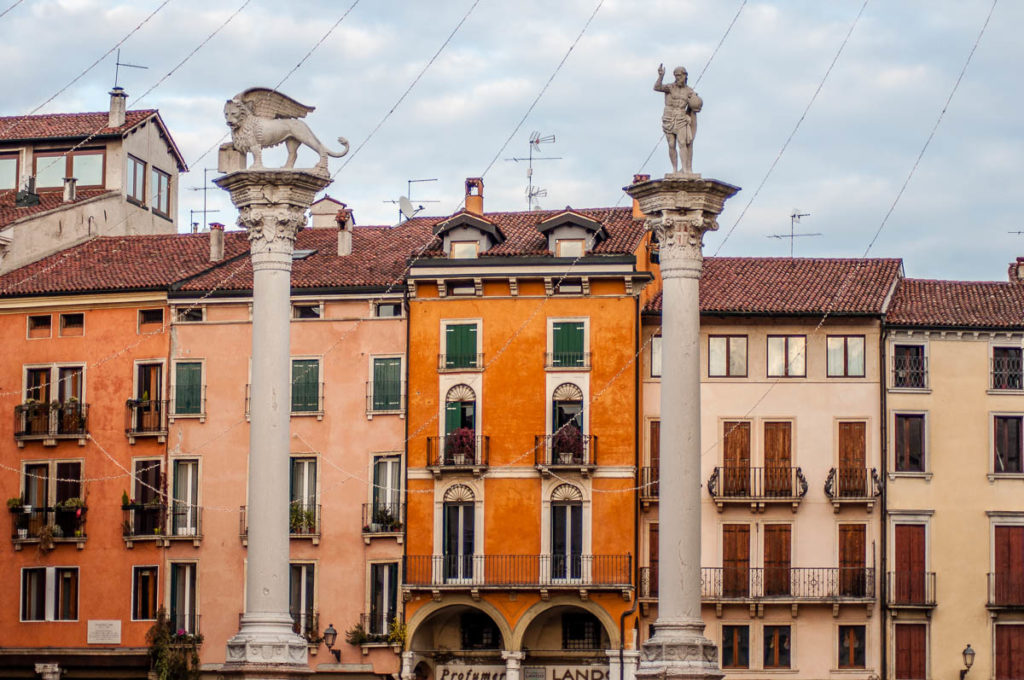
The best time to visit Vicenza, Italy is on a day when a large event is taking place here. It could be an annually held festival, the autumnal chocolate market, the monthly antiques market, the twice-a-week market or a city-centric event like Il Giro della Rua.
On festival and event days, Vicenza is full of verve and it’s a pleasure to walk around its historic centre and feel part of it all.
Otherwise, the city is particularly pretty in spring when the magnolia trees and wisterias are in full bloom. In late spring and early summer, many concerts and other cultural events take place here. Come October, the weather usually is nice and warm allowing you to walk outside without a jacket and on some days even in short sleeves. For Christmas, Vicenza dresses in sparkling lights and has a rich calendar of religious celebrations and lay festivities.
6. When is not a good time to visit Vicenza, Italy?
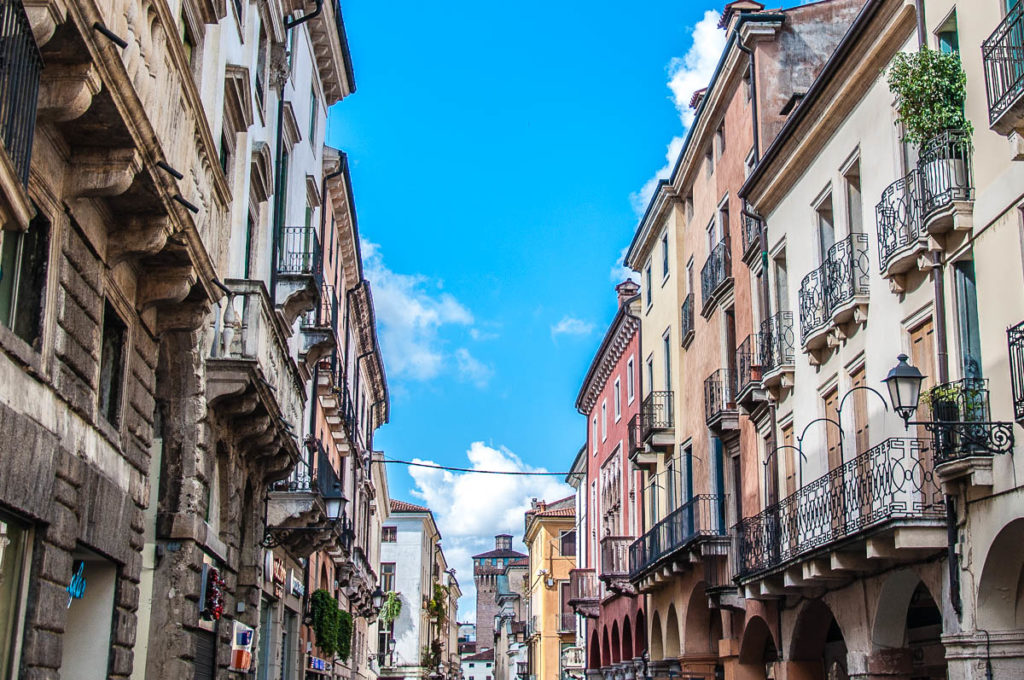
In principle, Mondays are not a good day to visit Vicenza, Italy.
This is the day on which the museums in town remain closed (unless it’s a national holiday). Most shops also stay closed in the morning. So, Vicenza is very, very quiet on Mondays.
If you really want to come here and for whatever reason, you can only do it on a Monday, then do come by all means. Just, don’t be too disappointed to find things closed. You will still be able to go for a lovely walk and have a nice meal though, so not all is bad.
The month of August is when the Italians, traditionally, take a long summer holiday. Thus, Vicenza becomes a bit of a ghost town. It’s hot and humid, many places are closed, there may be some large-scale roadworks and repairs going on, and the mosquitoes are at their most ferocious.
Again, if you can only come here in August, take your chance. At least, make sure that your visit is not on an August Monday.
7. What do I need to know before visiting Vicenza, Italy?
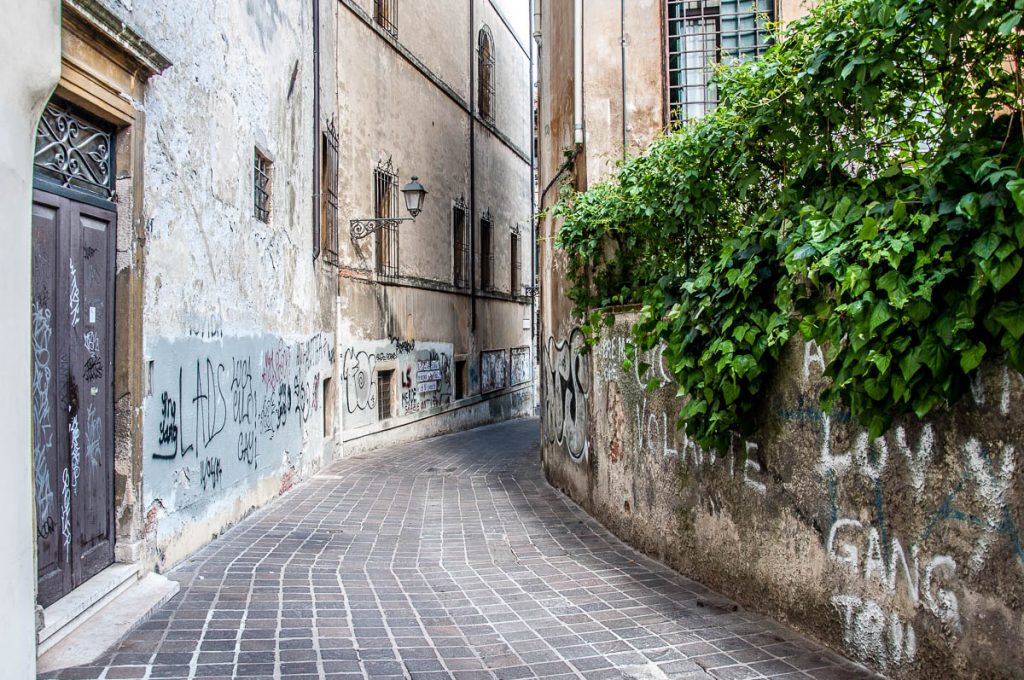
Here are some practical tips to know in advance before organising a visit to Vicenza, Italy:
- The city’s museums and sights are traditionally closed on Mondays. This doesn’t apply if a national holiday falls on a Monday. However, it’s always better to call in advance and double-check in order to avoid disappointment.
- Vicenza’s Tourist Information Office is right next door to Teatro Olimpico. Here you can get up to date information about museums, sights, and events. Also here you can buy Vicenza Museum Card which gives you better rates for the museums and sights you are interested to see during your visit. I have used Vicenza Museum Card several times and have found it to be good value.
- Vicenza’s train station is very close to the city’s historic centre. A few minutes walk in a straight line and you will find yourself at the end of Corso Palladio – Vicenza’s elegant main street.
- Vicenza’s historic centre is generally very easy to navigate on foot and with a buggy/stroller. The historic centre is a limited traffic zone so make sure that you don’t drive your vehicle into it (if you don’t have a special dispensation). The fine can be steep.
- When visiting a church, please, make sure that your shoulders and knees are covered and that, in general, you wear suitable clothing. Also, tourist visits are not allowed in churches when a mass is in progress.
- Riposo – the traditional Italian long lunch break – is observed by many places in town (not museums!). Please, plan your visit accordingly. Click here to read more about riposo and how to navigate it successfully.
- Many restaurants and eateries are traditionally open for lunch and dinner service and close between both.
- Vicenza is generally a safe and sedate place. Still, please, take all the usual precautions you would when visiting a new place. Here are some useful safety tips to keep in mind when travelling solo.
8. What are some great tours and activities to book in Vicenza, Italy?
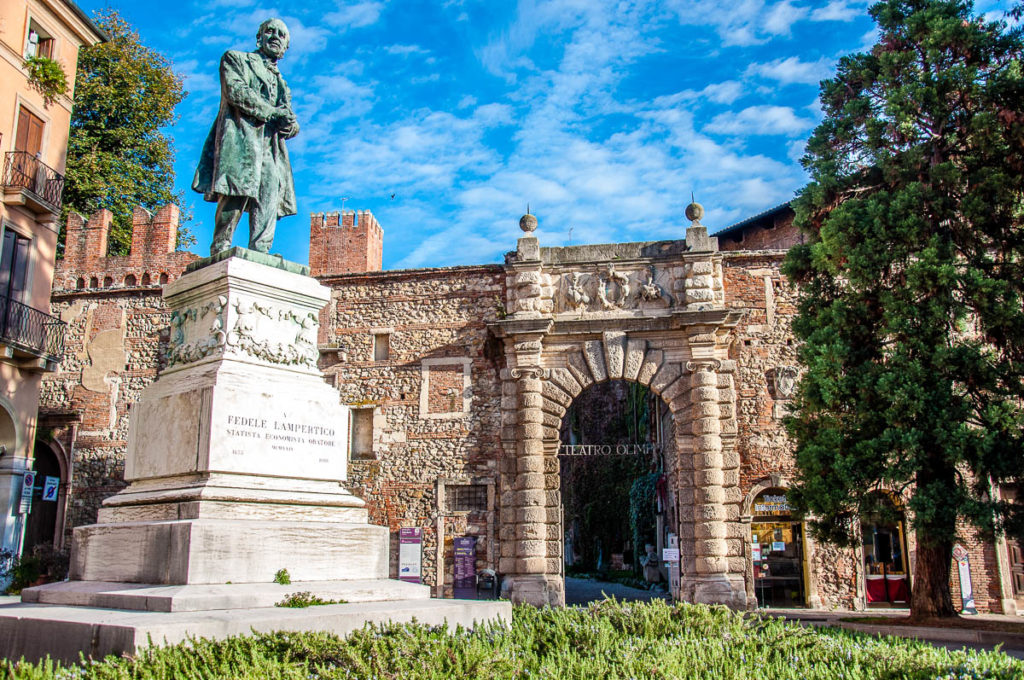
If you enjoy exploring new places with the help of an expert local guide, then booking an organised tour or activity during your time in Vicenza, Italy is a great idea. It will give you a chance to delve in a structured manner into everything that this small Italian city and its surroundings have to offer. From history and art to delicious food and wine, you can experience the best of Vicenza in a short amount of time.
Here are some of the best tours in and around Vicenza to look into and choose from according to your interests, available time, and budget:
9. What nearby cities and towns can I visit from Vicenza, Italy?
In spite of being off the beaten track, Vicenza is close to many worldwide famous cities and destinations in Italy.
Sandwiched between Venice and Verona , Vicenza is connected to many major Italian cities via high-speed and regional trains, as well as toll highways and provincial roads. The Adriatic Sea and several large sea resorts are about an hour away. For lovers of nature and hiking, the Asiago Plateau is about an hour away and the Dolomites are less than two hours away from Vicenza. Italy’s largest lake – Lago di Garda – is about an hour away by car and you can get there even faster by high-speed train.
You can easily visit Vicenza for a day from several larger Italian cities like Milan, Brescia, Verona, Venice, Padua , Ferrara, and Bologna . Or, you can pick Vicenza as a base in Italy and then explore at your leisure not only the well-known destinations that are near it but also many hidden corners and little-known gems like medieval walled towns, areas of natural beauty, Venetian villas, and spa towns.
Have a look at this detailed blog post listing dozens of day trips from Vicenza . Travel times, train tips and lots of photos are provided, too. For even more information, scroll down to the cluster of helpful links right at the end of this blog post.
In Conclusion
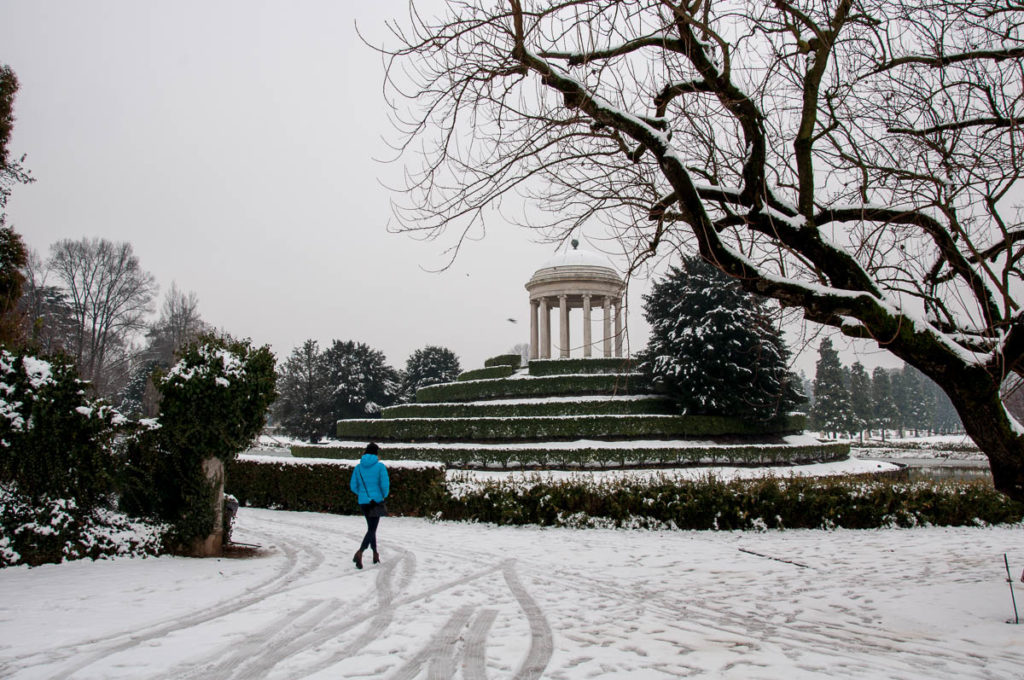
Vicenza is a small city in the Northern Italian region of Veneto .
Often overlooked for the nearby tourist magnets of Venice and Verona, nevertheless, Vicenza has many sights and attractions to fill up a day trip or a longer visit with great experiences and unforgettable memories.
The city’s Roman roots go back to the 2nd century BC. Its beautiful historic centre was then shaped during the Middle Ages and the Italian Renaissance.
Nowadays, Vicenza has many exciting museums , one of Italy’s most important Sanctuaries dedicated to the Virgin Mary, lots of lively events, and even its own local dish with an international background.
In this blog post, I share with you the best things to do in Vicenza, Italy. All the detailed information and first-hand tried and tested practical tips are based on my six years spent living in this small Northern Italian city. I hope that this in-depth guide will be of indispensable help to you during your own explorations.
Enjoy discovering the major landmarks and the hidden gems of this beautiful corner of Italy!
Have a wonderful time in vicenza.
Now, get ready quick for your visit to Vicenza, Italy!
- Consult these guidebooks .
- Buy plane tickets to Italy .
- Book train tickets , bus tickets or rent a car .
- Research accommodation .
- Select tours and activities .
More Helpful Veneto Info for You
Veneto: Best Cities to Visit , Top Places to Visit , Unique Adventures , Most Colourful Places , Mysterious Places , Best Lakes to Visit , Reasons to Visit Veneto’s Small Towns and Villages: Prettiest Small Towns , Most Beautiful Villages , Malcesine , Torri del Benaco , Punta di San Vigilio , Campo di Brenzone Venice: Major Landmarks , Essential Tips , Hidden Gems , One Day Itinerary for Art Lovers , Nearest Airports , Boats in Venice , Haunted Venice , Day Trips from Venice , Arco del Paradiso Verona: Things to Do in One Day , Day Trips from Verona Padua: Things to Do in One Day , 101 Facts About Padua , 10 Reasons to Visit Padua , Day Trips from Padua Vicenza: The Beauty of Vicenza , Must-See Museums , Day Trips from Vicenza , Historic Pasticceria Soraru , Nearby Beauty Spots , Lake Fimon , Hanging Gardens Hiking in Veneto: Cadini del Brenton and Cascate della Soffia , Lake Garda’s Tibetan Bridge , Rocca di Garda , Dante’s Hill , Grotta Azzurra di Mel , Family-Friendly Walks and Hikes , Sanctuary of Madonna della Corona
More Helpful Italy Info for You
Best of Italy: Italy Gift Guide , Italian Piazzas , Italian Markets Italian Food: Best Italian Food Gifts , Cheap Italian Food , Rules of Italian Breakfast , Italian Breakfast Foods Italian Coffee: Italian Coffee Culture , Italian Coffee Drinks , History of Coffee in Italy Northern Italy: Best Cities to Visit , Major Airports Lake Garda: Best Towns , Nearest Airports , Travel Options , Lake Garda with Kids , Malcesine , Riva del Garda , Torri del Benaco Lake Como: Things to See , Nesso Friuli Venezia Giulia: Venzone , Most Beautiful Villages Emilia Romagna: Bologna , Ravenna , Comacchio , Most Beautiful Villages Marche: Reasons to Visit , Gradara , Frasassi Caves , Temple of Valadier
Thank you for reading! Please, leave me a comment, pin the images below or use the buttons right at the top and at the end of this blog post to share it on social media.
For more useful information like this, please, like my blog’s page on Facebook and subscribe to my strictly no-spam newsletter.
Email address:
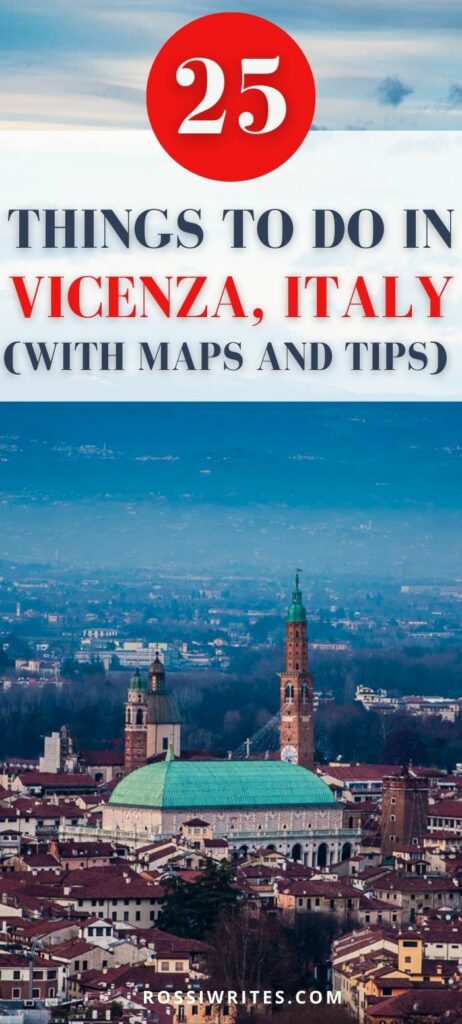
Staci Friedel
Thursday 29th of February 2024
Best place in Vicenza to get Bacala’ alla vicentina? Never had dried fish but love polenta, so gotta try it!
Have a look at the list of restaurants recommended by the Confraternity of the Bacala' alla vicentina on this link. Of the ones in Vicenza, I can wholeheartedly recommend self restaurant Righetti (also mentioned in my blog post above). It's a great place to try different local specialities and to people watch. Best wishes,
Thursday 1st of December 2022
Thank you for writing this detailed piece on Vicenza! Based on your post, we decided to stay in Vicenza for four days and use it as a base to do a day trip to Verona and hike the 52 tunnels. Vicenza truly is a hidden gem!
Sunday 1st of January 2023
Thank you so much for your kind words! I hope you have a wonderful time in Vicenza. It has a lot to offer yet it's so easy to explore on foot and to leave for exciting day trips. If you ever grow a bit tired of it, then Padua and Verona nearby are fabulous! Best wishes!
Tuesday 27th of September 2022
Hi Rossi, just had a lovely week beside Lake Garda, in Bardolino, so nice to get back there. My first excursion was my usual trip up La Rocca from Bardolino, think my age is telling it is a strenuous climb to reach it but the views over Garda and back towards Bardolino are worth it. I managed the Eremo San Giorgio this time in it’s beautiful peaceful location, before dropping down to Garda for lunch and then a slow walk back along the lake side. At your advice I visited Torri del Benaco, taking an early bus out of Bardolino before the ‘crowds’ arrived.Such a lovely place, taking in the magnificent church of saint Peter and Saint Paul before the Scalger castle.I’m an avid reader of information so the Scaliger castle visit took me well into the afternoon. I said ‘crowds’ earlier but even at midday it still wasn’t busy. Yes Torri was well worth the visit. And yes I managed to get back to Vicenza after a bus ride to Peschiera del Garda and the frecciarossa to the city. Taking in the Basilica Palladiana, Teatro Olympico, Palazzo Chiericati and the Chiesa di Santa Corona.I think the city is worth another visit!! I have been to lake Garda a number of times but I still find there so much to see and with your wonderful and informative blog I hope to be visiting the area again soon. Keep it up. Ciao, good health to you and your family. David
Thank you for your comment, David, and for sharing the details about your recent trip to Lake Garda and Vicenza. I am very pleased that you had such a lovely time in these two beautiful corners of Italy. I am sorry that the climb to the Rocca was strenuous. I hope that at least the weather wasn't overly hot on the day you hiked up there. I also found the castle in Torri del Benaco quite fascinating. With the citrus garden and its different displays, there is lots of interesting information there. Especially, about the so-called incisioni rupestri - the rock carvings that have been found around that area of Lake Garda. I hope to be able to continue posting regularly here. There is a lot of information that I have still to write down, it's a shame that it takes me such a long time - on average a week - to complete a blog post. I am starting a history of art University course tomorrow, so in future, I hope, there will be lots to share about art in a more expert way, too. :) Have a great autumn ahead!
Best wishes,
Rossi Thomson :)
Sunday 23rd of May 2021
The places you mentioned are already on the list & we will be basing ourselves in Bassano del Grappa for them, aside fro Soave which we will do from Padova.
Can't wait to get back to Italy once the world sorts itself out.
Sounds great! Bassano is lovely! Enjoy your visit!
Saturday 22nd of May 2021
Your information is fantastic. Initially thought Vicenza would be a two day visit, starting to rethink it might be a week now, so much to see & all the architecture is amazing.
Thank you for your kind words, Kris! Two days in Vicenza is plenty, to be honest. :) It's a small city, easy to walk around the historic centre. If you are interested in medieval walled towns, then you can also see some of the ones that are near Vicenza like Cittadella, Castelfranco Veneto, Marostica, Soave, Asolo. Otherwise, there are many more destinations in the Veneto to enjoy and discover. Have a lovely time in Italy!
Sharing is Caring
Help spread the word. You're awesome for doing it!

Home » Travel Guides » Italy » 15 Best Things to Do in Vicenza (Italy)
15 Best Things to Do in Vicenza (Italy)
Vicenza is a fantastic city located in the northern regions of Italy in-between Venice and Verona . As part of the Veneto region of the country, Vicenza has a long history and combines its ancient past together with its modern cosmopolitan outlook and thriving economy to create a city that has the third-largest industrial sector In Italy.
Originally settled be the Euganei tribe, Vicenza was incorporated into the Roman Empire in 157 BC but was then ravaged by various tribes in subsequent years. Afterwards in the Middle Ages, the city became part of the Lombard League and was involved in numerous battles and sieges against the Holy Roman Emperors. In modern history, the city was redeveloped after devastation during WW2 and industry became the main economic driving force. For the enthusiastic tourist, Vicenza has a huge amount of attractions to offer.
Due to its extensive history and affiliation with various ruling empires, Vicenza has a myriad of beautiful historical structures such as the Basilica Palladiana, and some well-maintained public parks such as the Parco Querini. It also benefits from a great location and is within easy reach of both Venice and Verona which are two amazing cities in their own right.
Let’s explore the best things to do in Vincenza :
1. Basilica Palladiana

This religious building is one of the icons of Vicenza and takes pride of place in the centre of the popular Piazza dei Signori.
Constructed in the 15th century, this is one of the first examples of a Renaissance structure to feature the Palladian Window design – the loggia of the Basilica has a series of ornate arches running along both its sides which create a visually appealing building.
Walking through the open arches gives you a chance to admire the architecture up close.
Inside the first floor of the basilica is a huge open room with a high vaulted wooden ceiling and many arched windows.
This structure is truly impressive and is a jewel in the centre of Vicenza.
2. Teatro Olimpico

Vicenza has an affinity with the famous architect Palladio and the Teatro Olimpico is another of his magnificent creations.
This theatre is not like any other you will see and its interior is made entirely of stone, stucco and wood.
The stage is simply wonderful and looks more like a palace than a place of performance – stone statues, archways and plaster work adorn the facade.
Original stage-sets are still in place today behind the main facade and create the ilusion of great depth – as you look through the arches, it appears as if many streets stretch far behind the structure.
3. La Rotonda

Set in elaborate and beautiful grounds, you would not think that this structure was originally meant to be the home of a retired Vatican priest.
La Rotonda is located to the south of Vicenza approximately 15 minutes from the city centre and is one of the most recognizable buildings in the city.
What makes this building so special is its amazing design and symmetry – each of the four sides of the house have a portico that looks similar to the Pantheon in Rome and can be approached by a series of steps.
Inside the building is a series of lavishly decorated rooms complete with beautiful frescos and ornate stucco plaster work.
4. Museo Palladiano

Located in the same complex and square as the Basilica Palladiana, the Museo Palladiano is a must-see attraction in combination with the basilica itself.
Within this museum is a fantastic collection of artefacts and relics relating to the basilica, together with some informative and detailed displays about its history and construction.
Here you can learn about the significance of the building, and also of its renowned architect, Andrea Palladio.
5. Villa Valmarana

Lying in close proximity to the Villa La Rotonda, the Villa Valmarana is a similar structure that was created around the same time period.
A footpath connects the two villas together and it is advisable to visit both whilst you are in this area of Vicenza.
Locally known as Al nani (due to the dwarfed statues on the walls of the villa) this complex has some stunning grounds filled with flower arrangements and beautifully manicured lawns.
Inside the villa itself is a series of well-maintained rooms that features some gorgeous Renaissance artwork by Giambattista Tieplo.
6. Corso Andrea palladio

The Corso Andrea Palladio pays homage to this famous architect and designer and is one of the main streets in the historic old town centre.
Along this street, you can find various pallaces and structure, some of which were designed by Palladio himself.
The most notable structures include the Palazzo del Comune, Palazzo Da Schio, Palazzo Boninand the Palazzo Zileri Dal Verme.
This whole area is brimming with beautiful buildings, but the street also contains a great selection of shops and restaurants and is one of the main retail areas in the old town.
7. Vicenza Museo Civico

At the eastern end of the Corso Andrea Palladio is the stunning Palazzo Chiericati.
This structure features a gorgeous front facade that has a series of marble columns and is crowned with various statues.
Although beautiful in its own right, the main attraction is held within the building – the Museo Civico.
The Civic Museum of Vicenza contains a vast collection of artefacts, archaeological finds and artwork from the city and the surrounding region and provides insight into Vicenza’s history.
Also included is a selection of artwork from renowned Venetian artists such as Carpaccio, Tiepolo and Veronese.
8. Chiesa di Santa Corona

Located in the historic old town centre of Vicenza, this church was partially designed by the legendary Palladio who is actually buried in the church himself.
Created in a Gothic style, the church was built in the 13th century and has a series of brick towers, chapels and front facade.
Whilst the exterior is not overly impressive, the interior has a lot more to offer and features the Valmarana Chapel that is said to have been designed by Palladio.
Furthermore, there is a series of artwork and frescos depicting religious scenes such as the Adoration of the Magi and the Baptism of Christ.
9. Santuario di Monte Berico

In the southern part of Vicenza, the hills climb upwards towards Monte Berico and the Piazza della Vittoria offers panoramic views of the city.
Behind this wonderful viewing platform is the Basilica di Monte Berico that was built in the 17th century.
The actual design of the church is based on La Rotonda and features four symmetrical walls with various statues and ornate artwork.
Inside the church is a series of beautiful paintings including The Supper of St.
Gregory, Pieta and Virgin with your evangelists.
To walk back to the city, it advisable to pass through the immense 800m long covered corridor or portico that stretches from the front of the church, right down to the base of the railway station.
10. Parco Querini

In the northern part of the old town you can find the Parco Querini – this expansive public park is a wonderful place to visit to escape the city and enjoy the fine Italian weather.
At the centre of the park is a large circular pond that contains a central island and a beautiful summer-house – you can reach this island via a footbridge that crosses the water.
Aside from the water feature, the park also contains several wooded areas with walking paths winding through them, and some manicured lawns perfect for playing ball-games or sunbathing.
11. Vicenza Cathedral

Located only a 2 minute walk from the Piazza dei Signori, the Duomo is one of the most important churches in the city and is a fine structure in its own right.
The front facade of this cathedral stands out and creates a large contrast to the sides and rear of the building.
Although simple in design, the arches and the patterned red and white marble work look extremely beautiful and frame the church perfectly.
An interesting fact is that the church is actually built on the remains of three older religious structures, and everything except the front facade has been reconstructed after damage during WW2.
12. Take a day trip to Verona

Vicenza benefits from its close connections to both Venice and Verona and both of these cities are important tourist destinations in their own right.
Verona lies approximately 30 minutes to the west of Vicenza and regular buses and trains travel between the two cities.
If you have explored Vicenza, a day trip to Verona could allow you to explore a different part of Italy.
This city is famous for its historical architecture including buildings such as the Roman Arena, the Ponte Scaligero and the Piazza dei Signori.
Furthermore it has a plethora of stunning churches, and the iconic balcony that gave birth to the famous Romeo and Juliet scene in Shakespeare’s play.
13. Piazza dei Signori

The Piazza dei Signori is the main square within the historic town centre of Vicenza and serves as one of the focal points of the city.
This beautiful square is packed full of stunning architecture and also plays host to regular markets where you can mingle with the locals and try to find a bargain.
In the centre of the square is the impressive Basilica Palladiana and it’s bell tower; other notable buildings surrounding the square include the Loggia del Capitaniato and the Chiesa di San Michele detta dei Servi.
Aside from the buildings, there is also a series of cafes and restaurants where you can simply sit and watch the world go by.
14. Torre Bissara

Although this structure is connected to the Basilica Palladiana, it is a wonderful attraction in its own right and has an extensive history.
Standing at 82m high, it is by far the tallest building in Vicenza and towers over the other structures in the historic town centre.
Constructed in the 12th century, the tower has stood ever since in its current form and is of important historical significance for the city.
On one face is a beautiful ornate clock with a bright blue dial, whilst it is topped with a bronze dome and weather vein.
It is possible to view the tower up close from the outdoor terrace on top of the Basilica but unfortunately, you cannot climb to the top of the tower itself.
15. Ponte San Michele

Due to its location on the river, Vicenza has a series of bridges that cross the water, enabling traffic and pedestrians to move freely through the city.
One of the most beautiful and picturesque bridges is the Ponte San Michele.
You can find this bridge only a short walk from the Piazza dei Signori and it is advisable to walk over the bridge itself, but also view it from the adjacent Ponte San Paolo.
What makes this bridge so attractive is its surroundings – firstly, the terracotta roofed buildings frame the bridge, and secondly the clear waters and the various greenery, trees and flowers add colour and contrast.
This is the perfect place to get some postcard worthy photos.
15 Best Things to Do in Vicenza (Italy):
- Basilica Palladiana
- Teatro Olimpico
- Museo Palladiano
- Villa Valmarana
- Corso Andrea palladio
- Vicenza Museo Civico
- Chiesa di Santa Corona
- Santuario di Monte Berico
- Parco Querini
- Vicenza Cathedral
- Take a day trip to Verona
- Piazza dei Signori
- Torre Bissara
- Ponte San Michele

25 of the Best Things to Do in Vicenza, Italy
Vicenza is a city located in Veneto, one of the prettiest of the 20 regions of Italy . Although it is often overlooked in favor of its big sisters, Verona and Venice, you’ll find plenty of things to do in Vicenza if you’re visiting for a few days.
* This post may contain affiliate links from which I earn a commission (for more info, read my disclosure ). As an Amazon Associate, I earn from qualifying purchases.
* I try to keep the information on this blog as updated as possible, but I still recommend consulting the latest prices, opening hours, and other details on the official website of each site, hotel, and tour, as well as checking the updated public transport routes and timetables.
Table of Contents
IS VICENZA WORTH VISITING & WHAT IT IS KNOWN FOR
Even UNESCO deemed it very special – in 1994, the city (and its surrounding villas) was included on the UNESCO World Heritage Site list, making it a great weekend getaway destination or a visit-worthy stop on an Italy road trip .
Vicenza’s main claim to fame is as ‘The City of Palladio,’ referring to the renowned architect Andrea Palladio.
He was born in nearby Padua but moved to Vicenza, where he lived most of his life. The city is home to 23 of Palladio’s works, which primarily included villas and churches built during the 16th century.
The city is also responsible for ⅕ of the country’s gold and jewelry production, giving it a cosmopolitan flair. To learn more about what it has to offer before you travel, check out this Vicenza bucket list.
Where to Stay in Vicenza
Highly-rated accommodations in Vicenza include Palazzo Valmarana Braga (housed in a building designed by Andrea Palladio), Glam Boutique Hotel , and Portico Rosso B&B .
Best Things to Do in Vicenza, Italy
Teatro olimpico.
The Teatro Olimpico (Olympic Theater) is the final work of Andrea Palladio, and perhaps one of his most influential. At the time of its construction, most performances were taking place at temporary theatres set up outdoors.
The Teatro Olimpico is among the first in the world to have an indoor, permanent structure. The first production here was Oedipus Rex, though there weren’t many performances in this theatre initially.
If you look through the archway, you’ll see trompe l’oeil paintings that were designed to look like the streets of Thebes. Today, you can tour the inside, though performances here are a rarity.
Opening hours and prices: See them here .

Garden of the Teatro Olimpico
The gardens outside of the Teatro Olimpico are nothing short of breathtaking. Gorgeous ivy-covered buildings surround the perimeter of the gardens and courtyard.
With ancient statues lining a gravel path and benches tucked away for people-watchers, it makes for a perfect opportunity to sit back, relax, and take in the moment.
Piazza Dei Signori
Piazza dei Signori is the main square in Vicenza, a gorgeous Italian piazza , and the perfect place for people-watching or enjoying an evening cocktail.
Here, you can admire the greatest concentration of Palladio’s work, including the Basilica Palladiana. There are also several restaurants and cafes with outdoor seating, perfect for a summer evening.
Torre Bissara
Torre Bissara is a large civic tower in Piazza dei Signori and one of the tallest buildings in Vicenza at 82 meters high.
It dates back to the 12th century, though it was hit by an Anglo-American bombing in 1945. It has since been restored and rebuilt.
Its stonework tells the history of Vicenza, and at the top of the tower is a headless statue of the goddess Athena.
Basilica Palladiana
The Basilica Palladiana is a Renaissance building in the center of Vicenza built by Andrea Palladio.
The building features one of the first examples of Palladio’s original architectural concept, which came to be known as the ‘Palladian Window’. Today, the city hosts events and exhibits at the Basilica Palladiana.

Loggia Del Capitanio (Palazzo Del Capitaniato)
Facing the Basilica Palladiana, this palace (which was also designed by Palladio), was once the residence of the Capitanio of Vicenza, the military representative of the Republic of Venice in the city of Vicenza.
To contrast the white basilica, the architect purposely used red brick, as well as different architectural embellishments, and the result is nothing short but stunning.
La Rotonda is a Renaissance villa (sometimes called Villa Almerico Capra) just outside Vicenza’s city center.
A former Vatican priest, Paolo Almerico, commissioned the building upon his return to his hometown of Vicenza. It is also one of Palladio’s masterpieces and among his most popular.
The villa (or, more aptly named palazzo) is situated upon a hill and was designed to provide the most light to each room, with each façade facing a cardinal point.

Villa Valmarana AI Nani
Villa Valmarana ai Nani is a set of three large buildings surrounded by rose gardens. The earliest building was built in the late 15th century, and the newer two less than one hundred years later.
The interior of the buildings is adorned with ornate frescoes by Giambattista and Giandomenico Tiepolo. The theme of the frescoes is all inspired by the favorite books of the son of Giustino Valmarana, commissioner of the villa.
Although the building was erected after his death, there is a large portrait in the villa that features Palladio.

Corso Andrea Palladio
Corso Andrea Palladio traverses the city center from the Teatro Olimpico to Piazza Castello at the city gate.
Along the street, you’ll see two palaces by Andrea Palladio, the town hall of Vicenza, Piazza Matteotti, and other beautiful spots.
From Piazza Matteotti, you can see the Teatro Olimpico and Palazzo Chiericati. Along the street are also shops, cafes, and restaurants.
Vicenza Cathedral
Vicenza Cathedral is a Roman Catholic cathedral that is the seat of the Bishop of Vicenza. Construction began in the late 15th century and was completed a century later.
Andrea Palladio designed its iconic cupola, and the building has undergone extensive renovations since all that remained after the bombing of WWII was the original façade.
Chiesa DI Santa Corona
Santa Corona is a Gothic-style Roman Catholic church in Vicenza.
It was the original burial site of Andrea Palladio, but its more interesting claim to fame is that it houses a thorn from the crown of thorns that Jesus was forced to wear. Louis IX of France gave the thorn to Bishop Bartolomeo di Breganze as a gift.
Le Scalette
Le Scalette (‘the stairs’) are situated underneath a famous archway erected by Palladio (Arco delle Scalette). The set of 192 stairs is one of the routes that reach Monte Berico.
They are used by Caserma Ederle soldiers as a workout – running up and down the stairs fully adorned in paratrooper gear! I tried this once – in regular gym clothes – 0/10, do not recommend it, but still a unique experience to have in Italy.
Arcades of Mount Berico (Portici DI Monte Berico)
Another way to get to Monte Berico is through a series of arcades/covered porticos dating back to the 18th century.
They have a religious meaning, as you’ll see 10 groups of 15 arches (each) that symbolize the 15 Mysteries of the Rosary .

Santuario DI Monte Berico
After the arduous trek up Le Scalette, you’ll reach the sanctuary of the Madonna di Monte Berico, located high on a hill that offers sweeping views of the city.
In the 15th century, many people in Veneto were greatly suffering from a terrible plague. Allegedly, the Madonna promised the people that she would rid them of the plague if they built a church on top of Monte Berico. Three months later, the people finished the church.
In front of the sanctuary is a small park and Piazzale della Vittoria, where you can take in the views. You can see everything, from the foothills of the Dolomites to the Venetian Lagoon, along with many other sites in Veneto.
Museo DI Santa Corona
One of my favorite museums in Vicenza, the Santa Corona Museum, is divided into two sections – naturalistic and archeological.
The naturalistic exhibits depict different characteristics of the territory, particularly the Berici hills. Here, you can learn about plants and wildlife endemic to the area.
The archeological section displays relics, tools, and fossils found in the area, dating back to prehistoric times.
Ponte San Michele
For a picturesque view of a peaceful area of Vicenza, head to the Ponte San Michele (San Michele Bridge). It is located at the south end of Vicenza, near the Basilica.
Be sure to check it out at night as well, when the lights are on and their reflection sparkles in the river water below.

Parco Querini
Parco Querini is surrounded by the banks of the Bacchiglione River and the expanse of Venetian walls that run the length of Viale Rodolfi.
Inside, there is a tree-lined avenue adorned with statues, a small pond surrounding an islet with a small temple, and a fairy-tale-like grove.
Parco Querini makes for the perfect thing to do in Vicenza if you need some green space and a reprieve from the activities in the city center.
Jewelry Museum
The Jewelry Museum is definitely worthy of a spot on your itinerary. Given the city’s status as a top gold producer and jewelry manufacturer in Italy, it’s one of the best things to do in Vicenza.
The museum has nine rooms that display jewelry from everywhere – large fashion houses, small goldsmiths, local jewelers in the area, etc.
You will learn a lot about the creative process, craftsmanship, and artistic experimentation as you peruse the different exhibits on display.
Opening hours and prices: See them at the bottom of this page .
Palazzo Barbaran Da Porto
Another building designed by Andrea Palladio and a must-see in Vicenza, the Palazzo Barbaran da Porto houses the Palladio Museum, which is dedicated to the life and work of the brilliant architect.
Surprisingly, this palace is the only one he saw completed, and its beauty is something to be appreciated on the inside and out.
Palazzo Chiericati
Palazzo Chiericati is another of Palladio’s architectural gems in the city. The building dates back to the mid-16th century when Palladio initially started his designs, but it wasn’t completed until the end of the 17th century.
The City of Vicenza obtained it in the mid-19th century with the intention of housing an epic art collection. A few years later was the inauguration of the Civic Art Gallery (also known as the Civic Museum).
Civic Art Gallery (Civic Museum)
Housed in the Palazzo Chiericati, the Civic Art Gallery is a museum home to over 35,000 paintings, sculptures, graphics, and other artistic endeavors. Some works date all the way back to the Middle Ages.
You can find some truly breathtaking works of the great masters of Venetian painting, such as Bassano and Veronese. Additionally, you’ll find the famed sculptures of Sansovino and the rock crystals of Valerio Belli.
If you’re an art buff, this is a must-add item to your list of tourist attractions in Vicenza.
Palazzo Leoni Montanari
Here is an example of a museum whose building is as beautiful as the art on display.
Palazzo Leoni Montanari’s art gallery (Gallerie d’Italia) boasts three important collections – Attic and Magna Graecia ceramics, Russian icons, and Venetian art from the 18th century. There are also temporary exhibits displayed.
Basilica Dei Santi Felice E Fortunato
This little church is slightly out of the usual tourist way but has stunning interior architecture and mosaics dating back to the 4th century.
It is certainly one of the more interesting things to see in Vicenza, but make sure you visit in the morning as it closes around noon each day.
Church of San Lorenzo
Finish your sightseeing in Vicenza in the northwest part of the city center, where you’ll find the Church of San Lorenzo, which dates back to the 13th century.
Constructed in Italian Gothic and Romanesque styles, both its exteriors and interiors are packed with unique architectural details. It’s also worth exploring the church’s cloister.
Baccalà Alla Vicentina
The city’s claim to fame on the foodie scene is Baccalà alla Vicentina, a traditional Italian dish from Vicenza. Its main ingredients are cod, milk, onions, and anchovies.
It has an unusually sweet flavor (for a fish dish) due to the milk sugars. I’m not usually one for dishes made with stockfish, but this is a must-try if you’re visiting Vicenza.
Want to take some day trips from Vicenza? You can easily get by public transport to Verona, Padova, and Bassano del Grappa! You can also take an Italian road trip through the region of Veneto.
Other Italy Travel Guides
Read more about northern Italy:
- Northern Italy road trip
- Best places to visit in October in northern Italy
- Best places to visit in Piedmont
- Best places to visit in Lombardy
- Hidden gems of northern Italy
- Road trips from Milan
- Where to stay in Aosta Valley
- Is Aosta worth visiting
- Places to visit in Aosta Valley
- Aosta Valley road trip from Turin
Read more about Turin and Milan:
- Reasons to visit Turin
- 3-day Turin itinerary
- Places to visit in Turin
- Chocolates in Turin
- Cafes in Turin
- Best neighborhood to stay in Turin
- Tips for visiting Turin
- Hidden gems in Turin
- Turin in winter
- Things to do in Milan on a rainy day
- Secret places in Milan
- 4 days in Milan
- Day trips from Milan in winter
- Milan or Turin
Read more about Italy:
- Quotes about Italy
- Romantic novels set in Italy
- Gifts for Italy lovers
- Winter destinations in Italy
*The majority of this post was written by Jade Laurenza. The uncaptioned photos in this post belong to Jade Laurenza .
About Or Amir
Hey, I'm Or! I'm a passionate traveler with a severe coffee, chocolate, and pastry addiction (or any other carb for that matter). I'm always planning my next trip to Spain, Italy, or any other country in Europe, and my goal is to help you make the most of each destination.
*Your emil address will not be published. By using this form you agree with the storage and handling of your data by this website
Leave a Comment Cancel reply
Save my name, email, and website in this browser for the next time I comment.
Hi, I'm Or!
I'm a passionate traveler obsessed with traveling in Europe and discovering hidden gems in each place I visit. For me, it's not about ticking destinations off the bucket list but experiencing each one of them to the fullest. Read more about me and my story.


Best Things To Do In Vicenza Italy, A Palladian Paradise
Looking for the top attractions and best things to do and see in Vicenza Italy. Vicenza? That’s a great idea. Vicenza is a fantastic and underrated UNESCO-listed city, where you can take a Palladian journey.
Vicenza was the crucible of the celebrated Andrea Palladio . Palladio was one of the world’s greatest architects. Palladio created elegant buildings.
With their graceful proportions, they looked like Greek temples. He turned Vicenza into a “real museum, open to everyone.”
If you’re an architecture geek, Vicenza will appeal. While other Italian cities, like Florence , are known for their Italian art, Vicenza is synonymous with its Renaissance architecture.
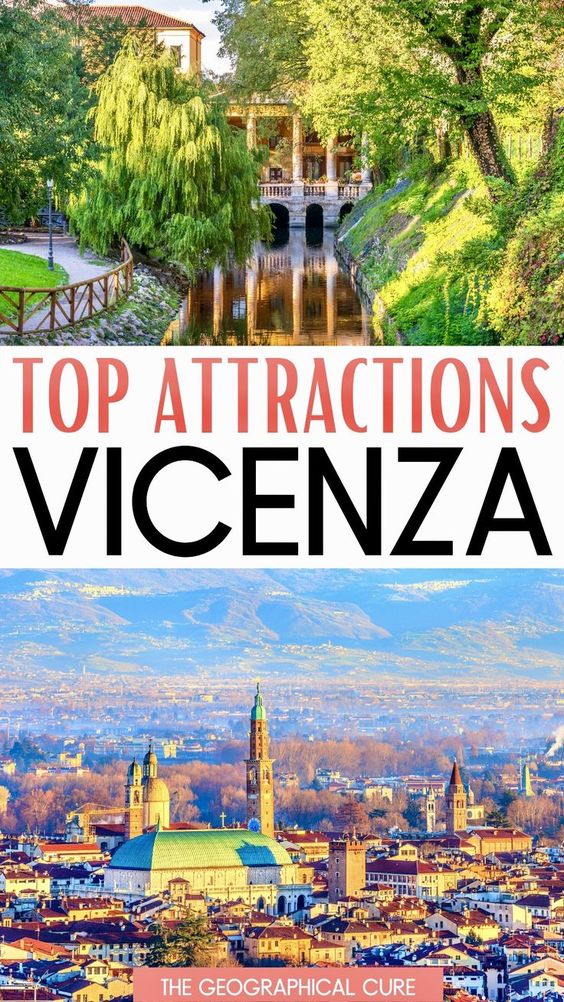
The city is variously known as the “Pearl of the Renaissance,” the “Gold City,” and the “City of Palladio.”
In 1994, the entire city of Vicenza became a designated UNESCO World Heritage Site The designed was intended to preserve Palladio’s palaces and villas, which are the top attractions in Vicenza and the surrounding area.
But Vicenza isn’t exclusively for architecture buffs. The city is lovely in and of itself. Vicenza is one of Italy’s most beautiful towns .
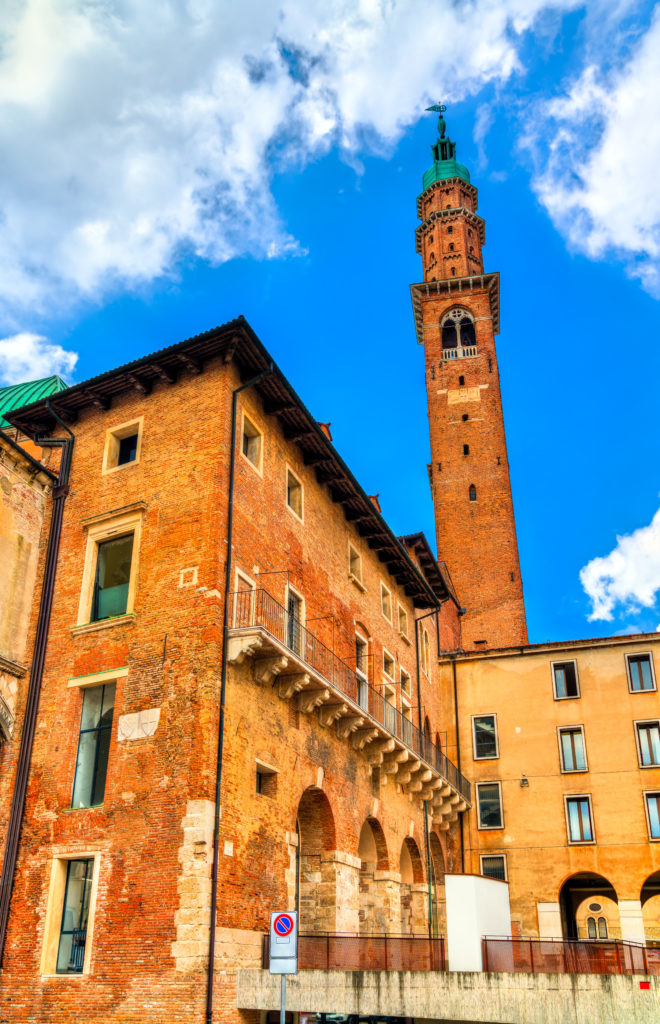
Vicenza’s streets are a dense jumble of creamy pastelbuildings, small canals, quaint churches, and cobbled alleys.
Vicenza (vih-CHEN-zah) is midway between the travel magnets of Venice and Verona. The town is an easy day trip from either city.
Vicenza is one of Italy’s lesser known UNESCO sites. So it’s a rare hidden gem in Northern Italy where you can escape the crowds.
Who Is Andrea Palladio?
Andrea Palladio was one of the greatest architects of the 16th century Italian Renaissance. He gave us the Palladian style , an almost timeless style of architecture. Palladio was a native son of Vicenza (though he was born in Padua).
Palladio’s real name was Andrea di Pietro della Gondola. But one of his first patrons gifted him the nickname of Palladio, an agreeable allusion to Pallas Athena, Greek goddess of wisdom and the arts.
Palladio was the first influential Renaissance architect. Palladio prized clarity, symmetry, order, and Greco-Roman architectural principles.
His impact on architecture was of biblical proportions, especially in Great Britain and Colonial America.
A young Palladio apprenticed as a stone cutter and sculptor. He got his start with his proposal to redo Vicenza’s dilapidated Gothic palace of justice in the Neo-Greek style.
That established Palladio as Vicenza’s favorite architect. The rest of Palladio’s career was a one man construction boom, in which Palladio made Vicenza and the surrounding area his playground.
Palladio may not be a household name for many Americans. But his 1570 treatise, The Four Books on Architecture , catapulted him to international fame, including in the United States. Thomas Jefferson referred to Palladio’s writings as “his architectural bible.”
In 1994, UNESCO inscribed Palladio’s work on the World Heritage List as “The city of Vicenza and the Palladian villas of the Veneto.” Seeing the outlying villas requires a car and more time. But there are two within walking distance and I discuss them below.
20 Top Attractions in Vicenza
Here’s my list of the best things to do and see in pretty Vicenza. You can walk in the footsteps of Palladio and see some of Italy’s best hidden gems. You might want to book a 2.5 hour walking tour of Palladio’s masterpieces or a 1. 5 hour walking tour with a local .
Palladio’s stunning creations are undeniably Vicenza’s major draw. But there are also some lovely churches and parks as well.
1. Corso Andrea Palladio
The Corso Andrea Palladio is Vicenza’s pedestrianized main street that pays homage to Palladio. It’s the main streets in the historic old town, brimming with magnificent buildings.
Along this street, you can find a steady string of Renaissance palaces and Palladian architecture.
The most notable structures include the Palazzo del Comune, Palazzo Da Schio, Palazzo Boninand the Palazzo Zileri Dal Verme. The street also contains a great selection of shops and restaurants and is one of the main retail areas in Vicenza.
2. Piazza dei Signori
The heart of medieval Vicenza is the Piazza dei Signori (Square of the Lords), one of Italy’s best urban squares.
This is where the Chief Magistrate and Captain lived when the Republic of Venice ruled over Vicenza from 1404 to 1797. (This is why there is so much Venetian art in Vicenza.)
READ : Nutshell History of Venice
The piazza is on the site of a former Roman forum. Now, the bustling stone paved square is home to myriad cafes, bars, a centuries old weekly market, flower markets, fancy gelato shops, and jewelry stores.
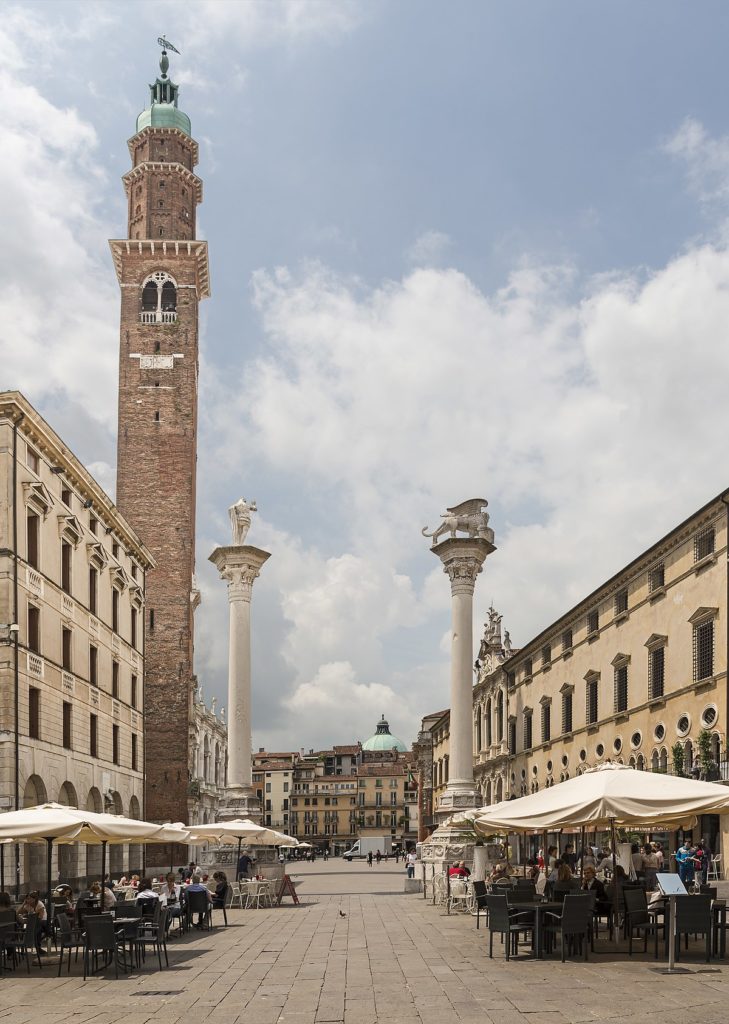
The square is dominated by the slightly leaning Bissara clock tower, dating from the 14th century. There are two towering columns, one with a winged lion (the symbol of Venice) and another with a version of Christ the Redeemer.
In the center of the piazza is the landmark Basilica Palladiana and its bell tower. Other important buildings flanking the square include the Loggia del Capitaniato and the Chiesa di San Michele detta dei Servi.
Apart from the buildings, you’ll see many other beautiful palazzos on the square, with facades in pretty shades of ochre, amber, and rust.
3. Basilica Palladiana
The Basilica Palladianna is one of Palladio’s masterpieces. It’s the top attraction and one of the best things to do in Vicenza.
The 16th century basilica has a regal facade. It was a stately double row of marble columns, which march gracefully down the piazza. The basilica is really akin to a two story loggia.
It boasts one of Palladio’s greatest inventions, known today as the “Palladian Window.” In architecture, a Paladian Window is three part window composed of a large, arched central section flanked by two narrower, shorter sections with square tops.
Walking through the open arches gives you a chance to admire the architecture up close.
Inside the first floor of the basilica is a huge open room with a high vaulted wooden ceiling and many arched windows.
The crowning glory of the Basilica Palladiana is its outdoor terrace. Surrounding the building’s hull-shaped rooftop, the terrace is a great place to take in the beauty of Vicenza and the surrounding Berico Hills from a birds-eye view.
The basilica also houses a museum with a fantastic collection of relics and artifacts, the Museo del Gioiello . It’s lauded as the only jewelry museum in Italy.
The museum has a beautiful exhibition space, with rotating exhibitions. The museum has helped cement Vicenza’s reputation as a hotspot for jewelry and goldsmiths.
4. Monument of Andrea Palladio
A marble statue of a Palladio sits next to the west side of the Basilica Palladiana. It’s rendered in a classical style, showing a rather pensive Palladio.
There are cafes next to the monument. It’s a great place to stop for a coffee or cocktail. You can eat and drink in the company of Palladio himself, while simultaneously admiring his monuments.
4. Bisarra Clock Tower
Dominating the Piazza dei Signoria is the 14th century Bissara clock tower, called Torre Bissara. It leans slightly, like the Leaning Tower of Pisa , but is still functional.
The skinny tower is 82 meters high and sits on a Roman foundation. It’s definitely the tallest structure in Vicenza. The tower has a bright blue clock on one side. It’s topped with a bronze dome, now green, and weather vane.
You can’t climb the tower itself. But you can inspect it from the terrace of the basilica or gaze at it from Mount Berico.
5. Palazzo del Capitaniato
This beautiful Palladio-designed palace is also known as Loggia del Capitanio. The palace served as the residence of the Venetian governor. Begun in 1571, it was one of Palladio’s last works. It now serves as the Town Hall.
It’s a grand structure. The facade is divided by four monumental granite columns and three large arches.
The building is made of red bricks, lavishly adorned with statues and bas-reliefs. In contrast to unornamented facade of the basilica, the loggia is richly decorated with carvings and contrasting colors.
On the noble floor is the Sala Bernarda, decorated with 16th century frescoes. The building was decorated by Lorenzo Rubini and has been recently renovated.
6. Palazzo Thiene
Another Palladio building of note is Palazzo Thiene (now a bank). This is an early work by Palladio.
It has rusticated levels, which are reminiscent of the medieval palazzi like Medici Palaces in Florence . The upper level are more refined. The pilasters and blocking of the windows are clearly inspired by Roman buildings.
Inside, however, you’ll find perhaps the most exuberant building in Vicenza. The rotunda has a lavish ceiling completed by Bernardino India.
7. Palazzo Chiericati | Museo Civico
The Chiericanti Palace is a top attraction in Vicenza located on the Corso Andrea Palladio. The palace is flat out striking.
It’s a perfectly composed two story building with two levels of colonades. The facade has both open space (on the lower level) and solid space with windows (on the upper level). Stucco sculptures adorn the roof.
Housed within the palace is another of Vicenza’s top attractions, the Museo Civica. Founded in 1855, the Civic Museum of Vicenza contains a vast collection of artifacts, archaeological finds, altarpieces, and artwork from the region.
The ground floor is used for temporary exhibitions. This is where you’ll find the Sala dal Firmamento, Salon of the Skies. It has racy ceiling fresco of Diana and Helios by Domenico Brusasorci.
Highlights in the upstairs galleries include Anthony Van Dyck’s allegorical The Four Ages of Man and Alessandro Maganza’s Portrait of Maddalena Campiglia .
You’ll also find a selection of paintings from renowned Venetian Renaissance artists such as Tintoretto, Tiepolo, and Veronese.
8. Gallerie d’Italia in the Palazzo Leoni Montanari
This magnificent palazzo houses the art collection of Gallerie d’Italia , a museum with branches in Milan and Naples.
The underrated collection features everything from Ancient Greek pottery to 18th century Venetian masterpieces by stars like Canaletto, Pietro Longhi, and Francesco Guardi. In fact, there’s an entire room of paintings by Longhi. The museum also has Western Europe’s largest collection of Russian religious icons.
Two sculptures that caught my eye were Venus by Angelo Marinali and Agostino Fasolato’s massive pyramidal sculpture The Fall of the Rebel Angels.
The palace itself is simply stunning. In contrast to the rest of Vicenza, it’s unabashedly Baroque in style. You’ll gaze in awe at ornate gilded ceilings, frescoed walls, cherub-cluttered ceilings, and stuccoed reliefs. Click here for a complete description of the palazzo.
9. Olympic Theater
Behind a walled garden lies the Teatro Olympico , or Olympic Theater. It’s one of the best things to do and see in Vicenza.
Inaugurated in 1585, this unique Renaissance theater has somehow survived for four centuries. Palladio drew inspiration from the Roman theater in Orange, a landmark in southern France .
The theater was commissioned for the performance of classical dramas. Palladio began building in 1580. But he died that same year. The theater was completed after his death by Vincenzo Scamozzi.
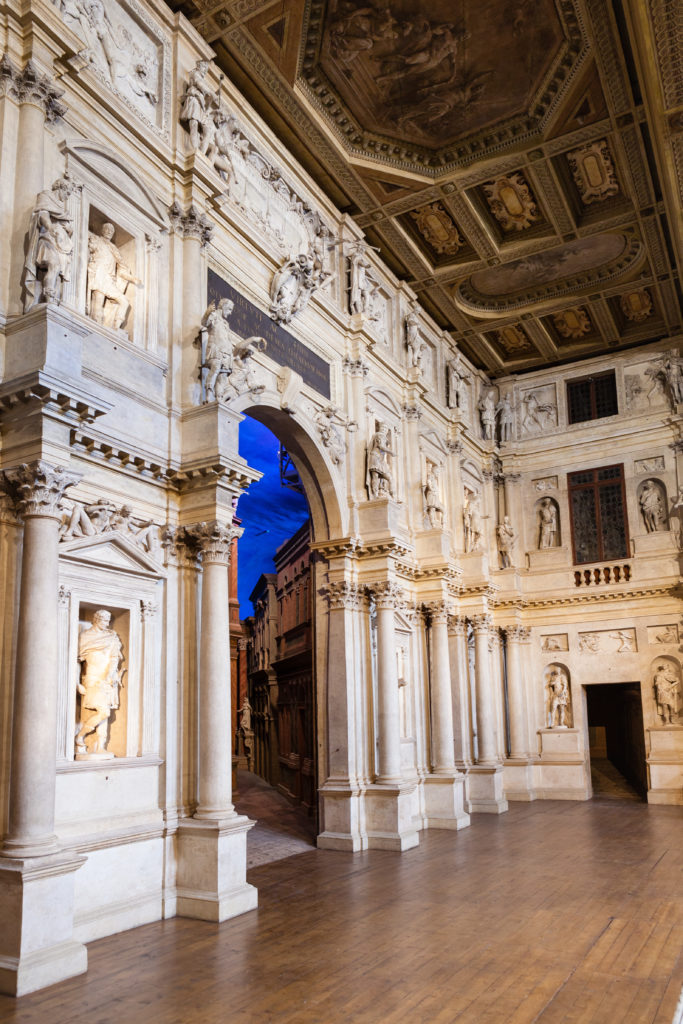
The small theater is a must visit UNESCO site. This architectural marvel is one of only three Renaissance theaters still standing in Italy. To my mind, it’s the best thing to do in Vicenza.
The theater site consists of three rooms. The first two rooms were frescoed by Francesco Maffei in 1647 using Greek themes. The third room is the actual theater.
The theater recreates an ancient Roman amphitheater as an indoor Renaissance playhouse. The interior is made entirely of stone, stucco and wood.
The materials create the effect of white polished marble. The curved auditorium has an intricate colonnade adorned with niched statuary and a balustrade topped with more statues.
The overall effect is more palace than stage. There are 1,000 seats, rising in tiers, topped with statues of classical gods and heroes. Above is a cloudy blue sky frescoed on the ceiling.
The theater’s original stage sets are still in situ. It’s an optical illusion, meant to represent the city of Thebes. Framed by a triumphal arch, five streets recede at different angles. The streets depict an idealized city of Thebes.
Legend holds that Napoleon visited Teatro Olimpico in the early 1800s intending to pillage the sculptures. Fortunately, when he learned that the sculptures were plaster, not marble, he turned up his nose and left them behind.
The theater is still used for concerts and classical plays in spring and fall. On a visit, you can see a sound and light show.
The Teatro Olimpico has a small garden filled with 19th century statues. The garden is a lovely place to sit in for a few minutes on a warm day.
10. Vicenza Cathedral
Vicenza Cathedral was completed in the 16th century. The original cupola, and likely the north entrance to the cathedral, were designed by Palladio.
Much of the cathedral was destroyed in WWII bombing. It was rebuilt, so it looks somewhat new with a brick facade. But the beautiful red and white marble Gothic facade survived the bombing.
The cathedral contains some beautiful chapels, including one that features a Bartolomeo Montagna madonna.
11. La Rotunda | Villa Almerico Capra
The 16th century La Rotunda is Palladio’s most famous home. It was once a trophy house and is now a sacred pilgrimage destination.
Set in elaborate and beautiful grounds, La Rotonda is located south of Vicenza, about 15 minutes from the historic center.
It’s a 10 minute bus ride from the central station. You can also bike or walk there. No matter how you go, it’s important to see this Vicenza attraction.
La Rotunda is the most copied house in history. The villa is renowned for its harmonious design and symmetry.
Among others, La Rotunda inspired Jefferson’s Monticello in Virginia, the Jefferson Memorial on the National Mall, and Frank Lloyd Wright’s Unity Church.
The villa is radically simple in design. It’s essentially a cubic domed box, reminiscent of a classical temple. La Rotunda has four equal sides with identical porticos, reminiscent of the Pantheon in Rome. In the center is a symmetrical dome. You approach via a series of steps.
Once inside, you’ll be amazed by the fresco paintings by Italian painters Alessandro, Giovanni Battista Maganza, and Canera.
Click here for information on tickets and tours.
12. Villa Valmarana ai Nani
Just minutes from La Rotunda is Villa Valmarana ai Nani , nicknamed the “Villa of Dwarves.” You can visit both in one go, and you really should just to see the splendid interior.
Click here to pre-book a ticket to Valmarana. You can also book a guided tour of the villa and the Tiepolo frescos.
A footpath connects the two villas. Villa Valmarana is a complex of three buildings, with gorgeous gardens.
The villa’s name derives from a colorful local legend. A nobleman had a daughter born a dwarf. Her father surrounded her with dwarf servants, so she wouldn’t realize she was small. But one day she saw a handsome prince.
Realizing she was a dwarf, she killed herself in anguish. Out of sheer grief, her servants turned to stone. Hence, the 17 stubby stone statues of dwarfs lining the villa walls.
The villa was designed by the Renaissance architect Franceasco Muttoni. It’s known for its superb 18th century frescos by Giambattista Tiepolo and his son Giandomenico Tiepolo.
The frescos scenes from the Trojan War, classical myths, and Italian lyrical poems. You’ll feel like you’re in a top secret private art gallery.
The villa is still owned and operated by the Valmarana family. For beautiful views, check out the terrace from the villa cafe.
The surrounding countryside has 50 spectacular country villas, many designed by Palladio (Pisani, Malinverni, Piovne, Poiana, Caldogno, and Saraceno). It is these villas in which Palladio reached his pinnacle, marrying mathematics and art.
13. Palladio Museum
If you’re fascinated with Palladio’s works and legacy, you should visit the well-curated Palladio Museum . It’s housed in the Palladio-designed Palazzo Barbarano. The museum is located in the same complex and square as the Basilica Palladiana.
The palace was one of Palladio’s more unusual buildings. It was built between 1570-75.
You can explore the frescoed halls of this modern museum, which is a place to think deeply about architecture. The artifacts on display include copies of Palladio’s celebrated Quattro libri dell’architettura (Four Books of Architecture), his drawings, and scale and digital models of his most famous palaces and villas.
Paladdio’s Four Books is considered one of the best “how to” books of all time. There’s also videos of experts explaining why Palladio was an architectural genius.
14. Church of Santa Corona
Just a block from the Olympic Theater, this 13th century church was partially designed by the legendary Palladio. He is actually buried in the church himself.
This “Church of the Holy Crown” was built to house a thorn from the Crown of Thorns, given to the Bishop of Vicenza by the French King Louis IX. (It was later moved for safekeeping to the Diocesan Museum.) Created in a Gothic style, the church has a series of brick towers, chapels and front facade.
Whilst the exterior is not overly impressive, the interior more to offer. It features the Valmarana Chapel, reputedly designed by Palladio.
There are religious scenes by famous Italian masters and an ornate altar made of inlaid marble and mother-of-pearl. The most significant work is an enormous and fine canvas by Giovanni Bellini in the left nave, Baptism of Christ. Also look for Veronese’s Adoration of the Magi .
15. Santuario della Madonna di Monte Berico
Popular legend holds that in 1426, the Virgin Mary appeared to a woman named Vicenza Pazini on Monte Berico, a hill overlooking Vicenza.
Mary told Vicenza that if she built a church on this site, the diseases plaguing the town would halt.
Vicenza worked tirelessly to build the church that stands today. And, as promised, the diseases miraculously vanished.
After that, pilgrims arrived in droves to worship at this church, called the Sanctuary of Mount Berico .
The church melds both Gothic and Baroque architectural styles. The church is home to many artworks, including a famous painting by Venetian Renaissance artist Paolo Veronese, The Dinner at St. Gregorio . The painting depicts a rather raucous version of the The Last Supper .
From the Piazzale della Vittoria in front of the church, you have panoramic views of the rooftops of Vicenza and the surrounding countryside.
To visit, you can walk up via the porticoes like the pilgrims of old. Or you can drive up to the church entrance.
READ : All The Last Supper Paintings of Renaissance Italy
16. San Michele Bridge
Just near the Basilica is one of the most beautiful bridges in the city, the Ponte San Michele. You can see the Retrone River flowing and spot beautiful houses with tumbling flowers.
The stone bridge was built in 1621-23, designed by the architects who worked on the Rialto Bridge in Venice . The bridge is covered with pebbles and provides great photo opportunities.
You should walk over the bridge itself. But also view it from the adjacent Ponte San Paolo.
17. Roman Cryptoportico
If you’re a ruin luster, Vicenza also boasts some Roman ruins. Buried beneath the city’s duomo is an abandoned Roman Cryptoportico , dating from between 1 BC and 1 AD.
In ancient Rome, a cryptoportico was covered passageway or corridor used by nobles to escape the weather (or the pestering common folk). Translated, the word literally means “hidden porch.”
A cryptoportico was usually at the ground or basement level of a villa or piazza. There are similar cryptoporticos in the Roman Forum , Diocletian’s Palace in Split Croatia , and in Pompeii.
Vicenza’s cryptoportico was only discovered in 1954, 20 feet underground. It has the distinction of being the only private cryptoportico unearthed thus far in northern Italy.
The cryptoportico has three semi subterranean passages in a U shape, located below what was likely a wealthy home. Tiny fragments of the Pompeian red paint that once decorated the walls are still visible. You can also see mosaics and terracotta flooring.
The cryptoportico is open to the public by reservation and by a guided free tour. on the second Sunday of the month. Be forewarned, it’s chilly down there.
18. Parco Querini
Need to unwind? Head to Park Querini on the north end of the old town.
It’s a picturesque green space, filled with animals like beavers, bunnies, and ducks. You can walking along the paths. Or picnic on the grass.
In the center of the pond is a pond with an island, which you can read via a footbridge. There’s also a photogenic classical temple.
19. Villa Malcontenta
A bit further afield from Vicenza (45 minutes) is another Palladio villa, officially known as Villa Foscari, but nicknamed La Malcontenta. It’s a UNESCO-listed site and beautiful well-preserved jewel.
House & Garden Magazine called it “the most beautiful house in the world.” It’s only open 2 days per week, so check the website for times, entry fees, and how to get there.
According to legend, the mansion was called the “unhappy” villa because it was a “prison” for a noblewoman accused of infidelity by her jealous husband. More likely, it just suffered from the flooding of the River Brenta.
If you want to see Malcontenta and more of Palladio’s UNESCO-listed villas, you can book a full day guided tour from Venice .
20. Day Trips From Vicenza
If you have more time in Vicenza, the city makes an excellent base for day tripping in northern Italy. From Vicenza, you can easily day trip to Venice, Verona, Milan, Mantua, Padua, Bassano del Grappa, Bologna, or Trento.
Here are some of my articles on Venice, Verona, Milan, Mantua, and Padua:
- 2 day itinerary for Venice
- History of Venice in a nutshell
- Guide to Padua’s Scrovegni Chapel
- 7 day itinerary Venice to Milan
- Guide to the mosaics of Ravenna
- 1 day itinerary for Milan
- How to see Leonardo’s Last Supper Fresco
- Guide To Must See Sites in Mantua
- Guide to the Pinacoteca di Brera
- Top art to see in Milan
Tips For Visiting Vicenza
There are few things you need to know when visiting Vicenza.
1. Opening Hours
First, the eating times are limited. The restaurants are only open for lunch between 12:00 pm to 2:00 pm.
Restaurants then close until 7:00 pm. Between that time, it’s either a grocery store or McDonalds for food, so plan accordingly.
There is great shopping in Vicenza, especially on Corso Palladio. Vicenza is an excellent place to purchase gold jewelry, if you’re looking for something unique.
2. How To Get Around Vicenza
There isn’t much public transport in Vicenza either. And only a few taxis work at night. But, for the most part, you can walk to almost all of Vicenza’s top attractions. Parts of the old town are also off limits to cars, so if you’re driving keep that in mind.
When planning your itinerary, remember that the major sites in Vicenza are closed on Mondays. For more information and a map, pop in the Tourist Office next to the Olympic Theater at PIazza dei Signori 8.
3. How To Get To Vicenza
Now that I’ve (hopefully) persuaded you to see Vicenza’s top attractions for yourself, how do you get there?
Vicenza is 47 miles from Venice. It’s a 50 minute drive. From Verona to Vicenza, the distance is 32 miles. You can do the drive in about 40 minutes in normal traffic.
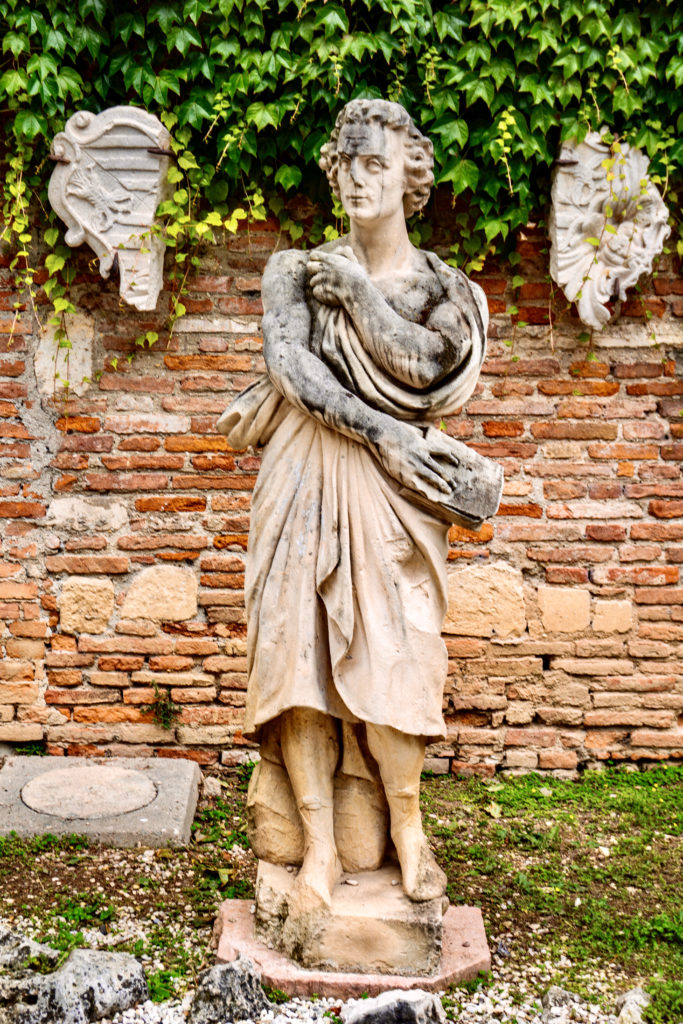
If you’re day tripping or visiting from Milan, Vicenza is 128 miles away, with a drive of approximately 2 hours.
Vicenza’s train station is on the main Milan-Venice train line. You can get direct trains to many towns and cities in the Veneto and Lombardy regions of Italy.
A fast train from Verona to Vicenza is a zippy 25 minutes. Regional train times vary. The relatively faster ones take between 33 and 39 minutes. There are multiple departures each day in both directions.
A fast train from Venice to Vicenza is 40 minutes. A faster regional train get syou from Venice to Vicenza in 45 minutes. There are numerous departures in both directions each day.
You can get from Milan to Vicenza by direct fast train in about 1:40, with multiple departures each day in both directions.
Click here to check the official website, Trenitalia, for times and fares.
Once you arrive via train in Vicenza, allow 12 minutes to walk from the train station to the Piazza dei Signori in the historic center.
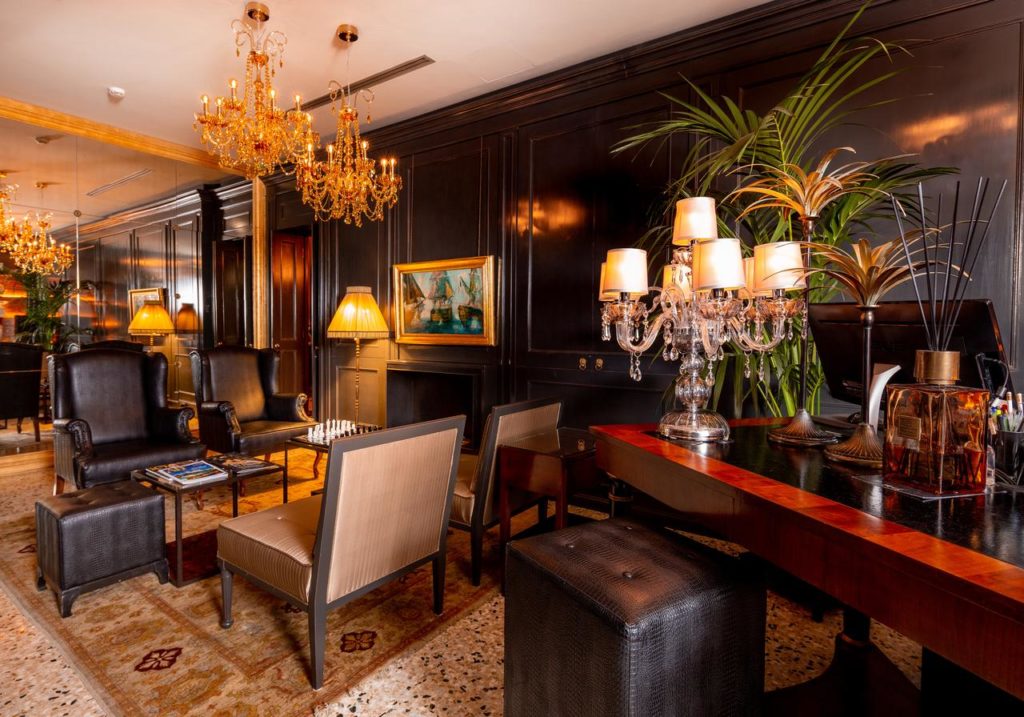
4. Where To Stay In Vicenza
Vicenza is a small city (112,000+), so there’s not much accommodation. The hotels are nothing special. But they are very inexpensive compared to nearby Venice.
There are several good options:
- Hotel Palladio (a glam hotel near the main sites)
- Glam Boutique Hotel (an elegant boutique near the main sites)
- Golf Hotel (stylish boutique off the city center)
- Antico Hotel Vicenza (set in an ancient building just steps from Piazza dei Signori)
I hope you’ve enjoyed my guide to best things to do and see in Vicenza. You may enjoy these other Italy travel guides and resources:
- 3 day itinerary for Rome
- 3 day itinerary for Florence
- 10 day itinerary for Tuscany
- 10 day itinerary for Italy’s classic cites
- 7 ways to spend 1 week in Italy
- 10 day itinerary from Milan to Rome
- 30 beautiful towns in Italy
- 100+ Italy bucket list experiences
- Tips for visiting Italy
- Historic landmarks in Italy
If you’d like to visit Vicenza’s top attractions, pin it for later.
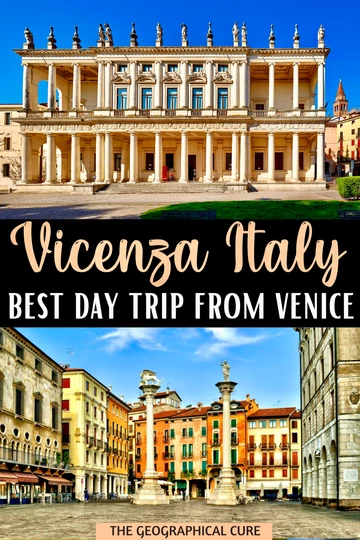
Leave a Comment Cancel reply
Save my name, email, and website in this browser for the next time I comment.
Last Updated on June 23, 2023 by Leslie Livingston
Must-see attractions in Vicenza
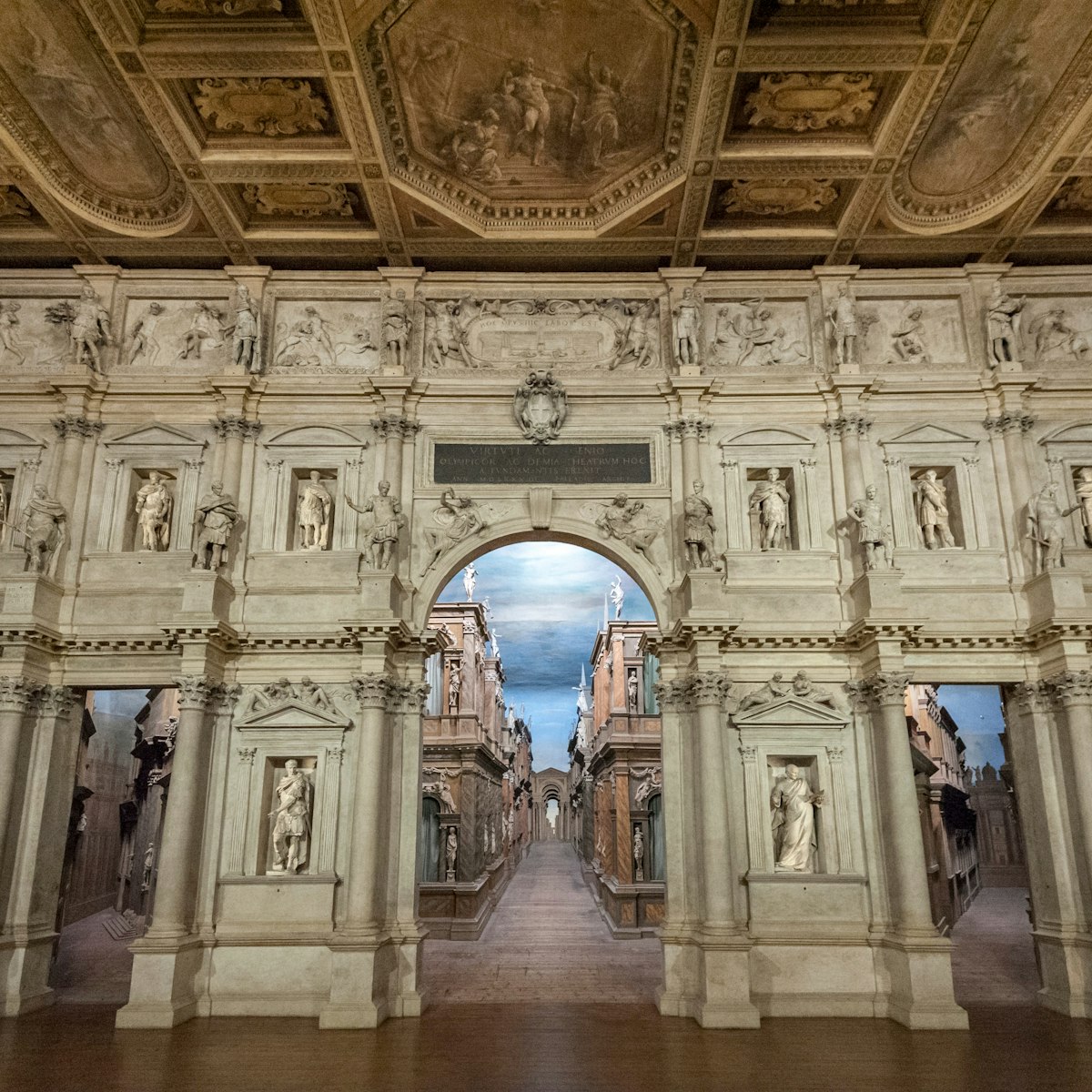
Teatro Olimpico
Behind a walled garden lies a Renaissance marvel: the Teatro Olimpico, which Palladio began in 1580 with inspiration from Roman amphitheatres. Vincenzo…
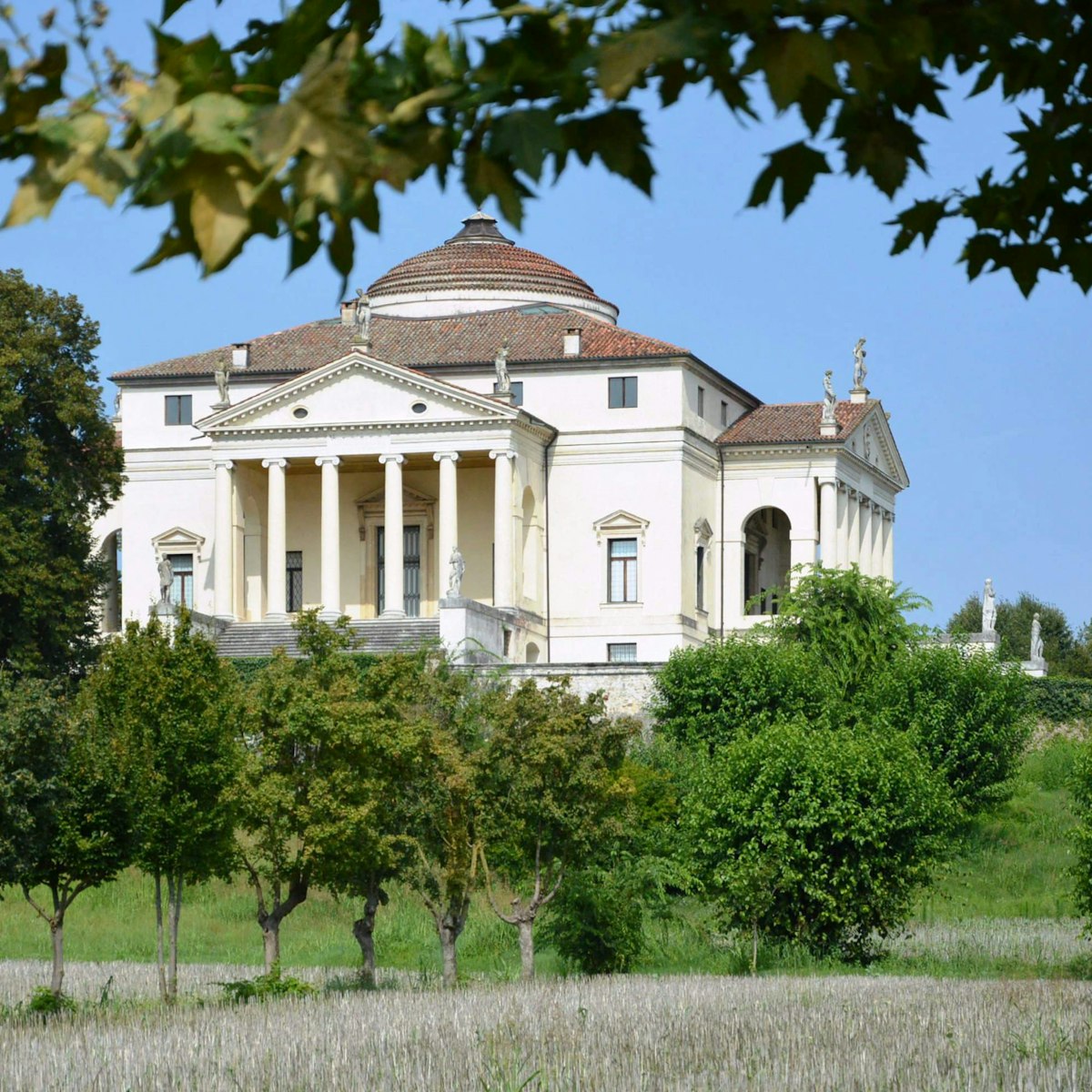
No matter how you look at it, this villa is a showstopper: the namesake dome caps a square base, with identical colonnaded facades on all four sides. This…
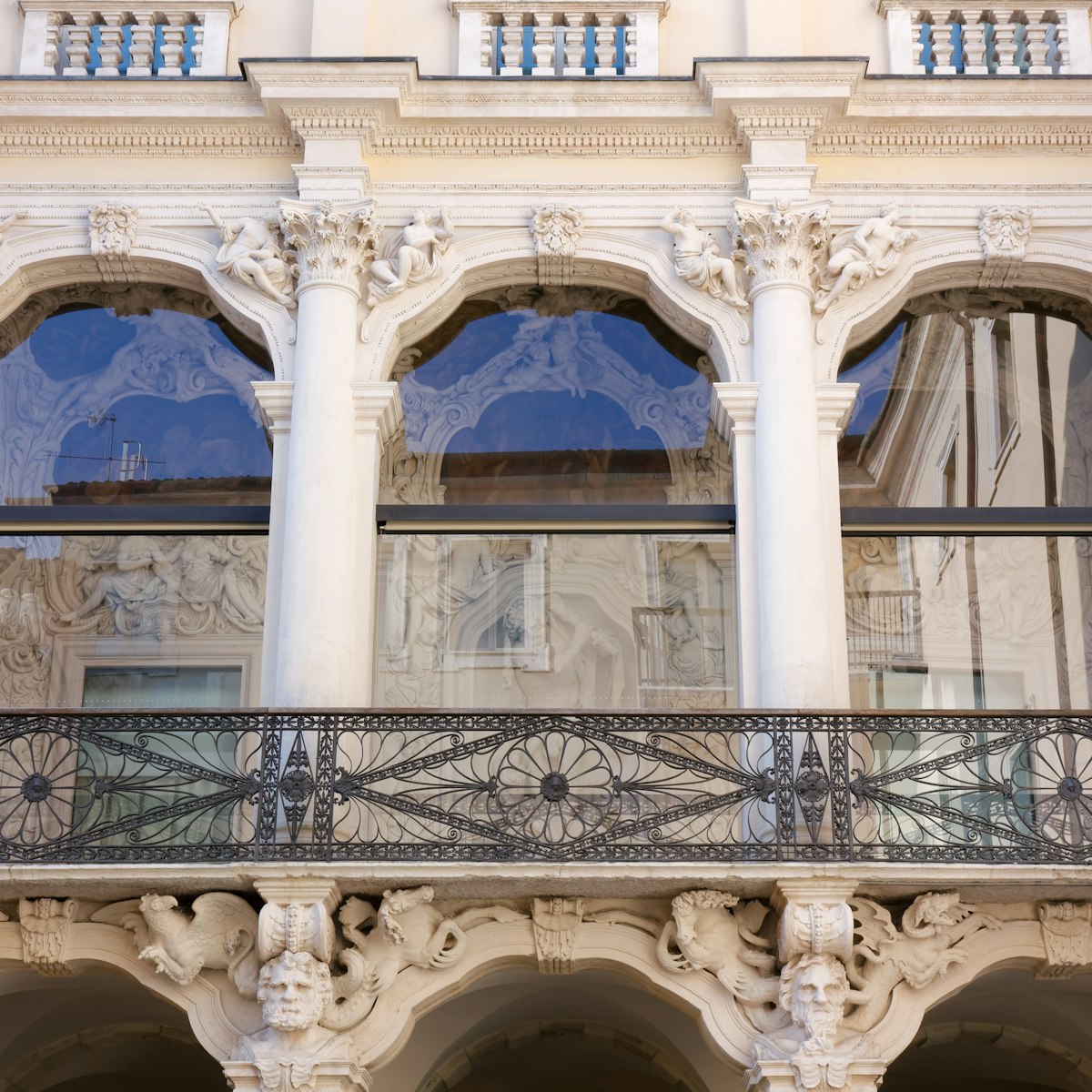
Palazzo Leoni Montanari
An extraordinary collection of treasures awaits inside Palazzo Leoni Montanari,including ancient pottery from Magna Graecia and grand salons filled with…

Basilica Palladiana
Now a venue for world-class exhibitions, the Palladian Basilica is capped with an enormous copper dome reminiscent of the hull of a ship. The building,…
Museo del Gioiello
Vicenza's expertise in jewellery dates back to 600 BC when the Vicentini were crafting clothing fasteners, called fibula. This museum celebrates that…
Palazzo Chiericati
Vicenza's civic art museum occupies one of Palladio’s finest buildings, designed in 1550. The ground floor, used for temporary exhibitions, is where you…
Villa Valmarana ‘ai Nani’
From La Rotonda, a charming footpath leads about 500m to the neoclassical elegance of Villa Valmarana ‘ai Nani’, nicknamed after the 17 statues of dwarves…
Piazza dei Signori
The heart of historic Vicenza is Piazza dei Signori, where Palladio lightens the mood of government buildings with his trademark play of light and shadow…
Palladio Museum
To better understand architect Andrea Palladio and his legacy, explore the frescoed halls of this modern museum. Artefacts include historical copies of…
Roman Criptoportico
Six metres below modern Vicenza lies one of the city's lesser-known historical treasures – a 1st-century Roman cryptoportico. Discovered during postwar…
Chiesa di Santa Corona
Built by the Dominicans in 1261 to house a relic from Christ’s crown of thorns donated to the bishop of Vicenza by Louis IX of France, this Romanesque…
Designed by Lorenzo di Bologna, construction of Vicenza's cathedral began in the late 15th century. In the mid-16th century, Andrea Palladio added his own…
Loggia del Capitaniato
This is one of the few Palladio palaces not strictly open to the public, though as it is the seat of the town council, you can in theory take a sneaky…
Chiesa di San Lorenzo
This 13th-century Gothic church was built by the Franciscans. Its finest feature is the marble portal. The interior is rather spartan.
More destinations you need to see
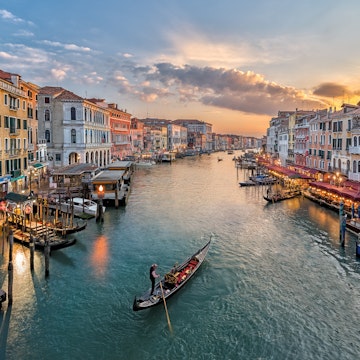
- X (Twitter)

Vicenza, Italy: An Expert Travel Guide!
The beautiful city of Vicenza in Italy is a real insider tip in the north of the country. Especially fascinating is the old town, known as a jewel of Venetian architecture , with many attractions and historical monuments. The charm of the city center is truly unique, and the Italian flair with its picturesque street alleys and squares is hard to beat. Particularly noteworthy are the many villas and palaces by architect Palladio that characterize the cityscape and are even UNESCO World Heritage sites . Other highlights include the Teatro Olimpico , the world’s first indoor theater, which attracts visitors from all over the world! But what are the most beautiful things to do in Vicenza, what are the real insider tips, and what are the must-see places?
In this travel guide, you will find all the important information and tips about Vicenza, Italy. We also show you stunning pictures, the best things to see and do, the most beautiful places in the old town, and where to find the best accommodation for your vacation in Vicenza.
Good to know!
If you are looking for a special place to stay in Vicenza, we can recommend the Relais Santa Corona , a wonderful B&B directly in the historic center.
1–2 days in Vicenza is the perfect amount of time for a stay. However, if you want to do some sightseeing in the area around Vicenza, then you should plan on 3–4 days.
There are some great places to visit around Vicenza . You can easily reach some worth visiting cities in northern Italy, such as Bassano del Grappa , Padua and Verona .
The Vicenza Card , a truly recommended combined ticket that includes the most important attractions and museums, will definitely save you money.
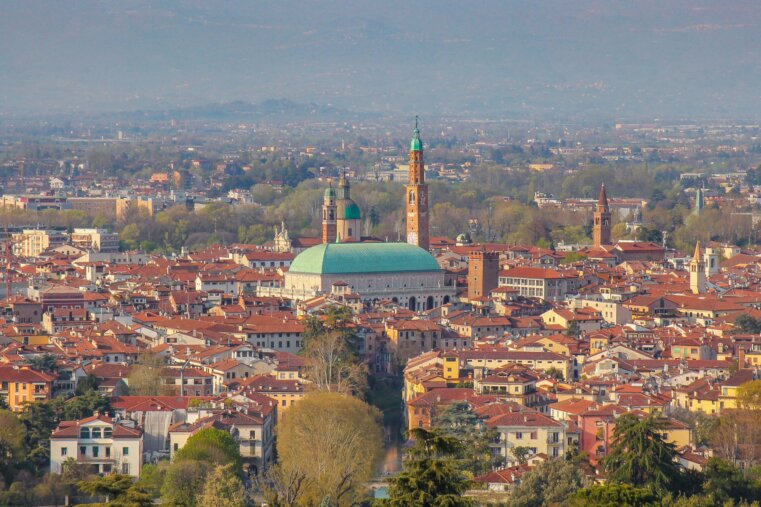
General Information about Vicenza
The city of Vicenza , with a population of 110,000, is located in the Veneto region of northern Italy and is one of the country’s most wealthy cities. No less worth seeing than its neighboring metropolises of Verona, Padua and Venice, Vicenza is considered a real insider tip for a trip to Italy. Its historic center is particularly impressive, combining Venetian architecture, rich history, and trendy lifestyle. In addition, travelers can look forward to a great culinary experience with many excellent restaurants and cafés where you can enjoy specialties such as Baccalà alla Vicentina and soak up the magical atmosphere. For shopping, head to Corso Palladio, the long boulevard in the city center, where Italian and international boutiques line up.
Vicenza is an incredibly worth seeing city, considered by many to be one of the most beautiful places in the Veneto region, with many imposing attractions . It became well-known thanks to the Renaissance architecture of the famous architect Andrea Palladio, whose buildings are still among the most important attractions of Vicenza. Together with the historic center, they are on the UNESCO World Heritage List. Among them is the Basilica Palladiana, the landmark of the city, located in the fascinating Piazza dei Signori. In addition, the city center offers many other highlights, such as museums , imposing churches and beautiful parks .
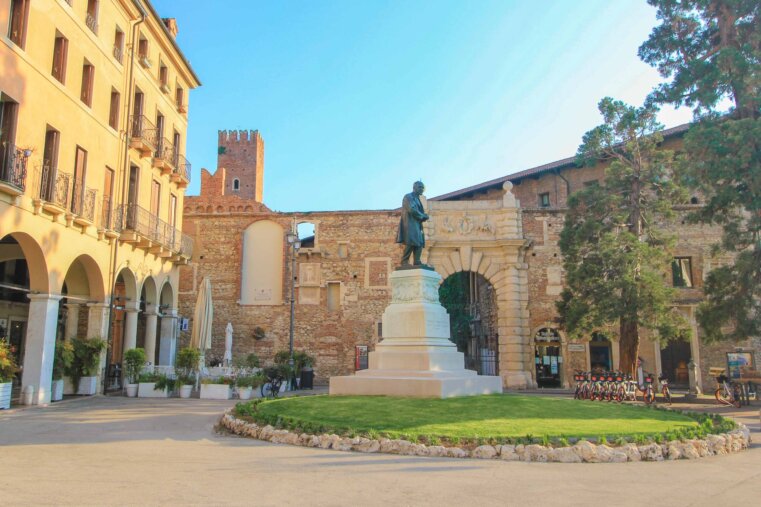
Best Things to Do in Vicenza
When traveling to Vicenza, you can look forward to a number of attractions worth seeing . Many of them are located in the old city center and can be explored on foot. To help you get the most out of your visit, we’ve summarized the best things to do in Vicenza:
Basilica Palladiana
The Basilica Palladiana , also known as Palazzo della Ragione, is one of the most beautiful attractions in Vicenza, and a visit to this architectural masterpiece of the Renaissance is almost a must on any sightseeing tour of the city. The imposing building is not a basilica in the true sense of the word, but once served as a government building with market and court halls. It was built and designed by the famous architect Andrea Palladio between 1546 and 1549. Impressive are the marble arches, whose arcades offer a breathtaking panoramic view of the Piazza dei Signori and the surrounding buildings. The interior is also worth a visit, with its 15th-century marble staircase and the large hall where temporary exhibitions are held.
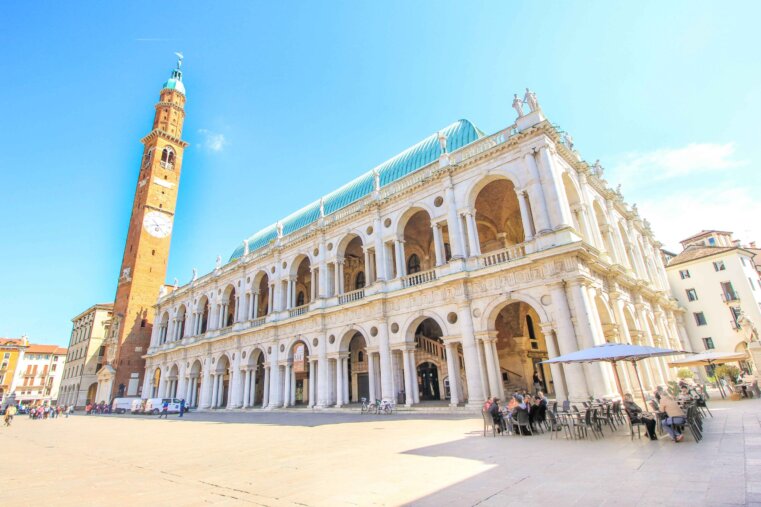
Piazza dei Signori
The wonderful Piazza dei Signori is a real jewel of Vicenza and is considered by connoisseurs to be one of the most charming squares in Italy . Located in the middle of the historic center, it is the heart of the city and a visit to this attraction is one of the best things to do in Vicenza. With a history dating back to the Middle Ages, this magnificent piazza boasts a wealth of attractions, including imposing buildings such as the Basilica Palladiana, the 82-meter Torre Bissara, the Palazzo degli Uffici and the Loggia del Capitaniato. In addition, Piazza dei Signori has many cafés and restaurants where you can enjoy the magical atmosphere. During the summer months there are also regular cultural events, concerts and festivals.
Tip : Every Tuesday and Thursday, Piazza dei Signori hosts Vicenza’s large market . It is a true shopping paradise and very popular with the locals.
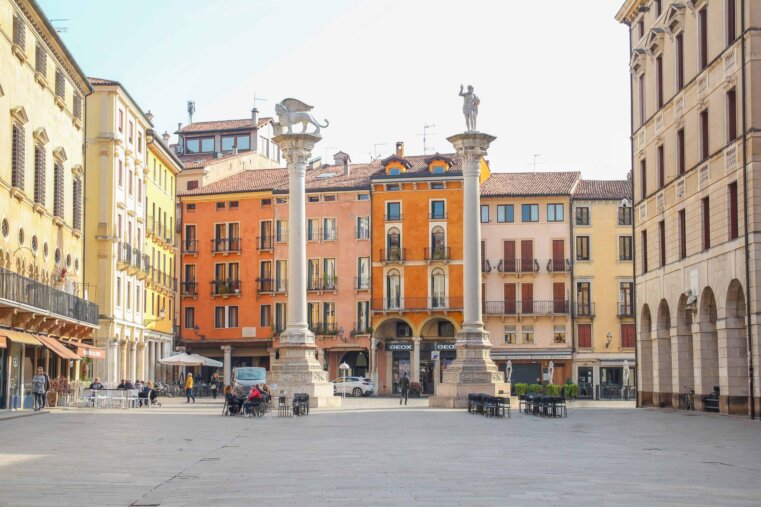
Teatro Olimpico
A real highlight in Vicenza is the Teatro Olimpico . Built in the 16th century to plans by the famous architect Palladio, it is considered one of the oldest covered theaters in the world . The fascinating interior of this ancient structure, designed in the style of a Roman theater, is particularly worth seeing and can be visited for a fee. During a tour, you can take a seat on one of the fourteen tiered rows and admire the unique set designed by Vincenzo Scamozzi . It was created in the shape of an ancient Roman street and provides a truly impressive backdrop. The Teatro Olimpico is still used today for events such as the Vicenza Jazz Festival.
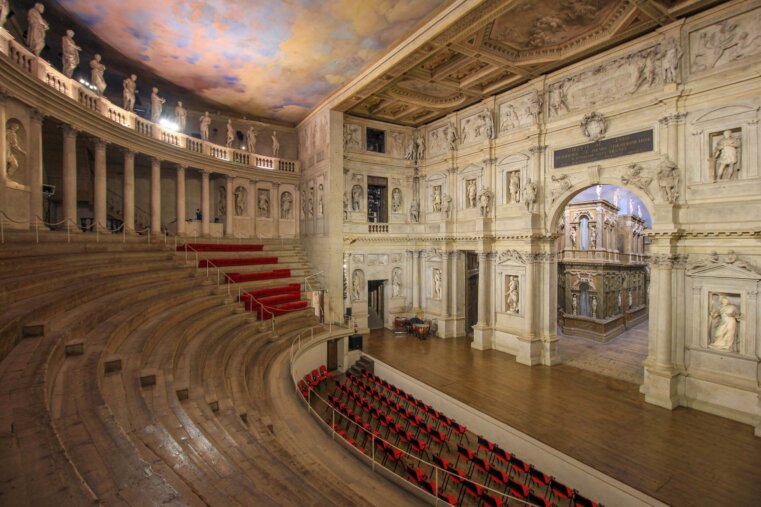
Corso Andrea Palladio
The Corso Andrea Palladio , the magnificent shopping street in the center , is probably one of the most important attractions in Vicenza and the heart of the old town. This boulevard crosses the city center from Piazza Castello in the west to Piazza Matteotti in the east, offering a unique Italian atmosphere . The magnificent, colorful facades of the many historic buildings give this boulevard a unique charm. The motto here is: See and be seen! Corso Andrea Palladio is a popular meeting place for tourists and locals to do some shopping, but most of all to enjoy the lively atmosphere in one of the many cafés .
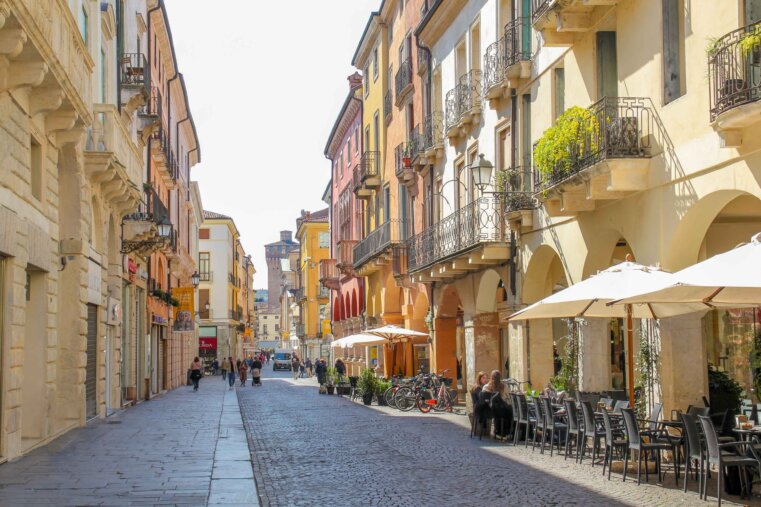
Monte Berico & Basilica di Santa Maria
A real insider’s tip in Vicenza is Monte Berico , a remarkable hill that rises majestically above the city and offers a breathtaking view of the metropolis . One of the highlights is the view from the panoramic terrace, which is located right next to the parking lot. Furthermore, at the top of the hill stands the Basilica di Santa Maria di Monte Berico, an impressive 15th century Roman Catholic pilgrimage church. The interior, with its frescoes, numerous works of art and the 15th century statue of the Virgin Mary, is also well worth a visit. Inside the church, there is also a small museum that is free of charge.
Tip : A true recommendation just next to the church is the Al Pellegrino, a charming restaurant that serves excellent coffee and delicious desserts at reasonable prices.
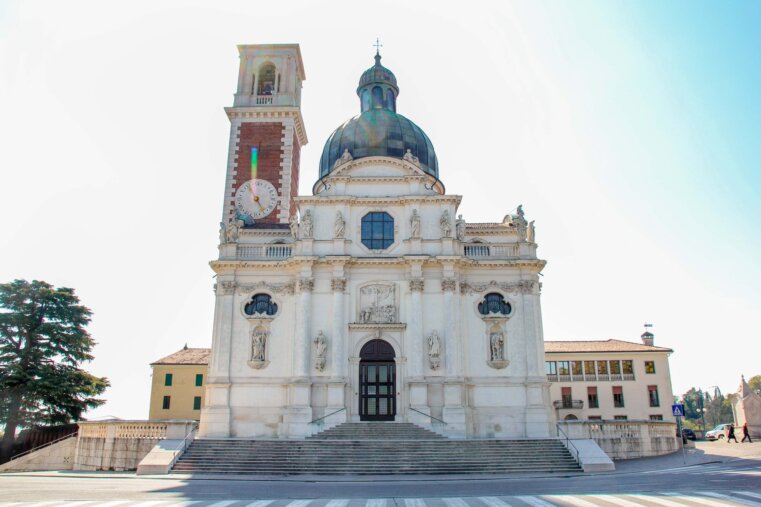
Villa La Rotonda
The Villa La Rotonda , also known as Villa Almerico Capra Valmarana or Villa Capra for short, is a beautiful gem just outside of Vicenza. This attraction was also designed by Italian Renaissance architect Andrea Palladio and has been on the UNESCO World Heritage List since 1994, along with the historic center of Vicenza and other Palladian villas. For those interested in culture and architecture as well as history, a visit to this attraction is definitely one of the best things to do in Vicenza. Built between 1567 and 1571, the Rotonda stands out for its unusual symmetrical design. It consists of a central rotunda topped by a dome. It is surrounded by a splendid portico , and the well-kept garden is also worth a walk.
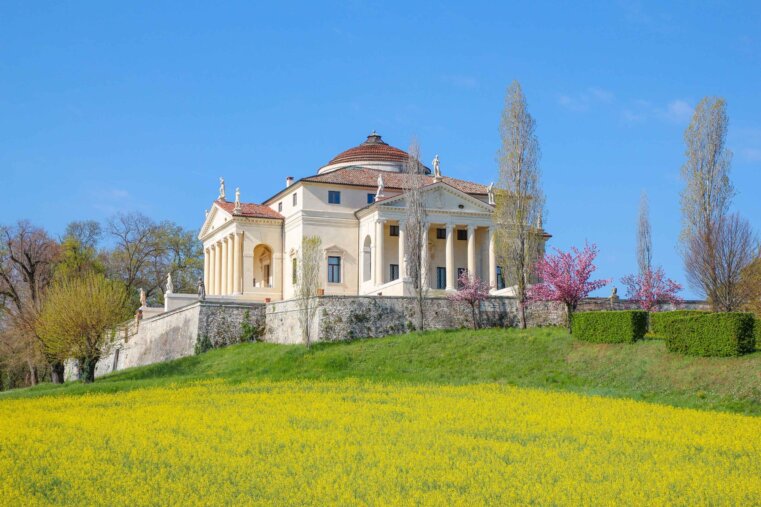
Church of Santa Corona
The Chiesa di Santo Corona is one of the exceptionally beautiful churches in Vicenza. It is located near Piazza Matteotti and, like most of the sights in Vicenza, can be easily reached on a walking tour of the city. This church was built in 1261 to house a thorn from the crown of Christ given to the Bishop of Vicenza by King Louis IX of France. Visiting the church, one can admire numerous frescoes and precious paintings . The crypt of Lorenzo da Bologna is also worth a visit, as are the magnificent chapels, including the Valmarana Chapel by Palladio.
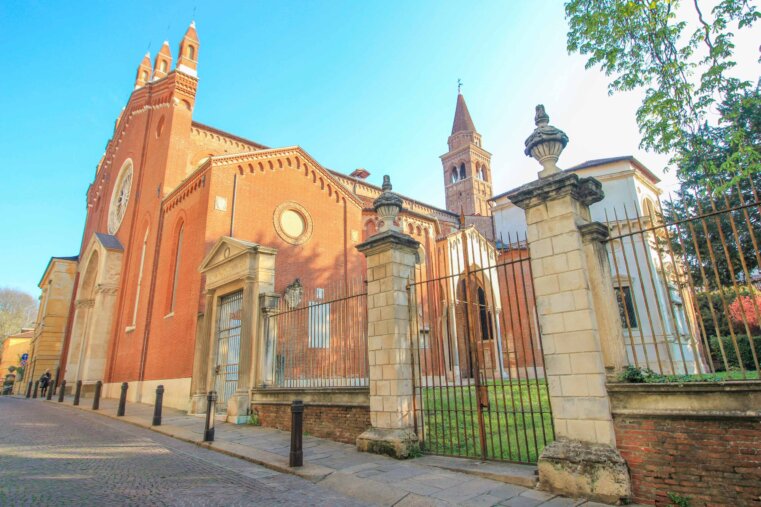
Torre Bissara
The Torre Bissara , also known as the Torre di Piazza, is one of Vicenza’s landmarks . This magnificent Gothic tower is 82 meters high, making it the tallest building in the historic center. It is built in brick and decorated with numerous Gothic elements. The tower was built in the 12th century and in the past it served as a watchtower as well as a defensive structure. The tower owes its name “Torre Bissara” to the Bissari family, who lived in the adjacent Palazzo Bissari in the 14th century. At the moment, it is not possible to climb the tower. However, a beautiful view can be enjoyed from the terrace of the Basilica Palladiana, which is open during the summer months.
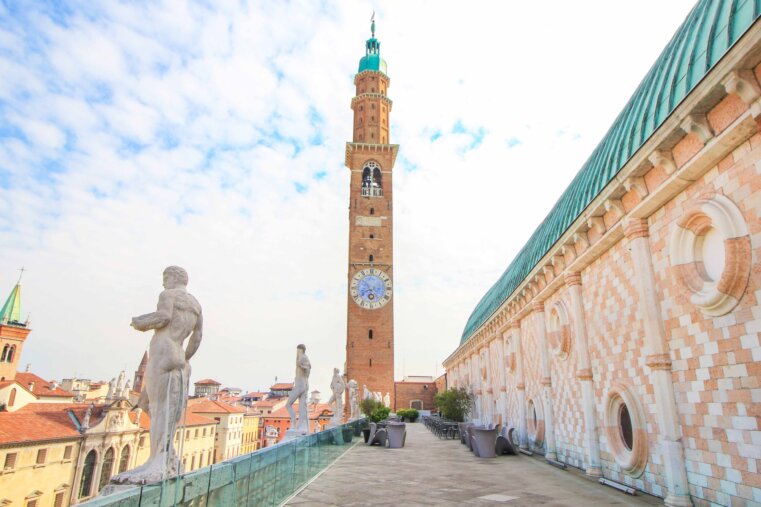
Vicenza Cathedral
The Cathedral of Vicenza , also known as Cattedrale di Santa Maria Annunciata, is one of the most important monuments in the city. This fascinating place of worship is located in the beautiful Piazza del Duomo. The Duomo was built between 1482 and 1560 to the plans of Lorenzo of Bologna. Today, the Vicenza Cathedral impresses with its picturesque Gothic façade, the freestanding bell tower and the dome designed by Palladio. The imposing interior of the Cathedral is also worth a visit. It contains numerous works of art , like the “Madonna col bambino tra le Santa Maddalena e Lucia” by Bartolomeo Montagna. In addition, there is an archaeological site located under the sacristy.
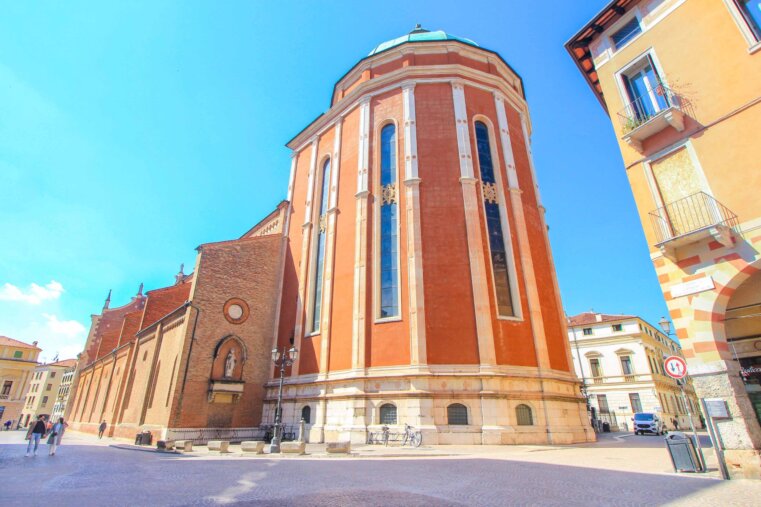
Villa Valmarana ai Nani
The famous Villa Valmarana ai Nani is located on a hill in the south of Vicenza and is a popular attraction for art and architecture lovers . It is famous for the frescoes by Giovanni Battista Tiepolo and his son, Giovanni Domenico Tiepolo, which can be admired during a visit. This beautiful mansion was built in 1669 for the lawyer and man of letters Gian Maria Bertolo. Later, at the beginning of the 18th century, it became the property of the Valmarana family of counts, who had the estate further extended. A special attraction of Villa Valmarana ai Nani are the 17 small statues, the so-called “Nani” which can be found on the garden wall of the villa.
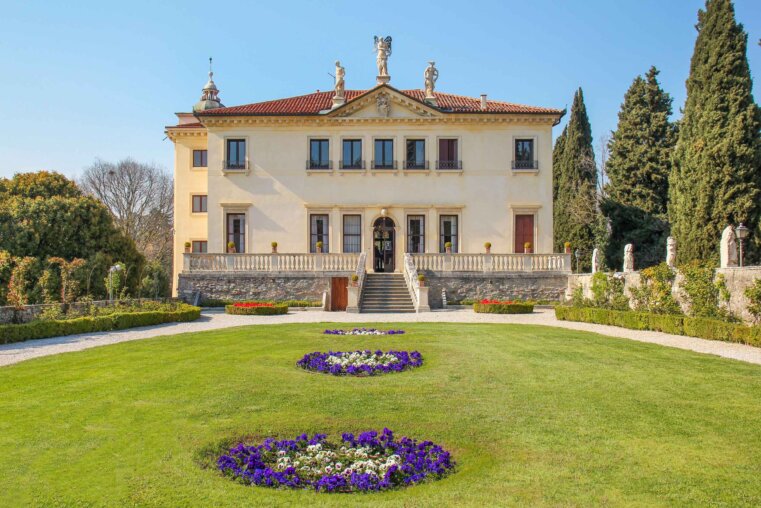
Palazzo Chiericati (Civic Museum)
A true highlight of Vicenza is the Palazzo Chiericati , which also houses the Civic Museum of the Palazzo Chiericati. This magnificent building was designed in 1550 by the star architect Andrea Palladio for Girolamo Chiericati, but was not completed until the end of the 17th century. It has a beautiful façade, columns and Greek statuary on top. Since 1855, Palazzo Chiericati has been the seat of the Civic Museum, which houses and exhibits more than 35,000 works . On display is an overwhelming collection of spectacular paintings, sculptures and applied arts from the 13th to the 20th century.
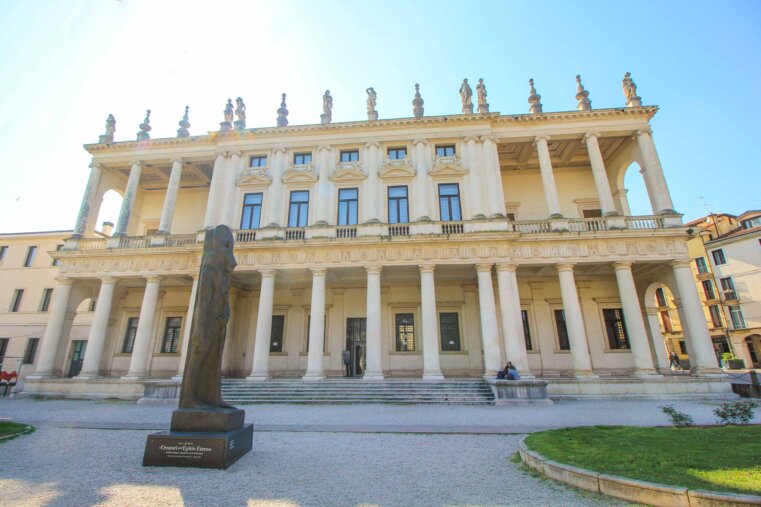
Giardino Salvi
The Giardino Salvi , or Salvi Garden, is one of the most magnificent parks in Vicenza. It is located at the gates of the historical center, in Piazzale De Gasperi, and delights visitors with its extremely romantic setting . The garden was inaugurated in 1592 by Leonardo Valmarana, but was closed a short time later. Opened to the public only in 1909, today the garden is a popular meeting place for people searching for tranquility and for families with children. There is a small duck pond and a rose garden with a Palladian terrace , which gives the Giardino Salvi a special appearance.
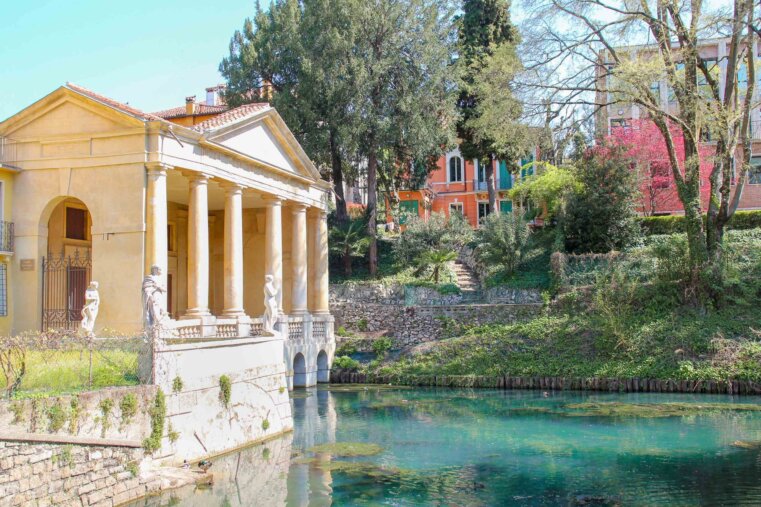
Palladio Museum
A visit to the Palladio Museum in Palazzo Barbaran da Porto is a real insider’s tip for anyone who is keen to learn more about the work and life of the famous architect Andrea Palladio. This magnificent residence was built between 1570 and 1575 for the Vicentine nobleman Montano Barbarano and today, after 20 years of restoration, it serves as a museum. During a sightseeing tour, you can admire, among other things, the elaborate ceiling frescoes. The models of Palladian villas on display are also very interesting!
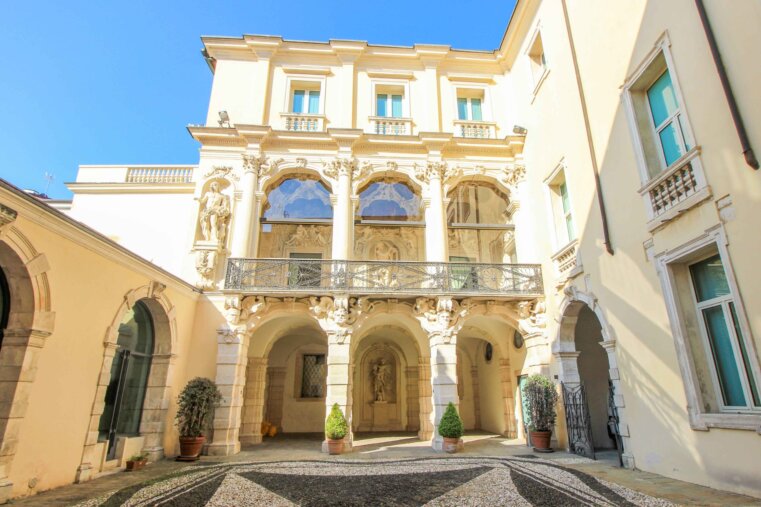
Where to Stay in Vicenza
Vicenza offers its visitors a wide range of fabulous accommodations , both in the old town and just outside. From nice guesthouses to apartments, from agriturismo to chic hotels, everything is represented here. Here are our recommendations for the best places to stay in Vicenza… It’s worth a look!
- Chic Boutique Hotel : The Glam Boutique Hotel is a great choice for a city break in Vicenza. Guests love the design, the location and the delicious breakfast.
- Cheap City Hotel : The SHG Hotel De La Ville is a good and affordable city hotel with free parking. The old town can be reached on foot or by bus.
- Beautiful B&B : The lovely Relais Santa Corona is located in an 18th century building and scores has a great central location as well as nice rooms.
- Charming Agriturismo : The Relais Maddalene101 Agriturismo is a real insider tip if you’re looking for a wonderful agriturismo near Vicenza.
Find the best accommodation in Vicenza:
More about italy:, top 20 unique things to do in rome, top 15 amazing things to do in bologna, 15 best places to visit in tuscany, italy, keep exploring.
Florence | Siena | Pisa | San Gimignano | Lucca | Brescia
Disclosure: Some of the links below are affiliate links. Meaning that if you click on certain links, and then subsequently purchase a product, I will receive a small commission at no extra cost to you.
Comments are closed.
- Hvar Island
- Brac Island
- Korcula Island
- Split Beaches
- Zadar Beaches
- Dubrovnik Beaches
- Pula Beaches
- Rovinj Beaches
- Krk Beaches
- Brac Beaches
- Hvar Beaches
- Istria Beaches
- Makarska Beaches
- Korcula Beaches
- Cities in Croatia
- Krabi Beaches
- Where to Stay in Krabi
- Koh Samui Beaches
- Where to Stay in Koh Samui
- Koh Phangan
- Trang Island
- Thailand Island Hopping
- Val d’Orcia
- San Gimignano
- Montepulciano
- Soca Valley
- Beaches in Slovenia
- Czech Republic
- Round trips
- Travel Resources
- Boutique Hotels
- Paris Boutique Hotels
- Budapest Boutique Hotels
- Vienna Boutique Hotels
- Rome Boutique Hotels
- Lisbon Boutique Hotels
- Athens Boutique Hotels
- Prague Boutique Hotels
- Madrid Boutique Hotels
- Florence Boutique Hotels
Vicenza: Tourist and Travel Guide
Elegant town in the Veneto renowned for its Palladian architecture and countryside villas
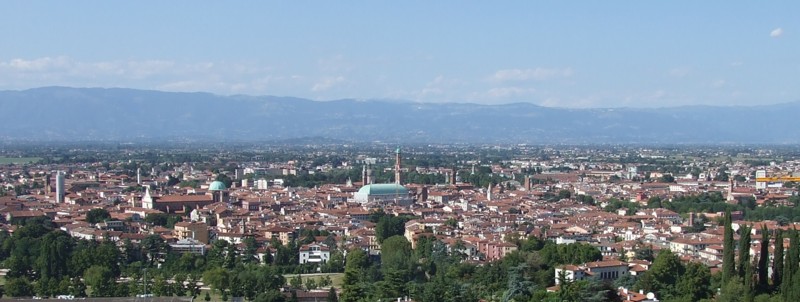
About Vicenza
Vicenza is located in the Veneto region of Italy, in its own province (the Provincia di Vicenza ). It’s a medium-sized town, with a population of 110,000. There has been a settlement here right back into the depths of history; remains of the Roman town can still be seen. Later, after the barbarian invasions which repeatedly devastated this part of Italy, it became a significant town, ruled at different times by various greater powers. For several centuries it was governed by Venice; then Napoleon, then the Austrians. In 1866 it became part of the new Kingdom of Italy.
Vicenza was a prosperous town under Venetian rule, and its pride was demonstrated in fine architecture, much of which still survives. Its ‘unique appearance,’ largely owing to the work of influential sixteenth-century architect Andrea Palladio, has led to the town’s designation as a UNESCO World Heritage Site: City of Vicenza and the Palladian Villas of the Veneto . After Palladio, Vicenza is most famous for its trade in precious metals, it’s also known as the ‘City of gold’.
It’s a lovely town to visit; with a beautiful, compact town centre and attractive villas and viewpoints in the hills a short walk away. > Villa excursion
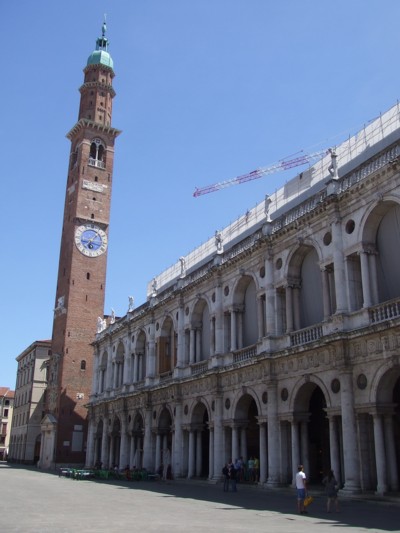
Visiting Vicenza
The railway station is to the south-west of the town centre; most of Vicenza’s attractions are clustered closely together inside the old town walls. Walking straight along Viale Roma from the railway station, you’ll pass two bus stops for the number 8 – if you are planning a trip to the villas just outside town, check the latest timetable displayed here. Soon you’ll arrive outside the old town gate, Porta Castello, but first you can visit the Giardino Salvi just outside the gateway: a shady park, ornamented with statues and the Palladian Loggia Valmarana , which is dramatically reflected in dark waters.
Just inside the gateway lies a very convenient self-service restaurant, Self Pause, which is a cheap and quick place to fill up before exploring the town centre. Around Vicenza you can admire many grand buildings by Palladio and his followers. The Italian word palazzo usually means any large building rather than a palace; but many of Vicenza’s palazzi do merit the grander translation. Some of the town’s buildings are medieval, with several in the Venetian Gothic style, but the majority date from the sixteenth and seventeenth centuries. They line the narrow lanes of Vicenza’s town centre; which are called contra , a local word for ‘street’.
As soon as you’re inside the Porta you find yourself among the town’s great buildings. One of the most curious is off to your right. Designed by Palladio, Palazzo Porto Breganze was never finished and stands in an abbreviated form. In front of you is the Corso Andrea Palladio, the centre’s main thoroughfare, lined with smart shops and cafes. Some of Vicenza’s grandest palazzi lie on Contra Porti, off to the left.
Piazza dei Signori, a few yards south of Corso Andrea Palladio, is the heart of town. It is dominated by two of Vicenza’s most striking landmarks, the Basilica Palladiana , the town’s medieval law courts, with an imposing later facade by Palladio, and the adjacent Torre di Piazza , a tall and skinny tower. Right in the long midday shadow cast by the tower you’ll find one of Vicenza’s tourist information offices , where you can pick up a town map, leaflets about local events and attractions and any advice you may need. A second office is located not far away, by the Teatro Olimpico.
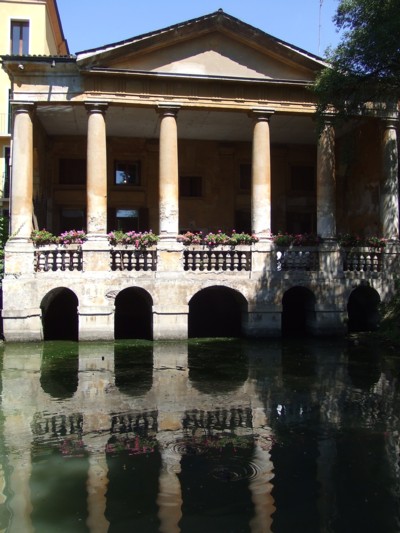
The town’s most famous individual sight is the Teatro Olimpico , Palladio’s last work, which was finished by his son and then by Vincenzo Scamozzi. The ticket you’ll buy here (8) entitles you to enter the town’s various civic museums. Conveniently, the theatre is open throughout the day with no lunchtime closure. The building was modelled on ancient Roman theatres, with a curved amphitheatre, graded stepped seating and lavish ornamentation. It incorporates a fabulous permanent stage set (designed for Greek tragedy) by Scamozzi with trompe l’oeil street scenes and classical motifs.
Over the road from the Teatro Olimpico is Palazzo Chiericati , which today houses the town’s museum (Museo Civico) and art gallery (closed Mondays, lunchtimes and also Sundays in winter). The collections here are fairly interesting; art lovers should also pay a visit to the Gothic Church of Santa Corona to see works by Giovanni Bellini and Paolo Veronese.
The Palladio links have inspired an architecture study centre and museum, the Centro Internazionale di Studi di Architettura Andrea Palladio , which houses architecture exhibitions in a palazzo designed by Palladio, Palazzo Barbaran da Porto.
For views over the area, visitors can walk uphill (or take a bus) to the Santuario di Monte Berico , a church built on the site of two apparitions of the Madonna. A long arcaded walkway climbs up the hill, which is useful on a sunny or a rainy day.
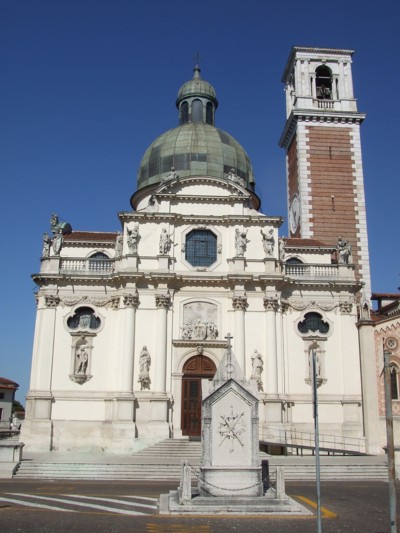
Vicenza transport
The most convenient airports for Vicenza are Treviso Airport , Venice Marco Polo and Verona. If you’re arriving from Marco Polo Airport, take a connecting bus to Mestre (the Venice mainland station) where you can pick up the train.
Vicenza can be reached in 45 minutes from Venice by taking one of the faster and most expensive trains; a cheaper option will take just over an hour. Padua is 20 minutes away by rail. Coming from Treviso, travellers will sometimes have to change at Mestre, although there are also direct ‘stopping’ trains; either way, the journey will take you just over an hour. The rail journey from Verona takes between 25 and 45 minutes, again depending on the category of train. Vicenza and its surrounding area are served by local buses, although you’ll be able to sightsee on foot in the city centre.
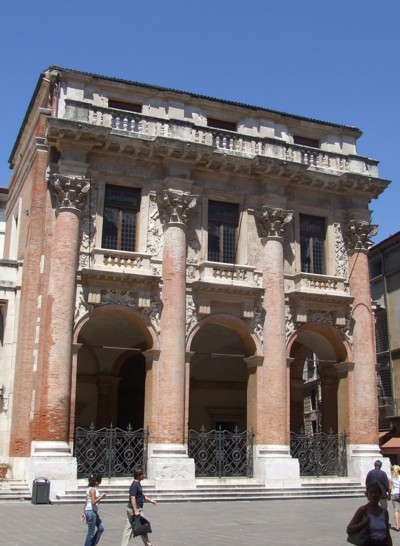
Things to do around Vicenza
Vicenza is connected by rail to Venice , Padua and Verona for easy daytrips. It’s a good central base for exploring the Veneto region, from Lake Garda in the west to Treviso and Venice in the east – this is particularly easy if you have a hire-car. Rail and bus services do cover the area, though, so you can still manage a lot of exploring using public transport.
The elegant villas around Vicenza would make the area worth visiting even without the town. Several were designed by Andrea Palladio, but there are plenty of others to be visited. Among the most well-known is the Villa Valmarana ai Nani (‘of the dwarves’), so-called because of its decorative statues. Nearby is Palladio’s famous villa, La Rotonda . Both of these are in the outskirts of Vicenza and can be reached by bus number 8. They can be combined in a walking excursion with Monte Berico – read directions in our Vicenza villas article .
Further from town you’ll find a good assortment of villas which are open to the public. Pick up maps and check the latest opening times at the tourist information office before you set off, as many have limited visiting hours. Hiring a car will make exploring much easier, but with careful planning – and allowing more time – you can manage some interesting day trips by bus.
> Book a hotel or B&B in Vicenza
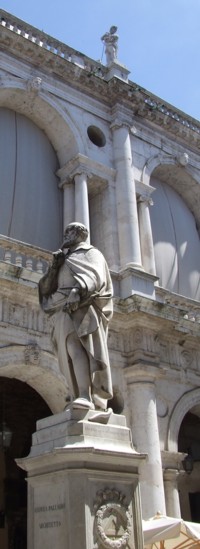
On this site
Vicenza villas – an afternoon excursion
Veneto art & architecture itinerary
Treviso Airport
Useful external links
Vicenza hotels & B&Bs
Italy car hire
Palladio Centre & Museum
Villa Valmarana
Vicenza bus routes
UNESCO listing

15 Top-Rated Tourist Attractions in Padua
Written by Barbara Radcliffe Rogers Updated Dec 25, 2023 We may earn a commission from affiliate links ( )
Padova, anglicized to Padua, is a city of visual contrasts. In a relatively compact area lie the narrow streets of its old town, the Renaissance grandeur of its main squares, the Byzantine domes of the St. Anthony shrine, and the broad symmetrical vista and statue-lined waterway of Prato della Valle.
Just as varied are its tourist attractions, which include a prestigious university with the world's first botanic garden and anatomy theater, a frescoed chapel that is one of Italy's primary artistic treasures, and the burial place and shrine of one of the world's most revered saints.
From its Roman beginnings, it was one of Italy's wealthiest cities, and in the 14th century, it drew some of Italy's finest artists: Giotto, Giovanni, Donatello, Paolo Uccello, and others who left the city a largesse of artworks.
All this history and art gives tourists plenty of things to see and do. Learn more about the sights in and around the city with our list of the top tourist attractions in Padua.
See also: Where to Stay in Padua
1. Basilica di Sant'Antonio
2. cappella degli scrovegni, 3. piazza dei signori and palazzo della ragione, 4. musei civici and eremitani church, 5. villa pisani, 6. cruise or bicycle along the brenta canal, 7. prato della valle, 8. cathedral and baptistery, 9. musme - museum of the history of medicine, 10. orto botanico, 11. piazza del santo, 12. university of padua and anatomical theater, 13. day trip to euganean hills and thermal spas, 14. visit the nearby town of este, 15. drive to montagnana, where to stay in padua for sightseeing, map of attractions & things to do in padua.
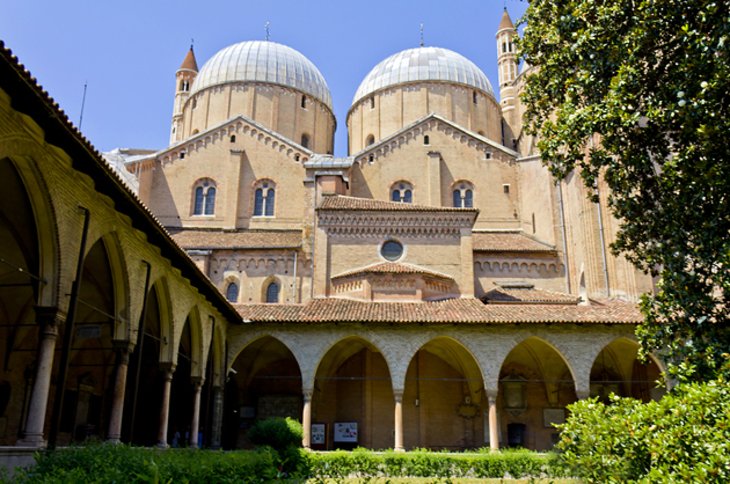
Although he was born in Lisbon, Portugal, the eloquent 13th-century preacher, St. Antony, lived and worked in Padua, which claims him as its own. The saint is buried here, at the immense Basilica di Sant'Antonio, a popular pilgrimage destination since its construction began in the year following his death.
The pillared basilica shows a fantastic mingling of Romanesque, Gothic, and Byzantine features, and is highly picturesque, with its two slender towers; the conical dome over the crossing; and seven other round domes, which were heightened in 1424.
The interior is equally interesting and filled with notable artworks. In the north aisle is the 16th-century Cappella di Sant'Antonio , with nine high reliefs of the same period, scenes from the life of St. Antony by Jacopo Sansovino, Antonio, Tullio Lombardi, and others. The chapel also contains beautiful marble inlay. Inside the altar, which is hung with ex-votos, are the saint's remains.
The high altar by Donatello (1443-50), restored in 1895, has the original sculpture, also by Donatello. His bronze panels are hard to see, but you can get a good view of the stone bas reliefs. On the left of the altar is a magnificent bronze candelabrum.
Beyond the ambulatory (with several frescoed chapels), in the Cappella del Tesoro or Cappella delle Reliquie (1690), are fine examples of gold work. On the south side of the church are four beautiful cloisters, built from the 13th to 16th centuries.
Address: Piazza del Santo 11, Padua
Official site: http://www.santantonio.org/en/basilica
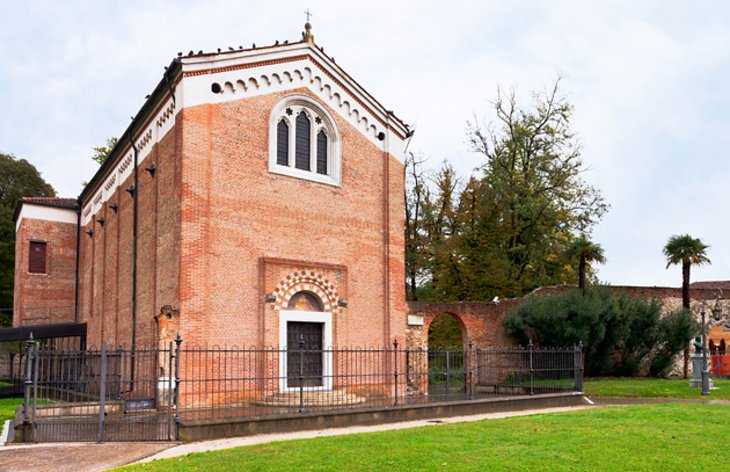
The chapel of the Madonna dell' Arena was built from 1303 to 1305 as the chapel of a palace that was demolished around 1820. While it may not look extraordinary from the outside, its interior is one of Italy's most priceless art treasures. The walls of this chapel are entirely covered with frescoes painted by Giotto from 1303 to 1306.
These scenes from the life of the Virgin and the life of Christ are Giotto's earliest, largest, and best preserved works. Particularly fine are the Kiss of Judas and the Lamentation in the third row, depicting the Passion with great dramatic force. The colors are vivid, and the expression far ahead of Giotto's contemporary artists. On the altar is a Madonna with Two Angels , an outstanding sculpture by Giovanni Pisano.
After meticulous preservation efforts, the chapel is now protected by a sealed and monitored atmospheric system, and public access is limited and timed to control the frescoes' carbon dioxide exposure. To see the chapel, you must make advance reservations; same-day reservations are no longer possible, even in less crowded seasons.
Address: Piazza Eremitani 8, Padua
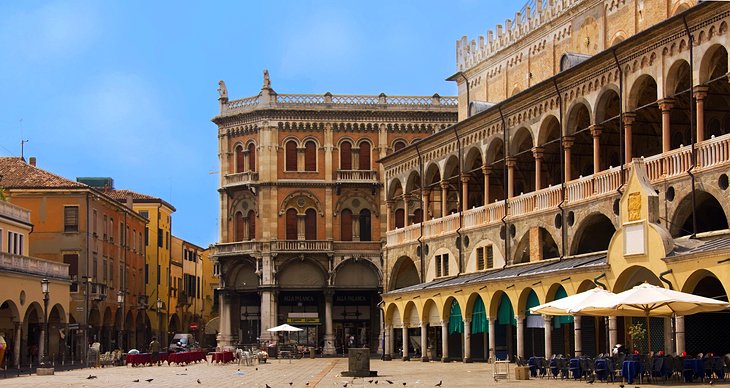
In the heart of Padua's old city, three adjoining squares have been the center of life for Padovani since the Middle Ages. Between Piazza della Frutta and Piazza delle Erbe, the Salone or Palazzo della Ragione, built 1218-19 as a law court, is Europe's largest medieval hall. Its walls are covered in hundreds of fresco panels with astronomical, mythological, and zodiac themes.
Also inside the huge hall, which was rebuilt in 1430, is a large 15th-century wooden horse, a copy of Gattamelata's horse in Donatello's famous statue in the Piazza del Spirito. In the Piazza dei Signori is the elegant Early Renaissance Loggia del Consigli, or Loggia della Gran Guardia, and a tower with a 14th-century astronomical clock.
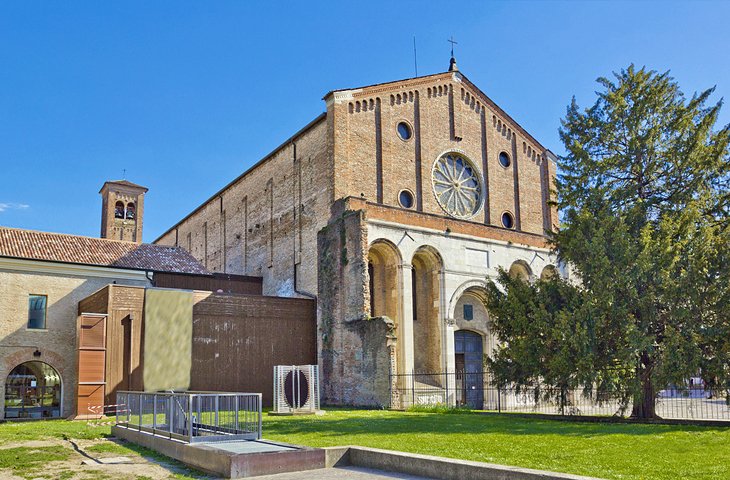
Two outstanding museums and the Romanesque Church of the Eremitani combine with the Scrovegni Chapel to make up the Musei Civici. The art gallery exhibits paintings by Giotto, Bellini, Giorgione, Titian, Tiepolo, Veronese, and Tintoretto, as well as works by Flemish and Dutch artists.
It is one of the finest collections of work by artists of the Veneto region between the early 14th and 19th centuries. A particular treasure is the cross painted by Giotto for the Scrovegni Chapel, now in the museum.
The archaeological collections begin with pre-Roman finds from necropolises in the area dated as far back as the eighth century BC. Outstanding among the early mosaics is the fourth-century mosaic of Eutherius. Be sure to look for the elegant memorial of the young dancer and juggler Claudia Toreuma.
There are rooms of Etruscan, Greek, and Italian artifacts, plus the Egyptian collections. One section follows the Via Annia, a Roman road linking north-eastern Italy to the extensive Roman road network throughout the peninsula. Using multimedia stations, you can follow this road and the archaeological evidence from it in museums throughout its route.
The former Augustinian Church of the Eremitani from the 13th century, damaged by war, has remains of frescoes by Mantegna in the Cappella Ovetari, as well as frescoes bt Giotto's student, Guarieto.
Official site: http://padovacultura.padovanet.it/en/musei/city-museums
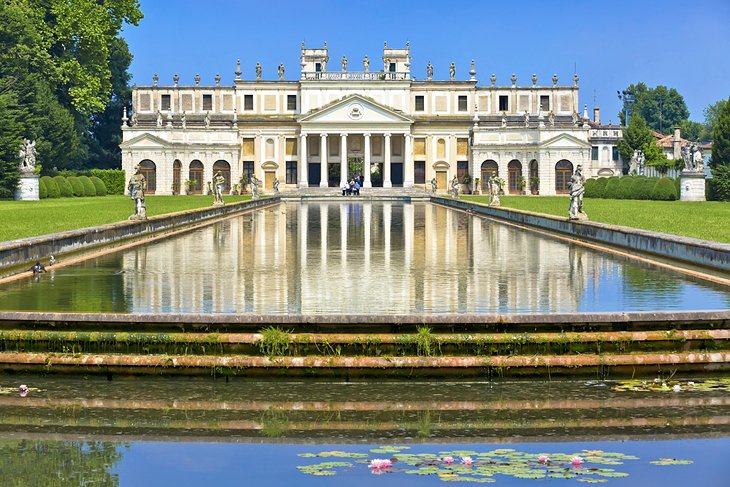
In Stra, just outside Padua, is the 18th-century Villa Pisani or Villa Nazionale. Its splendid galleried ballroom has a large ceiling painted by Tiepolo in 1762, and its more than 100 rooms are furnished in Empire style. The villa, built by the powerful Pisani family, later belonged to Napoleon and the Hapsburg emperors.
Don't miss the gardens with what is considered to be the world's most puzzling garden maze. Tall, dense hedges form nine concentric rings, with the path to the center obscured by multiple dead ends. The prize for completing it is to climb the tower in the center and watch others making their way through it. Besides the maze, the 30 acres of lavish gardens feature follies, a long reflecting pool, and an orangery.
Address: Via Doge Pisani 7, Stra
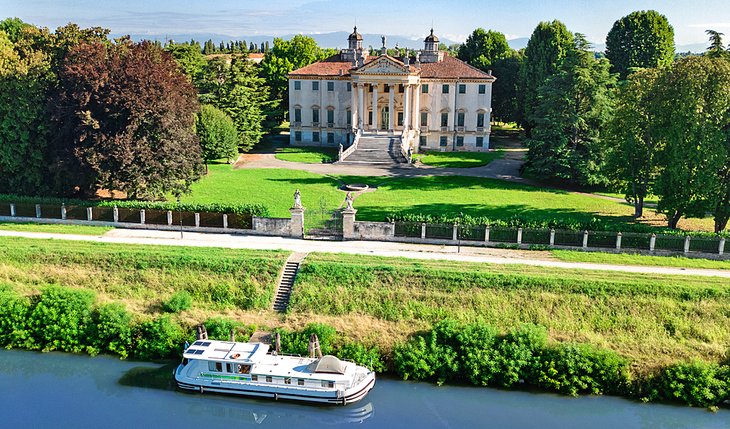
The River Brenta, which flows through Padua and enters the Adriatic Sea in Venice, has been canalized since the days of the Venetian Republic, and it was a favorite place for wealthy Venetians to build palaces where they could escape the summer heat. They hired the preeminent architects and artists of the period to build and decorate the villas that still line the canal.
One of the most popular things to do in Padua in the summer is cruising the canal between Padua and Venice. An excursion boat, Il Burchiello, makes daily trips, stopping at several palaces along the way.
In addition to the Villa Pisani and its beautiful gardens (see above), the Villa Widmann-Foscari-Rezzonico in Mirais is worth visiting. Fully furnished with period pieces and Murano glass chandeliers, the villa has stunning frescoes by Giuseppe Angeli, and is set in lovely wooded grounds with rose gardens.
Also in Mira, Villa Foscari (commonly called La Malcontenta) was designed by the Renaissance architect Andrea Palladio.
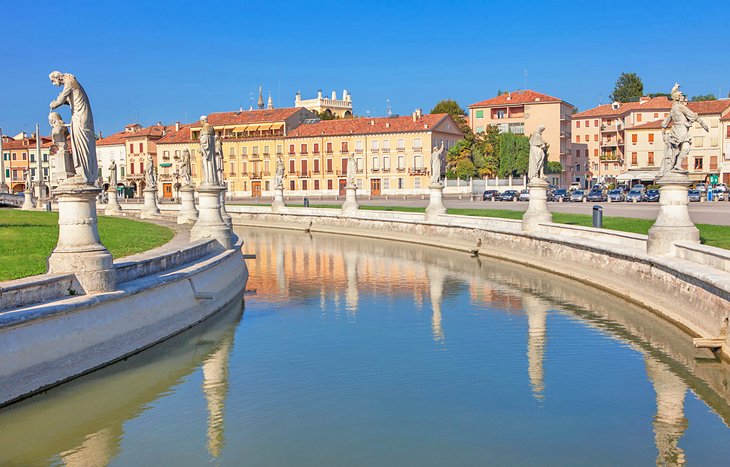
Padovans love this enormous square, the largest in Italy and one of the largest in Europe, and call it simply Il Prato. It was once a big swamp, then a grounds for jousting tournaments when, in the late 1700s, Andrea Memmo, whose palace still overlooks the square, conceived of a large plaza and park, and work began on the public space you see today.
At its center is a green park surrounded by a canal; along its banks stand 78 statues, including one of Memmo. The Prato della Valle is a popular place for sunning, strolling, skating, and socializing, as well as for markets and holiday celebrations.
Several notable buildings surround it, including the Benedictine Abbey of Santa Giustina, the Neoclassical Loggia Amulea, and palaces dating from the 14th to 18th centuries. If you're wondering where to eat, you'll find several restaurants surrounding the square.
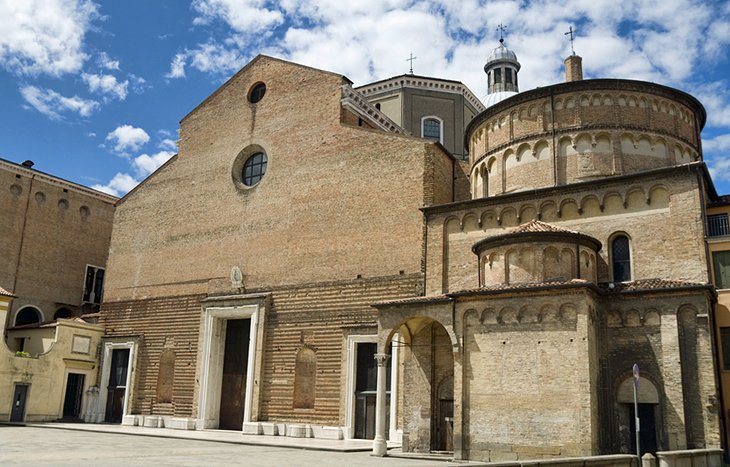
To the west of the Piazza dei Signori stands the cathedral, a High Renaissance building (1552-77) with an unfinished facade. Although the church is not a remarkable example, it is worth seeing for the paintings in the sacristy by Tiepolo and Bassano.
The baptistery, however, is outstanding. Built upon the remaining portion of a fourth-century church, its interior is adorned with a cycle of vibrant frescoes by Giusto de' Menabuoi, painted about 1375, scenes from the life of Jesus, Mary, and John the Baptist.
Address: Piazza Duomo, Padua
As home to one of the world's oldest medical schools, where so much medical history was made, Padua is a fitting place for a museum devoted to the history of medicine. This modern, interactive center has innovative exhibits along with static displays of medical instruments and historic teaching materials.
Knock on big virtual doors to reveal a screen where a life-sized leading scientist of the past - such as Galileo Galilei - tells about the discoveries of his own time. Although it's spoken in Italian, there are English translations here and elsewhere in the museum. Because of the variety of the exhibits, this is an attraction that appeals to all ages.
Address: Via San Francesco 94, Padua
Official site: https://www.musme.it/en
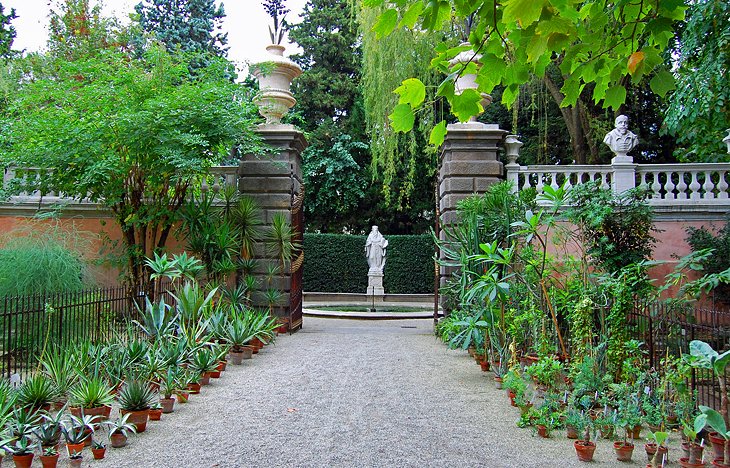
The botanical garden, founded in 1545, is the world's oldest existing academic botanical garden and the original of all the world's botanical gardens. It began as a way for students to identify true medicinal plants, to prevent mistakes and frauds in a day when healing relied heavily on herbs.
With additions from throughout Venice's sprawling overseas empire and from their trading ports beyond, the garden made Padua the leader in the introduction and study of exotic species. Today, it continues to be a resource for scholars, a place where the public can learn about plants and a center for preserving rare and endangered plant species.
Although details and decorative elements have been added, and a wall was built in 1552 to protect the precious plants from thieves, the elegant geometrical patterns of the beds that you see today are its original design.
Address: Via Orto Botanico 15, Padua
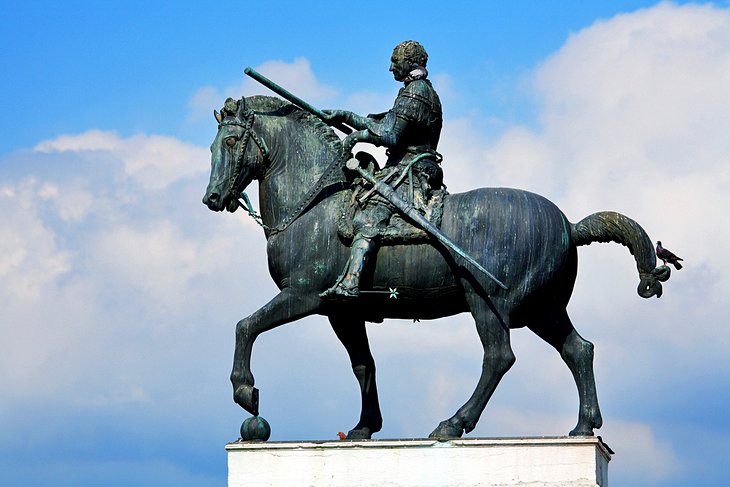
Stretching in front of the Basilica di Sant'Antonio is the large Piazza del Santo, with several other attractions. Beside the church stands the equestrian statue of Venetian army commander Gattamelata, the first monumental equestrian statue since the Roman era, created by the Early Renaissance sculptor Donatello, who worked in Padua from 1441 to 1453.
The Museo Antoniano houses the church's art collection. Climb to the upper floor of the Scuola di Sant'Antonio to see 17 heavily restored frescoes depicting the saint's miracles. In the adjoining Oratorio San Giorgio are more frescoes by Altichieri and Avanzi.
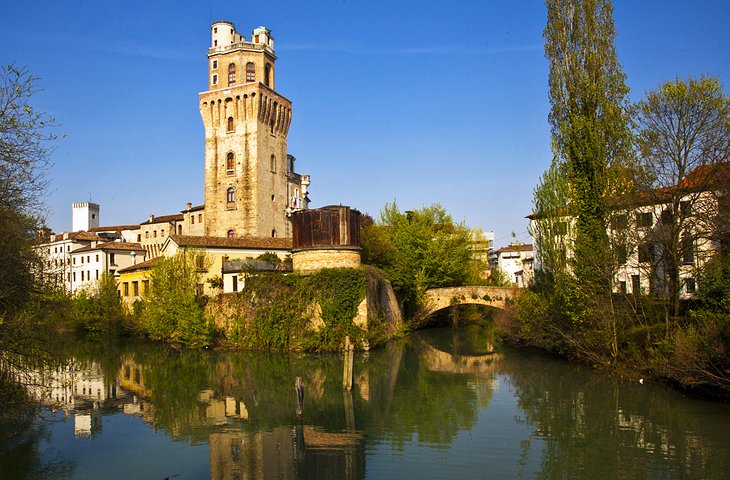
Padua's importance during the Middle Ages and Renaissance rested heavily on its university, founded in 1222. It was the first center of humanism and lead in medical sciences, astronomy, and physics. Galileo taught here, Copernicus studied here, and in 1678, the world's first university degree was awarded to a woman here.
On a tour, you'll see Palazzo Bo whose origins date to the 13th century, and where Galileo lectured in the Aula Magna (Great Hall). While at the university, he developed his law of accelerated motion and designed the first astronomical telescopic lens. The most unusual feature is the oval anatomical theater, the world's first, where students learned anatomy by witnessing dissections.
La Specola , the tower of an earlier castle, became the Astronomical Observatory in 1777 and today houses a museum with globes, telescopes, and instruments. In the Sala Meridiana is the largest sundial in Italy, constructed in 1779.
Address: Via 8 Febbraio, Padua
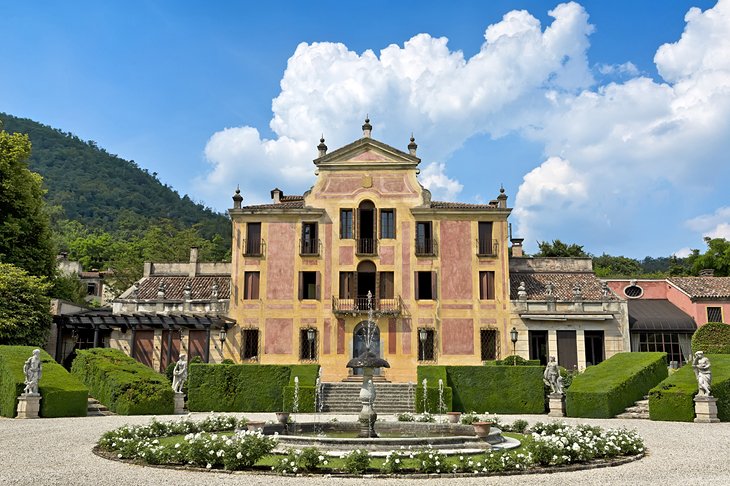
Southwest of Padua, the Euganean Hills (Colli Euganei) are a volcanic range rising abruptly out of the plain. They are known for their hot springs and the stylish spas that take advantage of their waters.
Best known of these is the world-famous thermal resort of Abano Terme , popular since the Romans soaked away their gout and rheumatism in its volcanic mud. Another hot springs spa is Montegrotto Terme , where the remains of Roman baths and a theater have been excavated.
These hills are filled with interesting places to visit. Just west of Abano Terme is the Abbazia di Praglia , a Benedictine abbey, founded in 1080 and restored in the 15th and 16th centuries, with a Renaissance church. The several cloisters include one with a garden of medicinal herbs. Another garden worth seeing, Villa Barbarigo , is farther south in Valsanzibio, on the way to the charming medieval town of Arquà Petrarca .
Address: Via Abbazia di Praglia 7, Bresseo di Teòlo, Teolo
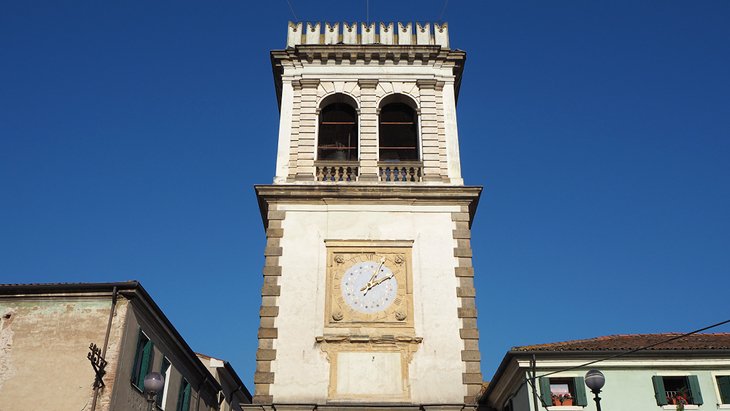
Southwest of Padua, the little town of Este was the seat of the powerful princely family of Este. The Museo Nazionale Atestino , in the former Palazzo del Castello or Palazzo Mocenigo (16th century), has excellent prehistoric and Roman collections. Adjacent is the 14th-century Castello Carrarese surrounded by massive walls.
The 18th-century Cathedral of Santa Tecla has a picture of the saint by Tiepolo in the choir. The image of the Blessed Virgin Mary of Grace s in the Baroque Basilica of Santa Maria delle Grazie , was brought here after the fall of Constantinople.
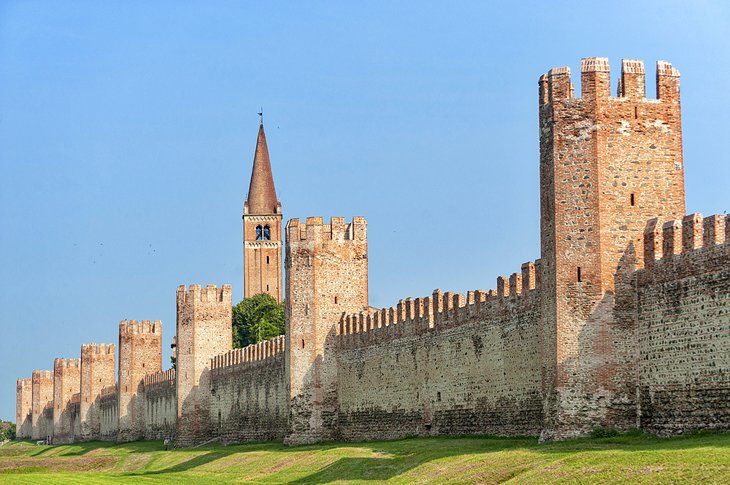
Farther west, Montagnana is surrounded by medieval town walls and 24 battlemented towers. You can best admire these by driving the ring road that circles the town. In the town center is a Gothic Romanesque cathedral from the 15th century.
Outside the Porta Padova, on the east side, is the Villa Pisani by Palladio (1555). Don't confuse this urban villa with the 18th-century Baroque Villa Pisani in Stra, mentioned above. This one has an urban street-side façade, although the side facing the gardens more resembles his country villas.
We recommend these hotels in Padua, near top attractions like the Basilica di Sant'Antonio and Scrovegni Chapel :
- Padova Suites C20 : Luxurious suites with views of the Duomo have a chic contemporary décor. Free public parking is nearby.
- NH Padova : Affordable rooms are in a high-rise hotel near the train station, with underground parking and a complimentary breakfast buffet.
- B&B Scrovegni : The value-priced bed-and-breakfast is in a 17th-century building, but the rooms are spacious and the showers large.
- B&B al Santo : This budget bed-and-breakfast has a home-like feel and welcoming hosts.
More Related Articles on PlanetWare.com
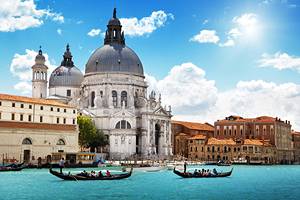
Places to Visit near Padua: If you haven't already seen Doge's Palace and other points of interest in St. Mark's Square , it's so easy to reach the attractions of Venice , that many tourists use Padua as an easy base for touring it. Just as easy to reach from Padua are the magnificent villas by Andrea Palladio, among the top tourist attractions in Vicenza. And if your itinerary doesn't take you to the ancient sites of Rome, a well-preserved Roman arena is located in Verona . Experiencing an opera performance here is one of the top things to do in Italy .
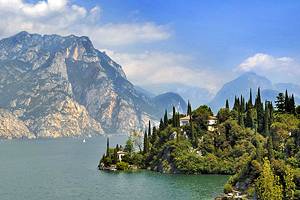
Exploring More of Northern Italy: North of Verona, you can drive or take a boat to see the castles and mountain scenery around Lake Garda and find more outstanding relics of ancient Rome in Brescia . The gardens in the Euganean Hills near Padua are just a teaser for some of the most beautiful gardens in Italy , which you'll find among the top tourist attractions of Lake Como . Look for more ideas for your travels in PlanetWare's list of best places to visit in Italy .
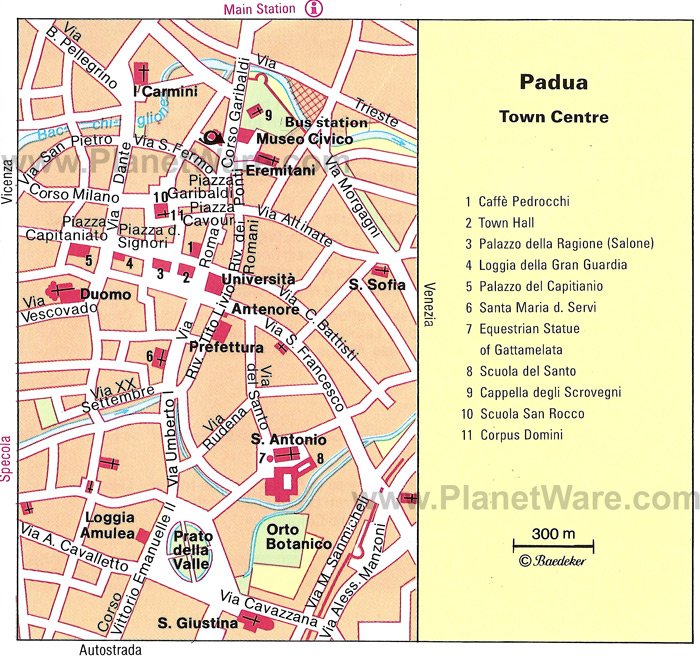
More on Italy


IMAGES
VIDEO
COMMENTS
2023. 1. Teatro Olimpico. 2,963. Theaters. Andrea Palladio's last work and masterpiece, the Olympic Theatre was commissioned in February 1580 by the Accademia Olimpica, a society of mixed social classes founded in Vicenza in 1555 for cultural and scientific purposes and to which Palladio himself belonged.
12. Cathedral. 13. Visit Villas around Vicenza. 1. Teatro Olimpico. Opposite the Museo Civico, the Teatro Olimpico was begun by Palladio in 1580 and completed in 1584 by Vincenzo Scamozzi, after Palladio's death. Built of wood and stucco, this is a Renaissance adaption of ancient theaters.
Vicenza is a small city in the Northern Italian region of Veneto. Often overlooked for the nearby tourist magnets of Venice and Verona, nevertheless, Vicenza has many sights and attractions to fill up a day trip or a longer visit with great experiences and unforgettable memories. The city's Roman roots go back to the 2nd century BC.
For the enthusiastic tourist, Vicenza has a huge amount of attractions to offer. Due to its extensive history and affiliation with various ruling empires, Vicenza has a myriad of beautiful historical structures such as the Basilica Palladiana, and some well-maintained public parks such as the Parco Querini.
IS VICENZA WORTH VISITING & WHAT IT IS KNOWN FOR. Even UNESCO deemed it very special - in 1994, the city (and its surrounding villas) was included on the UNESCO World Heritage Site list, making it a great weekend getaway destination or a visit-worthy stop on an Italy road trip.. Vicenza's main claim to fame is as 'The City of Palladio,' referring to the renowned architect Andrea Palladio.
2023. 1. Teatro Olimpico. 2,957. Theatres. Andrea Palladio's last work and masterpiece, the Olympic Theatre was commissioned in February 1580 by the Accademia Olimpica, a society of mixed social classes founded in Vicenza in 1555 for cultural and scientific purposes and to which Palladio himself belonged.
Housed within the palace is another of Vicenza's top attractions, the Museo Civica. Founded in 1855, the Civic Museum of Vicenza contains a vast collection of artifacts, archaeological finds, altarpieces, and artwork from the region. Van Dyke, The Four Ages of Man, 1625-27.
2023. 1. Teatro Olimpico. 2,957. Theatres. Andrea Palladio's last work and masterpiece, the Olympic Theatre was commissioned in February 1580 by the Accademia Olimpica, a society of mixed social classes founded in Vicenza in 1555 for cultural and scientific purposes and to which Palladio himself belonged.
Cortina d'Ampezzo. Discover the best attractions in Vicenza including Teatro Olimpico, La Rotonda, and Palazzo Leoni Montanari.
#8 Wander the historical center of Vicenza. Vicenza's historical center houses 23 buildings by Palladio. If you wish to see all of them, you can stop by the tourist information center and pick up a map. But even without a purpose, Vicenza's centro storico makes for pleasant wandering, with narrow streets and colorful facades.
4. Villa Valmarana ai Nani. 753. Historic Sites • Architectural Buildings. Admission tickets from AU$23.35. By 371oanac. The walk betwen the walls of this house is like a walk in a art gallerie. 5. Santuario della Madonna di Monte Berico.
Torre Bissara. Towering 82 meters above the Piazza dei Signori is the Torre Bissa, also known as the Torre di Piazza. The medieval tower is adjacent to the Basilica Palladina and was built in 1174 next to their palace. It was bought in the early 13th century by the Municipality of Vicenza, in addition to the palace.
2023. 1. Teatro Olimpico. 2,963. Theatres. Andrea Palladio's last work and masterpiece, the Olympic Theatre was commissioned in February 1580 by the Accademia Olimpica, a society of mixed social classes founded in Vicenza in 1555 for cultural and scientific purposes and to which Palladio himself belonged.
Vicenza, Italy: An Expert Travel Guide! The beautiful city of Vicenza in Italy is a real insider tip in the north of the country. Especially fascinating is the old town, known as a jewel of Venetian architecture, with many attractions and historical monuments.The charm of the city center is truly unique, and the Italian flair with its picturesque street alleys and squares is hard to beat.
Vicenza sits in northeastern Italy, in the Veneto region. It rests at Monte Berico's northern base. The River Bacchiglione runs through it. Vicenza is 60 kilometers west of Venice. It's also 60 kilometers east of Verona. This places it between two major tourist spots. It indeed serves as a perfect base for exploring Veneto!
The railway station is to the south-west of the town centre; most of Vicenza's attractions are clustered closely together inside the old town walls. Walking straight along Viale Roma from the railway station, you'll pass two bus stops for the number 8 - if you are planning a trip to the villas just outside town, check the latest timetable ...
The top attractions to visit in Vicenza are: Teatro Olimpico; Piazza dei Signori; Basilica Palladiana; Villa Valmarana ai Nani; Santuario della Madonna di Monte Berico; See all attractions in Vicenza on Tripadvisor
Interactive map of Vicenza with all popular attractions - Basilica Palladiana, Palazzo Chiericati, Monte Berico and more. Take a look at our detailed itineraries, guides and maps to help you plan your trip to Vicenza.
Things to Do in Vicenza, Italy: See Tripadvisor's 87,119 traveller reviews and photos of Vicenza tourist attractions. Find what to do today, this weekend, or in April. We have reviews of the best places to see in Vicenza. Visit top-rated & must-see attractions.
Just as easy to reach from Padua are the magnificent villas by Andrea Palladio, among the top tourist attractions in Vicenza. And if your itinerary doesn't take you to the ancient sites of Rome, a well-preserved Roman arena is located in Verona. Experiencing an opera performance here is one of the top things to do in Italy.
Lists Tourist Attractions in the Vicenza area, Italy. Home; Wish List; US$ Login; Register; Toggle navigation. Rent your vacation villa in Italy with us! 100% personally inspected Italian holiday homes and. a fanatic staff who'll make you scream "That's Amore!" [email protected] 1 800 509 8194. Search Villas ...